Invincible class
Invincible-class
The Invincible -class was the single largest multi-mission combat-equipped starship ever constructed by Starfleet . She was designed as the ultimate in front line explorers. She was classified as a Fleet Carrier - Command Battleship . Invincible -class ships combine the roles of battleship and fighter carrier, having a massive offensive capability in terms of on-board weapons and huge complement of tactical fighters.
At 1,607.2 meters in length, 764.4 meters across, and 305.76 meters high, it was the largest starship class ever built by Starfleet .
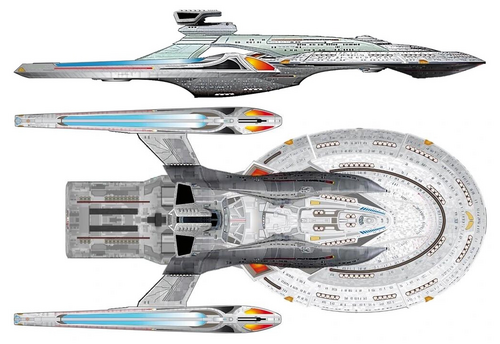
The Invincible class Command Battleship-Fleet Carrier.
- 2 Special features and capabilities
- 3 Vanguard Command
- 4.1 Offensive capabilities
- 4.2 Defensive capabilities
- 5.1 Tactical flyer group
- 5.2 Embarked escort ships
- 5.3 Standard auxiliary craft complement
- 6 Task force flagship role
- 7 Command and senior staff
- 8.1 Navigation Bridge
- 8.2 Flag Bridge
- 8.3 Flight Operations Bridge
- 9.1 Impulse drive
- 9.2 Warp drive
- 9.3 Quantum slipstream drive
- 10.1 Redundant bio-neural / isolinear Circuitry
- 10.2 Communications array
- 11 Emergency holographic complement
- 12.1 Astrometrics & stellar cartography
- 12.2 Science labs
- 13 Medical facilities
- 14.1 Accommodations
- 14.2 Mess lounges
- 14.3 Recreational facilities
- 15 Related links

Overview [ ]
Combining the abilities of a fully armed battleship, a full-fledged fleet carrier, and a mobile base of operations all in one massive platform, the Invincible -class of starship was the new flagship class of Starfleet . Designed as part of Starfleet's advanced technology starship program, the Invincible -class emerged from the dockyards in 2384 as the most sophisticated, most comprehensively armed, most impressive and the most advanced starship in Starfleet. This class of vessel was no doubt designed because of the Borg threat.
The hull configuration of the Invincible -class was comparable to other established Starfleet vessels, incorporating design characteristics of battle-proven designs. Her carrier features were considered to be the next step in carrier technology, as she was capable of carrying four (4) whole wings (four squadrons per wing, nine fighters per squadron) of tactical fighters into combat scenarios.
She was also capable of overpowering heavily armed enemy starships in one-on-one combat. The Invincible -class was currently one of very few Starfleet vessels that has enough firepower for any combat role, yet also carries the full capabilities of an exploratory starship.
She incorporates every weapons system known to Starfleet , supports triple computer cores and a twin type-D trelinium/dilithium hybrid reactor. With her 60 Decks on the primary and secondary hulls, 1,607.2 meter length, and full crew complement of 4,000, she was virtually a city in space. Only three ships of this class have been built.
Special features and capabilities [ ]
The Invincible -class was designed to provide military superiority in unstable regions. As such, it was well armed and self reliant, capable of handling all types of military situation, including fleet battle. The Invincible -class was equipped with Starfleet 's most advanced and most extensive weapons and defense systems. Constructed to explore uncharted space and to be able to stand toe-to-toe against any threat, it was a hard-hitting starship that was much more powerful than the Sovereign -class . Starfleet Engineering specified a long-range, multi-purpose fleet carrier-battleship that can capably function as a fleet command ship, as well as one that could penetrate enemy defenses and strike strategic installations with little or no escort. While fairly effective flying solo, the Invincible -class was devastating when operating as the center of a starship formation or a fleet. However, as Starfleet appears to be taking on the role of galactic police officer, it was also fitted for diplomatic purposes to hopefully stop conflict as it starts.
The Invincible -class merges the catamaran hull design of the Akira -class with the features of the fleet carrier-classes. It has three main hulls or sections: the primary hull, the secondary hull, and the tertiary hull . The Carrier Section was found in the secondary hull and was connected directly to the Saucer Section. The tertiary hull was composed of the ship's Catamaran and the wide roll bar carrying the sensor array and Catamaran superstructure.
The ship combines the maneuverability (both physically and mission-wise) of the Sovereign -class , the overwhelming firepower of the Achilles -class and Katana -class with their quantum mini-torpedo phalanx arrays and thick shielding, the ablative hull armor of the Defiant -class , the technological advancements and speed of the Prometheus -class , the bio-neural circuitry and borrowed regenerative and multiphasic shielding , and ablative armor plating technology found on the future Intrepid -class .
Vanguard Command [ ]
Only three vessels of the Invincible -class have been built by the Federation . All three were deployed as primary platforms of the three major fleets of Starfleet to "hot spots" where Starfleet Command was expecting a fight.
There was only one staship of this class assigned to the Vanguard Fleet and was its flagship. The Invincible -class Fleet Carrier - Command Battleship USS Invincible was the flagship of Task Force Invincible , the primary task force of the Vanguard Fleet .
Onboard tactical systems [ ]
The Invincible -class carried an extremely heavy torpedo complement. The phaser and torpedo firepower of the Invincible -class Fleet Carrier - Command Battleship makes it a powerful force in ship-to-ship combat. The ship’s weaponry systems consist of the most advanced phaser and torpedo systems available.
Offensive capabilities [ ]
The Invincible -class features 18 torpedo launchers . It has a total payload complement of 50 transphasic torpedoes , 750 quantum torpedoes and 1,500 high-yield photon torpedoes . It was also outfitted with 18 mini-torpedo phalanx arrays that face directly out, at 9 launchers each to port and starboard, with a complement of 3,600 quantum mini-torpedoes . Arranged this way, the phalanx arrays allow for an astoundingly high rate of fire that was able to cripple starships and ward off wings of fighters, while letting the ship keep its eye on its primary target.
The Invincible -class was also armed with 24 Type-XII phaser arrays , scattered in strips about the vessel to insure optimum firing arcs. These weapons have been improved since their debut on the Sovereign -class , including a 75% increase in beam output, a shorter firing time of .65 seconds, and a shorter recharge time of .2 seconds. The firing time was reduced to concentrate all beam energy to when the beam hits shield or hull, which exponentially increases overall efficiency and nearly doubles damage to shields. 12 forward triple-mounted Type-XII pulse phaser cannons and 12 rotary triple-mounted Type-XII pulse phaser cannons were also mounted, which have been similarly upgraded since their debut on the Defiant -class .
Defensive capabilities [ ]
The shield system of the Invincible -class was, quite simply, among the most powerful on any Starfleet ship. The design of the quadruple-redundant emitters provide regenerative features and to increase effectiveness against both high energy tractor beams and phased anti-muon (polaron) particles, measures clearly aimed at the Borg and Dominion respectively. Under normal operation, the shield modulation frequencies were controlled by the ship's computer system, which continually evaluates incoming weapons fire and automatically remodulates the shields to provide the most effective defense possible. It was thought that this system can also prevent beam-through by Borg transporter technology.
The Invincible -class utilizes a series of interlocking duranium - tritanium - tetraburnium poly-alloy truss frames for its space frame construction and hull. Instead of gamma wave welding, all ships of its class use transporter welding to create stronger joints. Its hull was also made of overlapping and regenerative ablative hull armor that allows it to take many direct hits from enemy fire even with minimal shields.
In addition, the class has been equipped with two armor generators that can deploy a thick layer made of ablative armor plating along the contours of the entire ship when activated. This can be done through the armor emitters that were installed at different points on the ship's hulls. Phaser arrays were covered by this coating, but torpedo systems remain uncovered.
This triple redundancy feature of shields and armor on the Invincible -class gives it a high degree of resistance to Borg and Dominion firepower. However, due to the huge amounts of energy needed to activate both the shields and the generated armor coating at the same time, the Invincible -class can only use all three simultaneously for several hours.
The Invincible -class 's hull was coated in microdiffracted carbon to absorb all visible radiation that fell upon it, making it as black as the space it moved through.
Carrier features [ ]
A primary feature of the Invincible -class was the arrangement of her flight decks. The ship has three flight decks. Aside from the flight decks, the secondary hull also houses equipment, locker rooms, offices, and other various services which the flight crews may need.
The two large full fly-through flight decks of the Carrier Section house the Invincible's Tactical Fighter Group composed of four wings, or a total of 16 squadrons. They run the width of the Carrier Section and have multiple bay doors at starboard and port sides, allowing for large numbers of simultaneous launch and landing operations.
Two wings of four squadrons each were housed in each of the flight decks. This was where all the fighters and equipment were kept. All fighter launchings and dockings take place here. These large hangars were capable of supporting and maintaining almost 144 tactical fighters, as well as several combat-equipped runabouts and shuttlecraft, including support facilities for all.
Tactical flyer group [ ]
The Invincible -class boasts of a complement of 144 Valkyrie -class advanced tactical flyers, divided into 16 squadrons of 9 fighters each. The vessel also has flyer and shuttlecraft construction and repair facilities onboard to keep support craft numbers at a constantly optimum level.
Embarked escort ships [ ]
Invincible -class capital ships are large enough to carry six escort ships, namely:
- Two Defiant -class Tactical Frigates docked in the underside of the ship's dorsal superstructure on recessed docking ports
- Four Valiant -class Tactical Corvettes housed in the hangar bay located aft of the saucer section, above the third flight deck of the ship and between the two large impulse engines.
These ships were deployed on the occasions when the Invincible -class was required to travel on solitary missions and without its permanent escort complement or attached task force. They served as permanent escort ships. Each had an assigned detail from the parent ship's main crew.

The Invincible class with its companion ships.
Standard auxiliary craft complement [ ]
The third flight deck located dorsal aft of the Saucer Section, below the ship’s superstructure, was where all auxiliary runabouts, non-tactical flyers and shuttles were kept. The Invincible -class was equipped with a complement of 48 auxiliary crafts of varying types, with support facilities for all:
- 8 Venture -class scout ships
- 8 Yellowstone -class runabouts,
- 8 Flyer -class heavy shuttlecrafts
- 12 Type-11 medium shuttlecrafts
- 12 Type-9 light shuttlecrafts .
Task force flagship role [ ]
Invincible -class starships were designed to serve as flagships of the largest task force formations of Starfleet . As such, she was accompanied by about 70 other combat-oriented starships during task force formations. Invincible -class starships were also one of only three ship classes in Starfleet with permanently attached companion ships.
Command and senior staff [ ]
Owing to their being task force flagships, Invincible -class starships have Commanding Officers that have the rank of Rear Admiral , while Executive Officers hold the rank of Commodore . Second Officers , Fighter Group Command Officers , and on occasions Chief Medical Officers hold the rank of Captain .
Flag facilities / Command Center [ ]
Another special feature of the Invincible -class were the full flag facilities with which it was equipped. Invincible -class starships serve as the flagships of the largest fleets of Starfleet. A primary flag facility onboard was the Flag Bridge , which was found in the middle portion of the Command Center .
Primary operational control of the task force, the ship and the tactical wings of the ship was provided by the Command Center , located at the top of the primary hull. The Command Center was ovoid in shape from aft to forward and was divided into three parts: the Navigation Bridge, the Flight Operations Bridge, and the Flag Bridge.
Navigation Bridge [ ]
The Navigation Bridge was primarily where the ship can be commanded. It directly supervises all primary mission operations and coordinates all departmental activities. It was located at the front most portion of the Command Center
- At the Navigation Bridge’s aft section was a large bank of control consoles that were programmable for a multitude of functions and data readout screens. Center of that area was the Master Systems Display . All relevant ship information (such as damage, power distribution, etc.) could be displayed on this cutaway image of the vessel. Above this whole section was the forward handrail of the Flag Bridge, separating the latter from the Navigation Bridge.
- The central area of the Navigation Bridge provides seating and information displays for the ship’s Commanding Officer and two command level officers. The command chair was slightly raised from the rest of the bridge officers to the height of the surrounding level. At the end of the armrests of the command chair were control panels with miniaturized status displays which could be used to override the basic operation of the starship. The two officer seats were also equipped with retractable and fully programmable consoles for a variety of uses.
- Directly aft of this area, integrated in the handrail encircling the aft section of the central command area were the three consoles of the tactical and security station.
- Directly fore of the central command area was the Conn Station and the seat of the Conn Officer , which face the main viewer. To the port side of the Conn Officer , also facing the main view screen, was the Operations Officer 's console, which was identical in size and design to the Conn Station.
- At the very front of the bridge chamber was a large view screen. When the screen was not active, a standard bulkhead was present. On the floor between the view screen and the helm control station was a holo communicator.
- Aft and to the port-side of the command area was an elevated platform on which the three consoles of the Engineering Station were located. This has a smaller cutaway diagram of the vessel, which shows all engineering-relevant data and shows warp fields and engine output.
- Aft and to the starboard of the Command Area was another elevated platform on which the three consoles of the Science Station were located.
- To the aft of both Science and Engineering Stations were two identical command consoles that could be operated to perform more bridge duties. Aft of these were the passageways that lead to the Flag Bridge and the Flight Operations Bridge beyond.
Flag Bridge [ ]
The Flag Bridge was the nerve center of the task force led by the Invincible -class . It was where coordination between task force elements and planning for task force movements were done, whether in squadron formation, in mission group formation or in strike group formation. It was located in the middle of the Command Center , separated from the Navigation Bridge in front and Flight Operations Bridge in the rear by port and aft doors. As the sector command hub whenever the flag officer was onboard, it was a combination briefing room, operations center and workplace from which the flag officer could keep a weather eye on the ships of the task force and on the situation over dozens of star systems under the flag officer's command. It was dominated by a large, oval holotable, with virtual panes hanging suspended in the air above it and a gesture-sensitive interface.
- At the aft wall of the Flag Bridge was the Master Systems Display of the whole task force and the whole sector.
- The central area of the Flag Bridge provide space for the Fleet Operations Table, a large oval-shaped console which can display above it a three-dimensional image of any region in space where ships of the task force were located. It can also serve as a holo-communicator.
- Directly on the aft side of the Fleet Operations Table was the seat of the ship’s flag officer .
- Directly on the fore side of the Fleet or Sector Operations Table was the seat of the Fleet Operations Officer who was responsible for monitoring and working the fleet operations table.
- To the portside of the central area were two fleet control consoles, one intelligence console, and one mission ops console. Fleet control consoles convey the flag officer ’s orders to the ships of the task force and receive messages intended for the flag officer.
- To the starboard of the central area were two more fleet control consoles, one long-range sensor console, and one mission ops console.
Flight Operations Bridge [ ]
The Flight Operations Bridge was where the ship’s complement of flyers and auxiliary crafts were directed from. It directly coordinates the movement of the ship’s flyers and support crafts in mission. It was located aft of the Command Center . The Flight Operations Bridge was supported by at least two Flight Deck Control Centers located at the flight decks.
- At the aft wall of the Flight Operations Bridge was the flight deck and hangar bay systems displays. On either side were control consoles for hangar bay operations.
- The central area of the Flight Operations Bridge provide seating and a console for the ship’s Fighter Group Command Officer , the Flight Operations Command Chair.
- Directly fore of the central area were the four mission control consoles facing the flight ops viewer, at two to portside and two to starboard.
- Aft and to the portside were two of four flight deck control consoles.
- Aft and to the starboard were the other two flight deck control consoles.
- At the forward wall of the Flight Operations Bridge was a holographic wall screen which could display fighter and support craft locations and movements within a given stellar region in three dimension.
The three bridges of the Command Center were connected to each other by doorways on the port and starboard side to allow for easy access between the three parts of the Center. On the portside of the Command Center were three glass-walled ready rooms: one for the flag officer , one for the ship's commanding officer and one for the fighter operations command officer. On the starboard side of the Command Center was the long briefing lounge which features a long table and seating for the senior staff of the three bridges. This can be separated by glass walls if the senor staff of each bridge neede privacy.
Propulsion systems [ ]
The propulsion system onboard ships of this class were state-of-the-art. The class boasts of the best navigational sensors and among the highest rated top speed of any Starfleet vessel.
Impulse drive [ ]
The impulse drive system of the Invincible -class was the most sophisticated model in production. Her oversized impulse engines were equipped with impulse thrusters that provide superb sublight maneuvering speed, especially considering her size. With this design, along with the new retro-thrusters, and uprated structural integrity fields give the ship maneuverability equal to the size of a Steamrunner -class vessel.
Warp drive [ ]
The ship’s matter-antimatter reaction assembly warp core was the most powerful in Starfleet . The warp core spanned 20 decks just behind the center line of the primary hull. Its warp drive featured a quadri-cyclic input manifold and was designed to operate for up to 5 years before refueling. The ship's warp engines were based on a new concept in warp drive design, one which eliminates subspace distortion effects inherent to standard warp drives . The reaction chamber was equipped with a compositor, which allowed recrystallization of dilithium . The deuterium tanks were above the core, while antimatter storage pods surrounded the base of the core.
A Class-9 warp core was located aft of the primary warp core and spans 7 decks and brought online when the primary warp core was offline. This allows the ship to travel at a cruising speed of warp 6 while the primary warp core was offline.
Equipped with the enhanced warp drive system of the Khronnians , the Invincible -class can now safely attain and indefinitely sustain a normal cruise speed of Warp 8.5, a maximum cruise speed of Warp 9.5 and a top speed of Warp 9.99 sustainable for up to twelve (12) hours.
Quantum slipstream drive [ ]
The Invincible -class was equipped with a quantum slipstream drive in addition to its primary and secondary warp drives , located adjacent to the warp drive . This allows the ships to travel 300 light years in an hour. The systems installed as part of the slipstream drive included a quantum field focus controller at the front of the ship's main deflector and a chroniton integrator; the latter of which could be used to take sensor readings several seconds into the future when the ship was using its slipstream drive.
Computer systems [ ]
The Invincible -class starship was equipped with some of the most advanced computer systems of the time. The ship carries four independent computer cores. These multiple cores provided redundancy in case one of the cores was damaged or destroyed. The main computer processor was capable of simultaneous access to 47 million data channels, of transluminal processing at 575 trillion calculations per nanosecond, and having operational temperature margins from 10 ° to 1790 ° Kelvin. The bio-neural circuitry sped up the computer's data functions and improved overall performance.
Redundant bio-neural / isolinear Circuitry [ ]
The ship’s size allow it to be fitted with both bio-neural gel pack and isolinear computer interfaces and circuitry. The bio-neural circuitry enables high-speed information transfers and the newest sensor equipment with efficiency levels that exceed that of the Galaxy -class by 100%. The isolinear circuitry provides for redundancy, allowing the ship’s computer systems to continue operating in the event that the bio-neural circuitry were affected by viruses and infectious agents encountered in deep space.
Communications array [ ]
In its role as a command ship, the Invincible -class 's advanced communications array allows the embarked flag officer to relay battle-critical information instantaneously.
Emergency holographic complement [ ]
This class was equipped with holo-emitters on every deck to allow emergency holographic programs a higher level of access and free movement around the ship. The ship’s computer systems can simultaneously bring online an extended Long-term Holographic Program Package composed of:
- 3 Mark-III Long-term Command and Navigation Holograms (LCNH)
- 4 Mark-III Long-term Security and Tactical Holograms (LSTH); 1 Gorn , 1 Pahkwa-thanh , 1 Hirogen , 1 Brikar .
- 6 Mark-III Long-term Engineering Holograms (LEH)
- 3 Mark-IX Long-term Medical Holograms (LMH)
- 3 Mark-III Long-term Health Care Holograms (LHCH)
- 3 Mark-III Long-term Science Holograms (LSH)
Science features [ ]
Also designed to go for extensive periods on deep space exploratory duties, the Invincible -class was equipped with cutting-edge scientific equipment.
It also serves as a testbed for experimental science technology not yet available in most other classes. State of the art computers give it unprecedented storage capacity, access speed, and rigorous conditioning. Combined with a wide array of sensors on the dorsal superstructure and covering a large amount of the exposed surface, makes the Invincible -class a premier ship of the line for Starfleet ’s scientific endeavors.
Astrometrics & stellar cartography [ ]
The Invincible -class also boasts of four large Astrometrics labs and one Stellar Cartography Department, which was not only dedicated to the science and practice of charting space, but could also be used for long-range communications purposes or even, as a workplace for easy access to sensor information. It features a holotank which allows a person to gain a 360° panoramic view of an area using holographic technology. There were a series of control panels to manipulate the screen. The area below the screen and in front of the control panels could be used as a stage during presentations. Astrometrics also include 8 additional workstations on the side walls.
Science labs [ ]
There were 35 science labs on the Invincible -class . 20 were non-specific labs were easily modified for various scientific endeavors including Bio/Chem, and Physics tests and/or experiments. 15 were specific labs on Planetary Development, Geologic Studies, Languages/Archaeology, XT (extra-terrestrial) analysis, Eugenics, Biologics Laboratories, Atmospheric Physics experiments, and High-Energy Physics. There were also 5 smaller labs which can be configured for astrophysics/astrometrics and stellar cartography studies. Science Department crews rotate often among these laboratories. The Chief Science Officer's office was attached to this bank of labs.
Medical facilities [ ]
There were 3 large sickbay facilities located onboard the Invincible -class : Command Sickbay, Main Sickbay and Flight Deck Sickbay.
Command Sickbay has 3 intensive-care biobeds, 3 medical laboratories, 10 standard biobeds and the Chief Medical Officer's office.
Main Sickbay has 3 dedicated surgery suites, 2 medical laboratories, a physical therapy facility, a null-gravy therapy ward, and 16 standard biobeds.
Flight Deck Sickbay also has 3 dedicated surgery suites, 2 medical laboratories, a physical therapy facility, a null-gravy therapy ward, and 16 standard biobeds.
Also pursuant to new Medical Protocols, all Primary Medical Facilities were equipped with holo-emitters for the usage of the Emergency Medical Hologram System.
Crew facilities [ ]
The Invincible -class boasts standard crew quarters and recreation facilities for its 4,000 crrew complement.
Accommodations [ ]
Because of its combat oriented features, crew berthing facilities on this ship class were comparable to that of an Intrepid -class . Quarters in general were smaller than those of other large Federation vessels, such as the Sovereign -class . With emphasis towards the tactical and fighter carrier systems being the priority in the vessel designers' minds, ensigns , non-commissioned officers and crewmen had to share their quarters with at least one other crewmate during normal times of operation. Each shared cabin for crewmen had four stacked bunks, one replicator port, a small living area, and a twin bathroom. Each shared cabin for ensigns and non-commissioned officers had two small bedrooms, one replicator port, a living area, and a twin bathroom.
Officers of the rank lieutenant junior grade and lieutenant were given their own quarters, which included a living area with work station, a small bedroom and a bathroom. Senior officers’ quarters were larger than junior officers’ quarters and lined the edge of the saucer section and usually have windows.
Meanwhile, the quarters of the embarked flag officer , the executive officer and the fighter group command officer were equivalent to the captain ’s quarters onboard an Intrepid -class starship.
Mess lounges [ ]
There were 10 large mess halls and 5 smaller mess lounges onboard that were equipped with full bar and kitchen facilities, each managed by a Mess officer , with a private captain's dining room just behind the mess lounge , all served by windows that offered a spectacular view of space outside. Eating accommodations were provided by a slew of tables and chairs. The larger mess halls can occupy 100 diners at a time, while the mess lounges can occupy 32 diners at a time. Each mess area has a very relaxed and congenial air about it. At the head of the hall were open slots that served as dispensers for the replicators . The mass-use replicators were able to produce other food and non-alcoholic beverages with an extensive recipe listing from over two hundred worlds for the crew to enjoy in this relaxed social setting. The most notable accessory to the lounge was a modest-sized bar area, offering a wide selection of synthetic and alcoholic. To conserve replicator rations, the mess halls ’ menu was supplemented with food stocks of vegetables cooked by the mess officers from the airponics bay and hydroponics bay, along with food obtained from trading and scouting missions. In addition, the mess lounges can double as large meeting areas that could be used to conduct crew briefings and mission profiles. A tall screen panel located on one of the walls can be used as a visual aid to display graphics.
Recreational facilities [ ]
16 standard holodeck facilities and 32 holosuites were scattered all over the ship. The facilities of 8 gyms on the Invincible -class were not only spacious, but were also well outfitted. The facilities include variable weight machines, isometric machines, and calisthenic machines and a sparring ring configured for Anbo-Jytsu but easily modified and/or expanded for other practices. All equipment was equipped with the ability to variate gravity for those species that were physically biased toward higher or lower than standard gravity.
Related links [ ]
- List of Vanguard Command starship classes
- List of Invincible class starships
- 1 Invincible class
- 2 Diligent class (Vanguard)
- 3 William V of the United Kingdom
Star Trek: 8 Most Powerful Federation Starships, Ranked

Your changes have been saved
Email is sent
Email has already been sent
Please verify your email address.
You’ve reached your account maximum for followed topics.
Star Trek: Best Movie Villains, Ranked
Star trek: most iconic klingons, ranked, star trek: 10 starfleet admirals who went rogue.
The Star Trek franchise is an extremely long-running one, with so many shows and movies that it can be hard for fans to keep track of everything that has happened. This becomes even truer when trying to discuss the most powerful ships that have been seen in the franchise.
The Star Trek movies have quite a few great villains, but which one is the best?
Between different timelines, leaps into the past and future, and mysterious vessels like the Borg cube, the Star Trek franchise has portrayed some incredible space-faring vessels. But the Federation starships are almost always the ones that triumph in the end. These ships have gotten pretty powerful over time, showing that no matter how much things change , they stay the same.
Updated on March 9, 2024, by Chris Harkin: The Star Trek franchise is ever-growing, despite there being a cinematic lull, several shows continue onwards as the franchise continues exploring many new eras and re-treading ground on some old ones. As such, the Federation is likely to continue releasing new ship brands, continuing to boldly go where no man has gone before. As the franchise continues to update, particularly with more futuristic capabilities attached to new classes of Starship, this article will continue updating and growing to signify the changes in the long-running franchise.
8 Inquiry Class
Active from the 2390s onward.
- Appeared In Star Trek: Picard (6 Episodes)
Heavy cruiser ships that were introduced only recently in Star Trek: Picard, the Inquiry Class are one of the newer brands of Federation Starship. Considered the new cream of the crop, these ships were the fastest available to Starfleet at the conclusion of the 24th Century.
Coming with a generally similar design to many previous classes of Starfleet class ships, the Inquiry Class contained the USS Zheng He and other ships that opposed a Borg Cube in 2401 and were shown at other points throughout Picard , proving them to be the main body of Starfleet's major active ships at that time.
7 Prometheus Class
Active from 2370s to 2380s.
- Appeared In Star Trek: Voyager (2 Episodes)
One of the strangest designs seen in a Starfleet vessel, the Prometheus Class ship, was seen in Voyager as a highly classified experimental ship that only four people in all of Starfleet knew how to command and control. Not only was this ship brutally fast, but it could also split into pieces.
The Prometheus Class, though it doesn't seem to have become common, was capable of splitting into three pieces, each capable of attacking enemies independently. Capable of surpassing speeds of warp 9.9 and featuring regenerative shielding, this class was highly unusual but also incredibly useful.
6 Akira Class
Active from 2370s to 2400s.
- Appeared In Star Trek: Deep Space Nine (9 Episodes)
- Appeared In Star Trek: First Contact
The Akira Class of Federation Starships is a mighty one, and unlike most starships under Federation control, it was made with the thought of war in mind. During production, the hostilities with the Cardassian Union prompted the creation of a speedy battleship. However, during the creation of the Akira Class, the Federation became more aware of a potential Borg invasion and sped things up.
Brought into service in 2368, the Akira Class has been seen in Deep Space Nine and Star Trek: First Contact . Examples of this ship type include the USS Akira, USS Geronimo, and even the USS James T. Kirk. Major differences from other Federation ships include a high number of torpedo bays and a large shuttle bay, which enabled the Akira Class ships to be fighter carriers.
5 Defiant Class
- Appeared In Star Trek: Deep Space Nine (68 Episodes)
The Defiant Class and the USS Defiant also had an intriguing build history. Initially, these ships began construction during the Borg threat, but when this was lessened, they were put away until the Dominion threat became a fresh problem for Starfleet. Despite initial design flaws, DS9 ’s Miles O’Brien was able to fix the USS Defiant enough to make it ready on a high level.
This caused the Federation to start building more ships to follow the USS Defiant, and thus the Defiant Class was born. These ships are small, highly powered, and heavily armed. They remain warships, the first ones ever created by Starfleet, and were introduced in the year 2371.
4 Galaxy Class
Active from 2360s to 2400s.
- Appeared In Star Trek: The Next Generation (All Episodes)
- Appeared In Star Trek Generations
As if the Galaxy Class needed any more praise, the USS Enterprise-D ship flown by Captain Picard and his amazing crew throughout Star Trek: The Next Generation was a member of this class. The many achievements of Picard and his crew boil down to their tenacity, but the strength of the Galaxy Class Federation starships is not to be ignored.
A well-used ship by the Federation during the heavy losses of the Dominion War , the Galaxy Class is a heavy capital ship class that came into being in the mid-2360s. Unlike some of the Federation’s other most impressive and powerful ships, the Galaxy Class managed to be an all-in-one, with the capability to wage war, but a crew tasked with preventing it. Discovery and war, speed and majesty, the Galaxy Class has it all.
3 Sovereign Class
- Appeared In Star Trek: Picard (5 Episodes)
- Appeared In Star Trek: Insurrection & Star Trek: Nemesis
The Sovereign Class was a follow-up to the Galaxy Class in many ways. This includes the fact that Picard’s follow-up ship, the USS Enterprise-E, was a member of the Sovereign Class. Judging solely from the ability of the Enterprise-E to take down the Borg Cube it destroyed in Star Trek: First Contact , it is safe to say the Sovereign Class was a worthy update to the Galaxy Class.
Star Trek introduced fans to some fascinating alien species, but the Klingons are one of the most popular with viewers
Smaller in design and released in the early 2370s, the Sovereign Class was a major upgrade from previous classes in terms of warfare, including photon and quantum torpedoes as well as a large volume of phaser banks.
2 Curiosity Class
Active from the 2390s onwards.
- Appeared In Star Trek: Picard (4 Episodes)
This ship has only recently made its entrance into the Star Trek universe. The Curiosity Class was introduced in Star Trek: Picard as the new wave of Federation starships. Released initially in 2389, ships such as the USS Curiosity and the USS ibn Majid are included in this class, which was primarily meant to replace the aging Galaxy Class vessels.
A mix between a heavy cruiser and an explorer ship, the Curiosity Class will be able to do everything that the previous main Enterprise ships were. Ready for diplomatic missions, discovery missions, and if all else fails, combat missions as well, the Curiosity Class is the next generation of Starfleet technology, which pushes beyond anything seen in Star Trek outside the new seasons of Discovery .
1 USS Vengeance (Dreadnought Class)
Active 2259 (alternate timeline only).
- Appeared In Star Trek: Into Darkness
The USS Vengeance, seen in Star Trek: Into Darkness , is a very special case. Despite the technology being old in comparison to many ships in The Next Generation and other shows , this was one of the few Federation ships ever made purely for war. With the unholy pact that Khan made, helping to design this ship, and his heightened intellect, Starfleet was able to secretly create one of the largest and the single most destructive forces in Starfleet's history .
Whether this is actually more powerful than the starships created over a hundred years later is hard to say for certain, but Starfleet has yet to put any ship together that is so brutally focused on combat. The capability of this ship to be armed and operated by a single man is also a terrifying notion. It enables one person to go rogue and operate one of the more deadly forces in the universe alone. If not for the quick thinking that enabled the crew of the rebooted Enterprise to destroy it from within with a huge payload of torpedoes teleported to the inside, this ship might never have been beaten .
The higher-ups of Starfleet command often pose a challenge to Star Trek's main characters. Not all the series' admirals play by the rules.
- Movies & TV
- Entertainment
From TOS to Picard: 40 most powerful Star Trek spacecraft, ranked
It's Enterprise vs. Borg cube time. From the Captain Kirk days to Deep Space Nine, Enterprise to Picard, we've ranked all the greatest ships. Resistance is futile!

This is what we call Enterprise reporting ...
Belt up: We've ranked 40 iconic Star Trek ships, probes and shuttles from the (relatively) least powerful to the (overwhelmingly) most powerful.
Our rankings are based on specs culled from StarTrek.com and Memory Alpha. The crafts have been assessed for their speed, size and ability to assert their will via either weaponry or overall world-destroying power. Craft from both the prime and Kelvin timelines were eligible for consideration, provided they belong to the Star Trek canon, which extends from the original Star Trek TV series to CBS All Access' Star Trek: Picard .
Warp speed ahead for the rankings!
(Disclosure: CBS is CNET's parent company.)
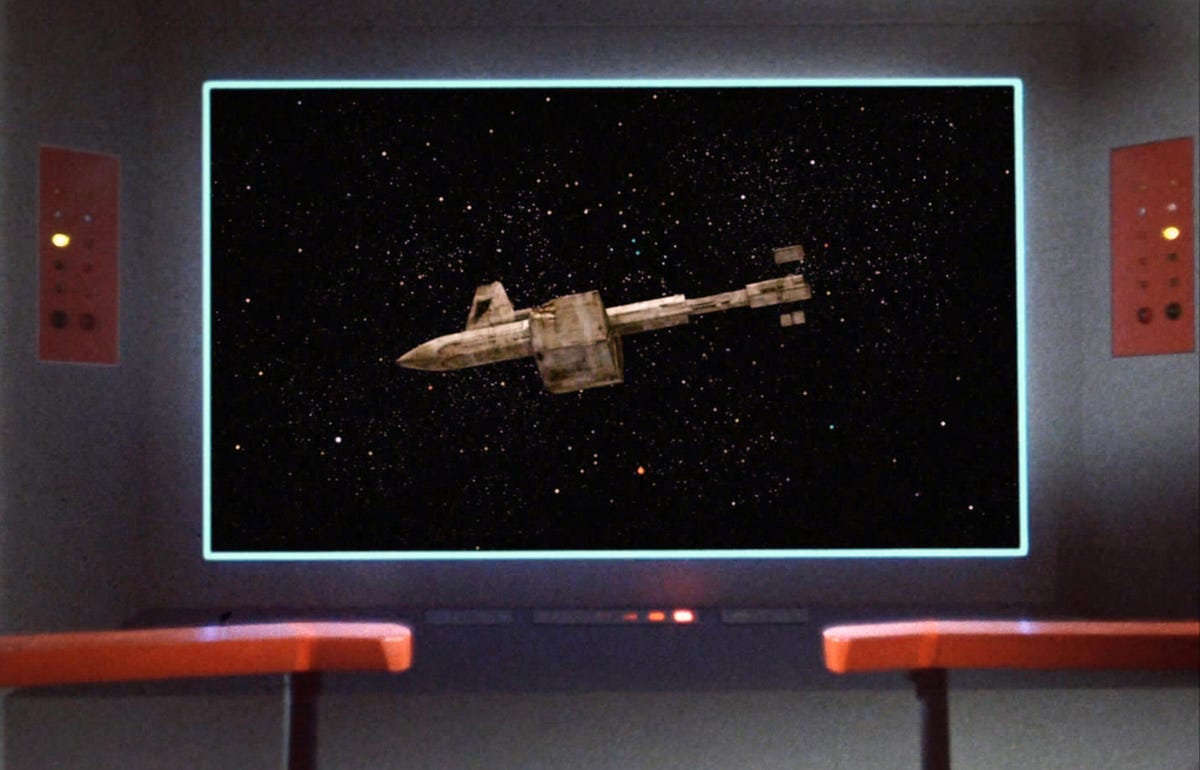
40. SS Botany Bay
Viewed on the screen of the USS Enterprise (NCC-1701) from the prime timeline of Star Trek the original series, the fun-sized Botany Bay is a pre-warp, 20th-century DY-100 class vessel from Earth. It's most famous for its de-facto captain, the genetically modified strongman Khan Noonien Singh, better known in Captain Kirk-speak as " KHAAAAN! "

39. Phoenix
The Phoenix may be a primitive ship, but it's über - important. Per the Star Trek canon, and as seen in Star Trek: First Contact , Zefram Cochrane's and Lily Sloane's refashioned nuclear missile is the first Earthling craft to use warp drive -- and achieve first contact with an E.T. species, the Vulcans.
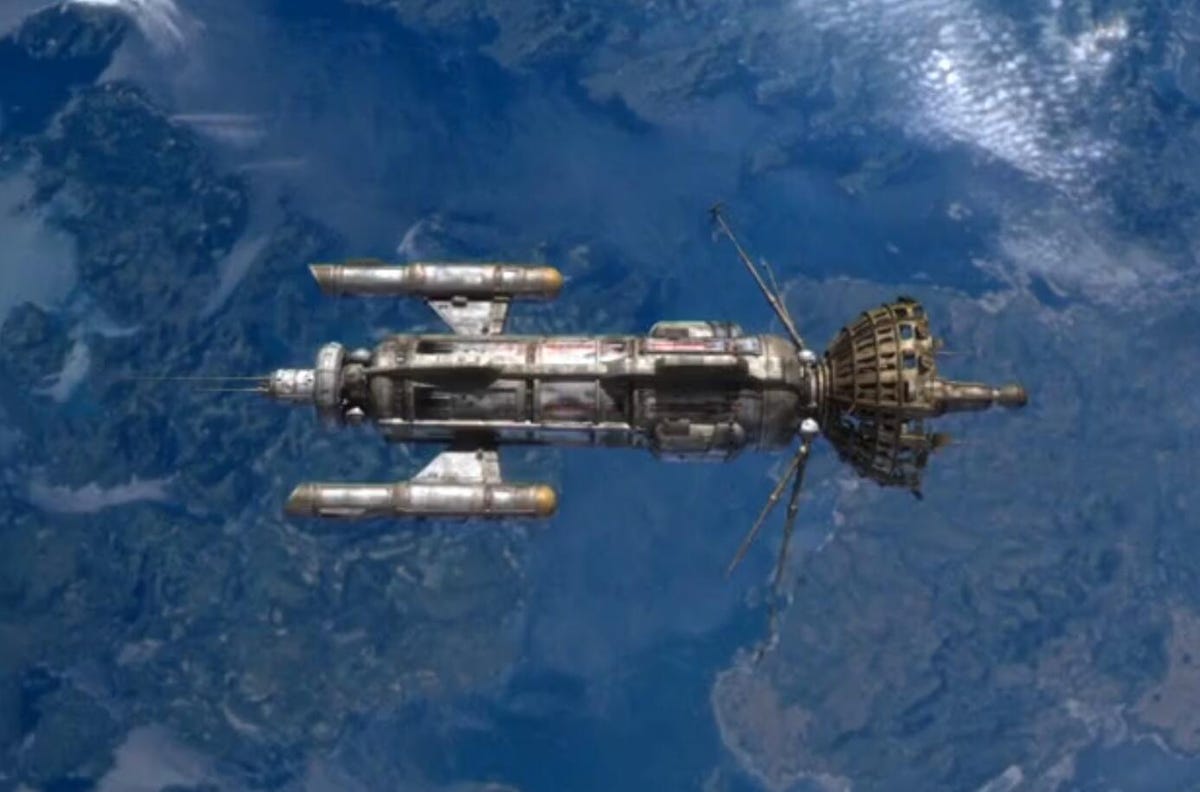
38. Friendship 1
As we learn in a Star Trek: Voyager episode, this deep-space probe is launched in 2067 -- or, four years after the Phoenix's game-changing flight. It represents Earth's early desires to seek out new worlds and new civilizations.
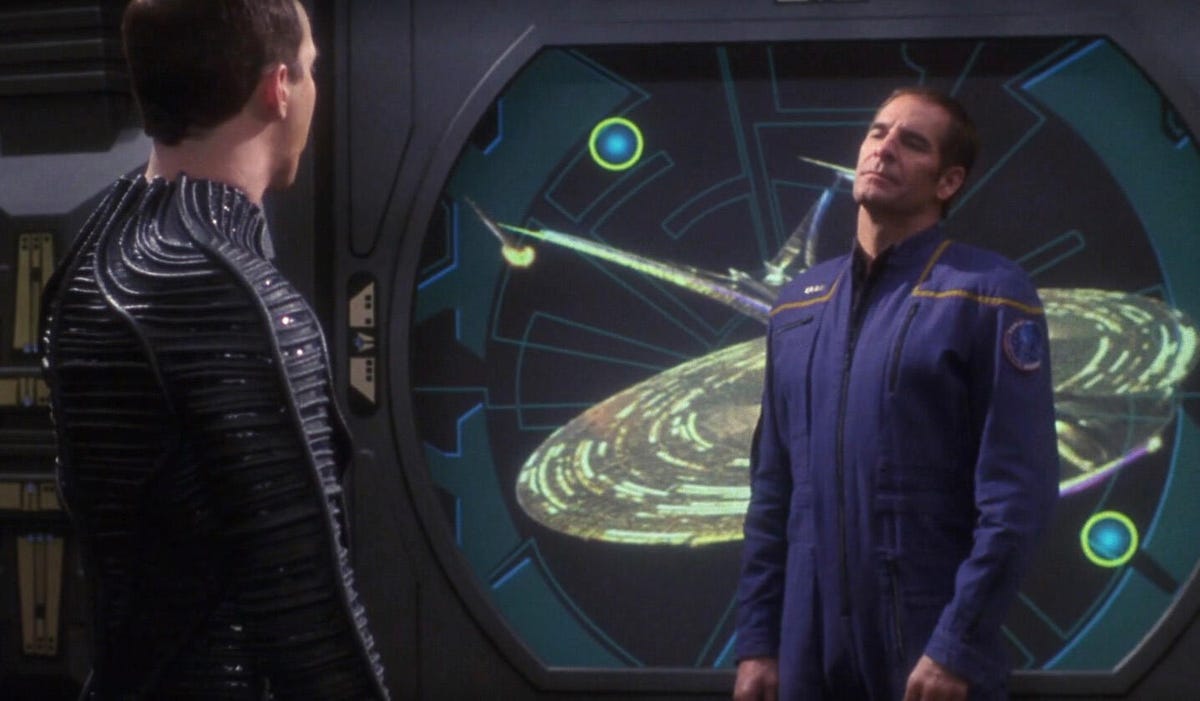
37. USS Enterprise (NCC-1701-J)
This 26th-century, Universe-class Federation starship, called a "distant relative" of the Enterprise (NX-01), is glimpsed in the Star Trek: Enterprise episode, "Azati Prime."
Owing to its presumed advanced tech, it should vie for a top spot on this list. But it's at the back of the pack because, one, it is only briefly glimpsed, and, two, a time-traveling Captain Jonathan Archer is told the Enterprise-J exists in a possible future timeline.
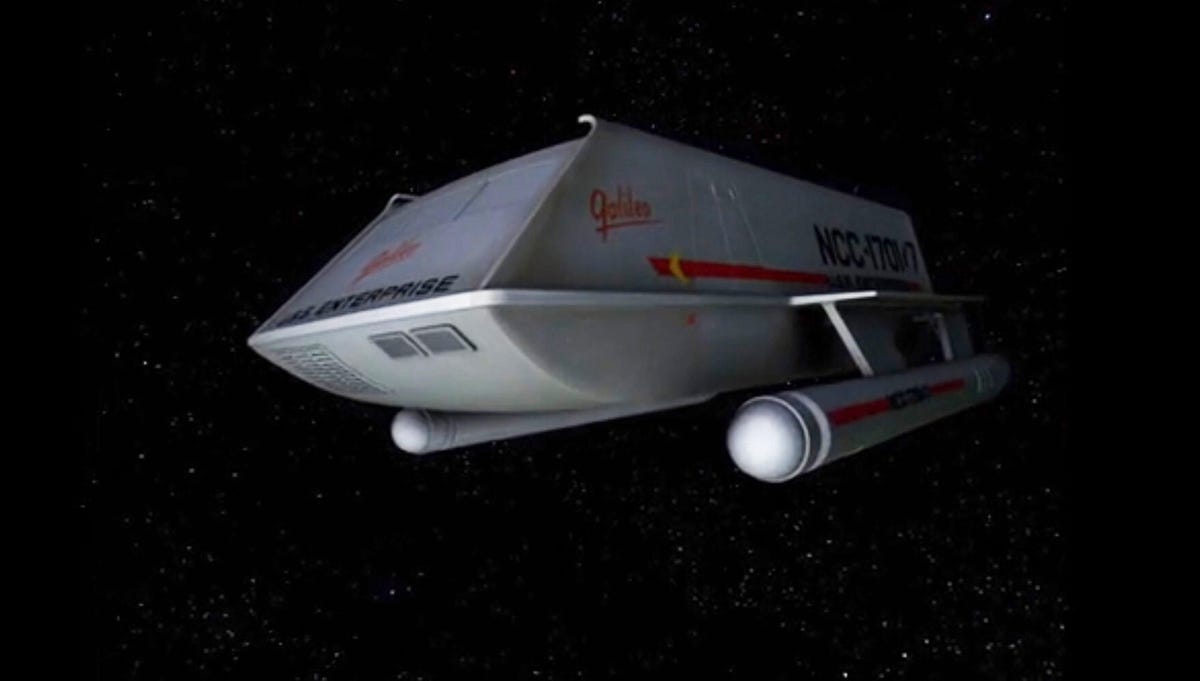
36. Galileo (NCC-1701-7)
What this Class F shuttlecraft of the prime-timeline's Enterprise lacks in photon torpedoes, it makes up in significance: It is the focal point of the beloved Star Trek original-series episode, " The Galileo Seven ," the original prop from which was on display at the official visitor center for NASA's Johnson Space Center.
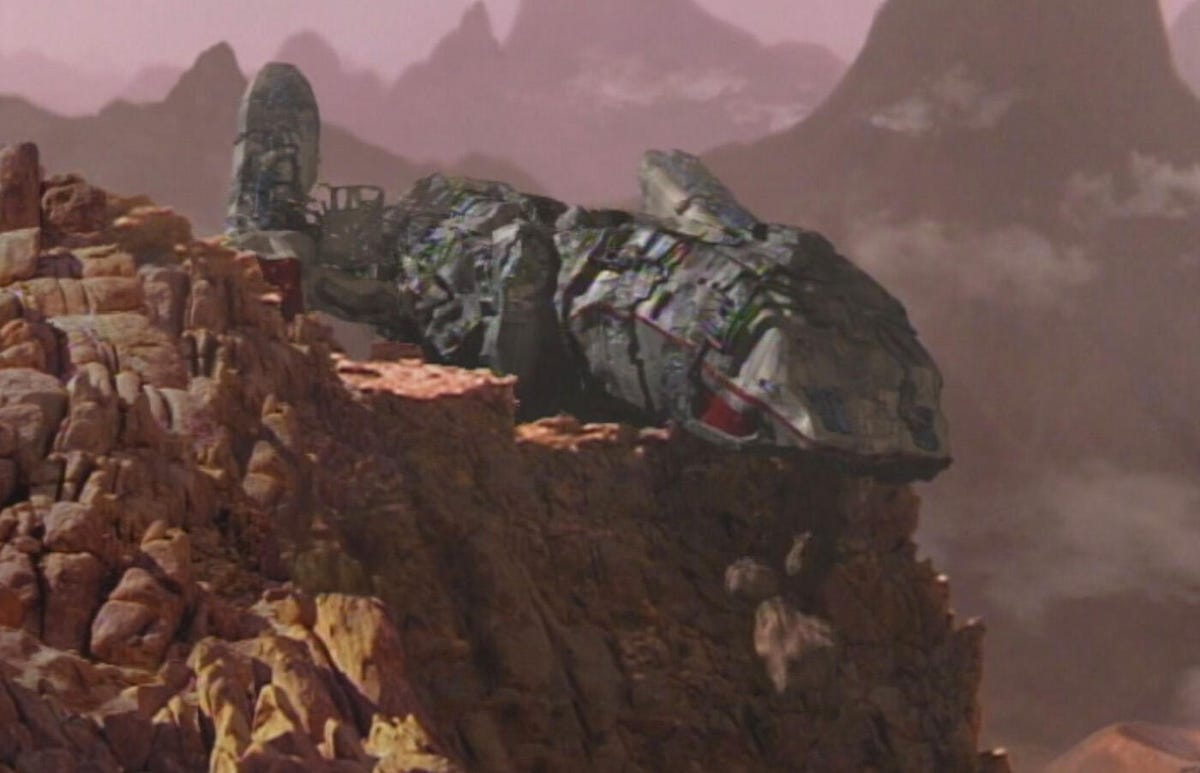
35. USS Raven (NAR-32450)
The remains of this Federation starship are seen in the Star Trek: Voyager episode, "The Raven." In better days, the exploration vessel was the home -- and workplace -- of the Borg-studying scientists Magnus and Erin Hansen. Per StarTrek.com, the couple and their young daughter, Annika, the future Seven of Nine , are considered "perhaps the first [humans] to be assimilated" by the Borg.
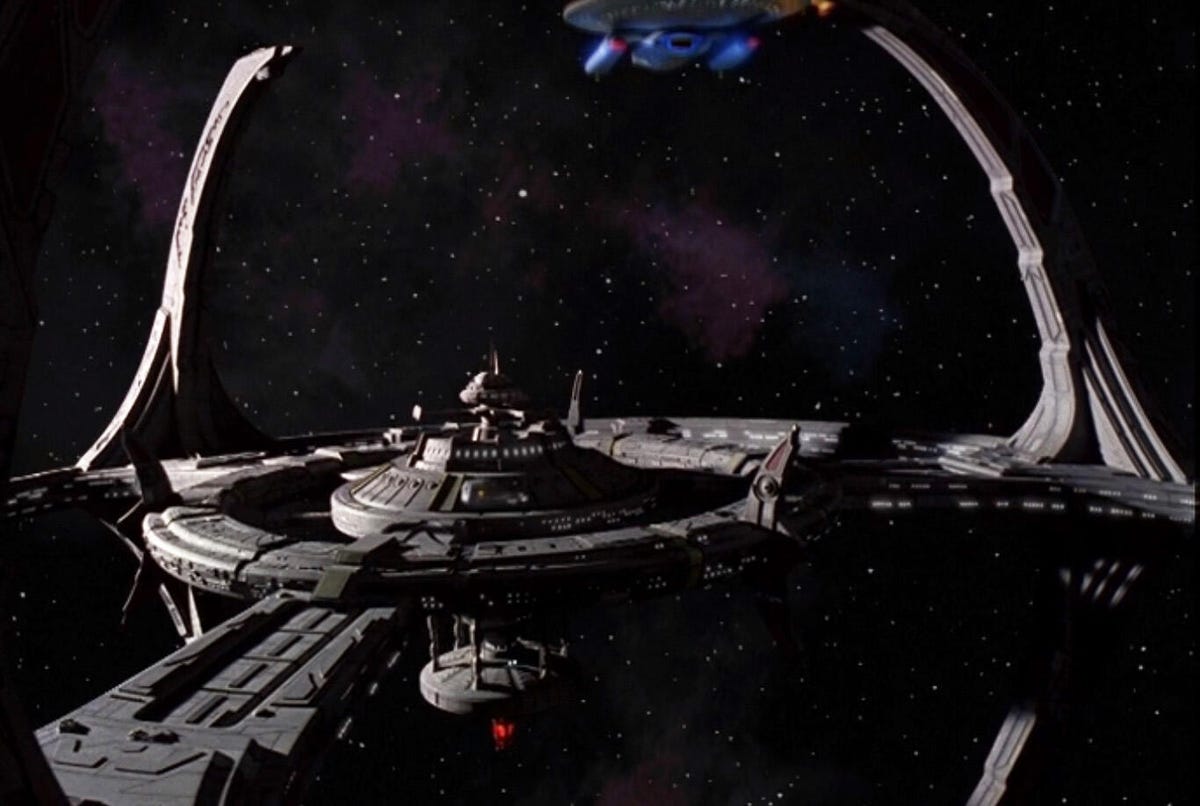
34. Deep Space Nine
On one hand, Deep Space Nine, the setting for the same-titled TV series, is just an old Cardassian mining station. On the other hand, it's an old Cardassian mining station that, by Season 4 of Star Trek: Deep Space Nine , is retrofitted with 5,000 photon torpedoes. Klingons beware.
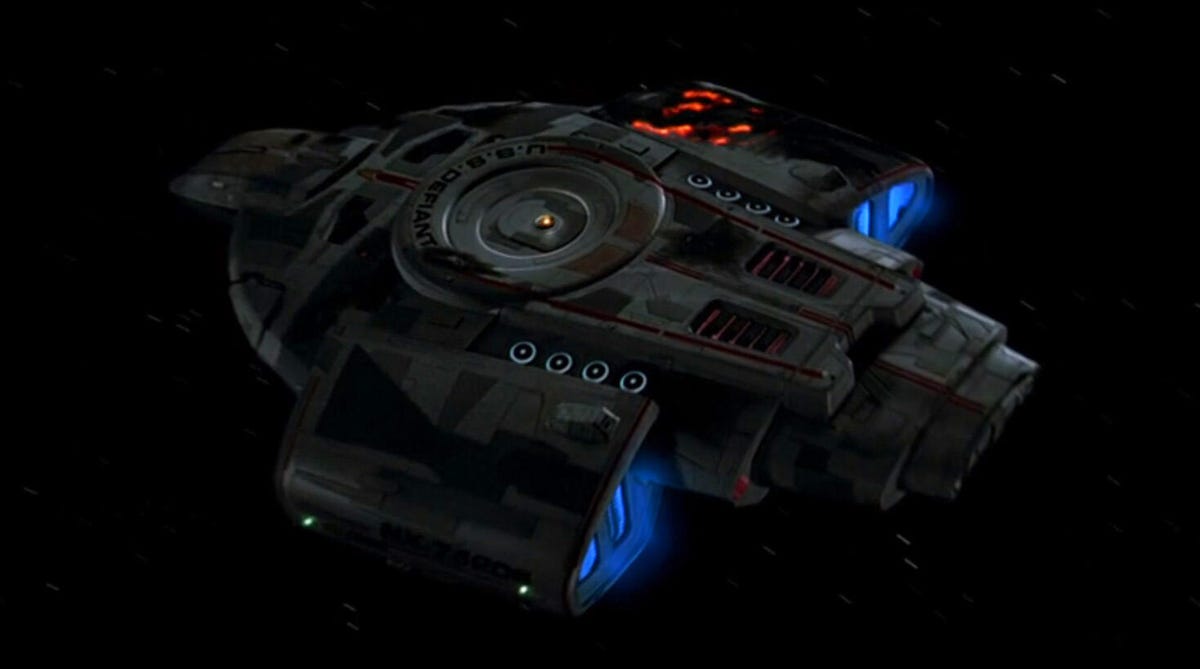
33. USS Defiant (NX-74205)
Don't let its waffle-iron looks fool you. This Federation ship is tricked out with a Romulan cloaking device, and is built for Borg battles. The Defiant is adept at taking out Jem'Hadar warships, and, from a storyline perspective, opening up Star Trek: Deep Space Nine . It also adds spunk to Star Trek: First Contact .
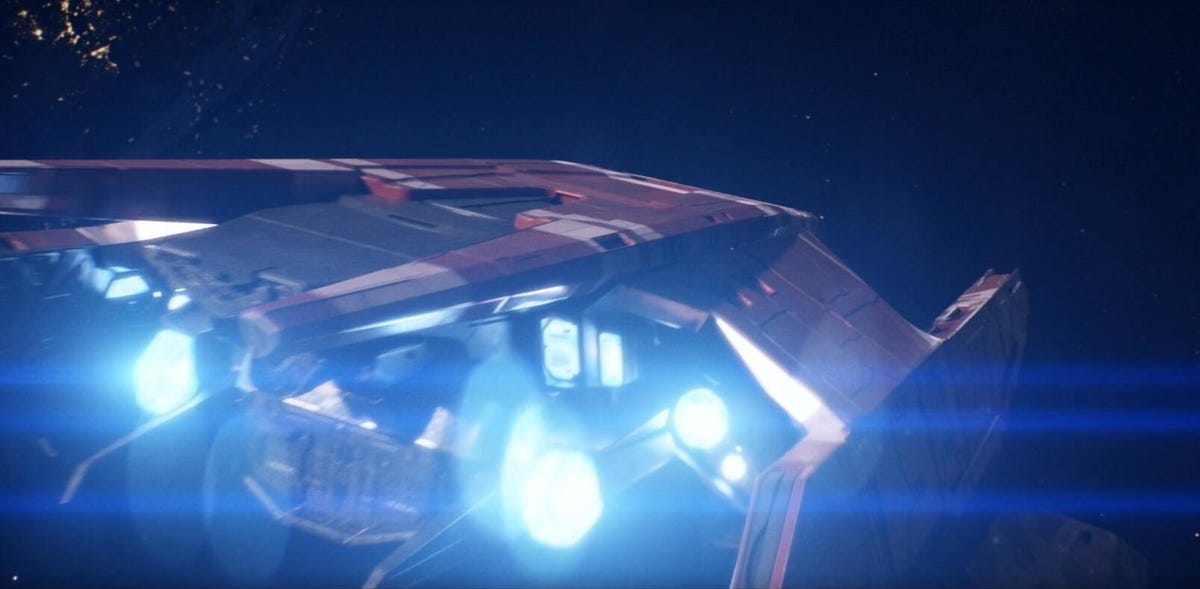
32. La Sirena
This is the lone entry from Star Trek: Picard . According to Memory Alpha, this newcomer, captained on the show by Cristóbal Rios, is a Kaplan F17 Speed Freighter, a class of civilian ships equipped with shields, phasers -- and a whole lot of hologram capabilities.
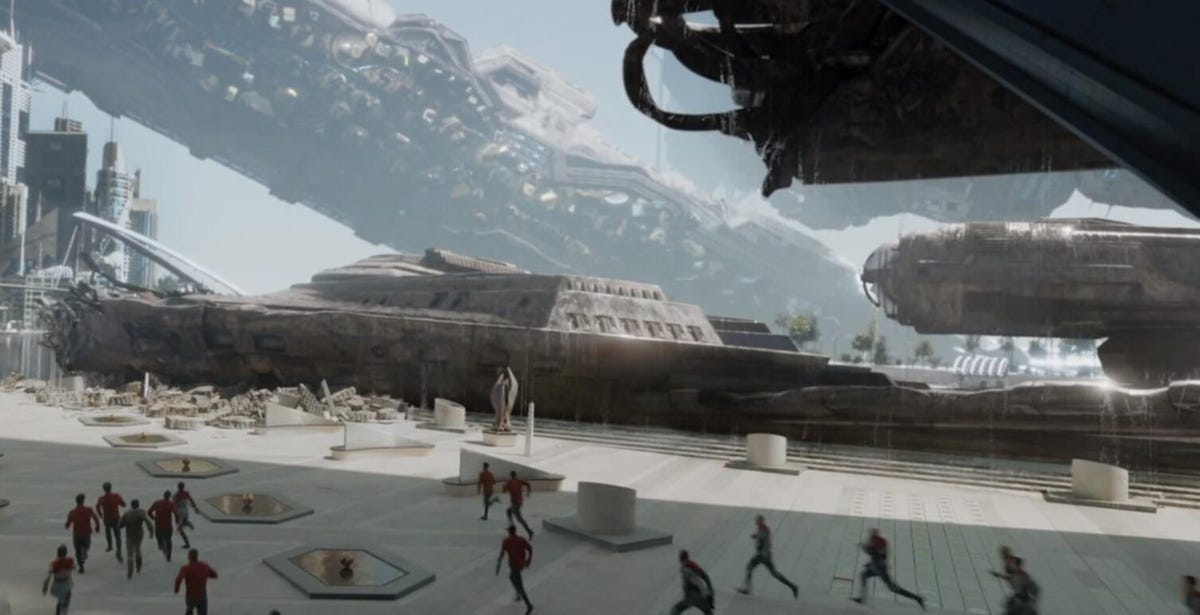
31. USS Franklin (NX-326)
Like other Freedom-class starships, the Franklin is small, but tough. The 22nd-century craft is equipped with cannons, torpedoes, stealth technology, and, in the Kelvin timeline of Star Trek: Beyond , seat belts. In the flick, Captain Kirk and crew salvage the rusted-up, long-lost Franklin, and use its warp 4 power to get from the planet Altamid to the Starbase Yorktown.
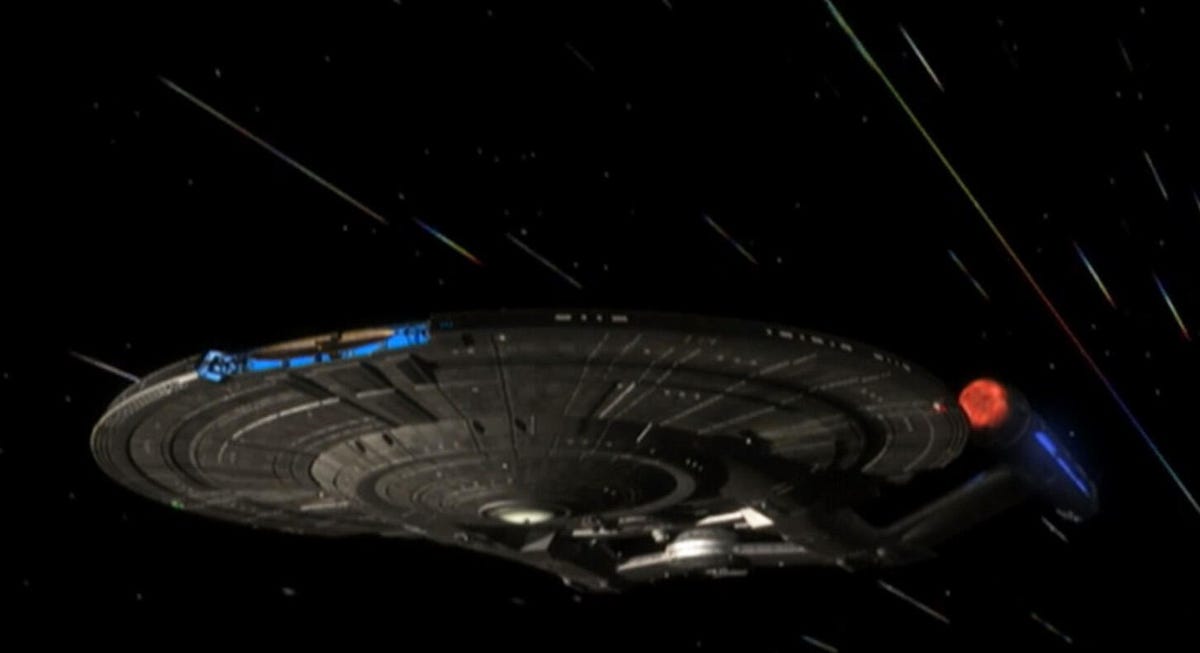
30. Enterprise (NX-01)
In much of the Star Trek universe, warp 5 power and a cargo-only transporter bay won't get you far. But in the 22nd century setting of Star Trek: Enterprise , this Starfleet ship, capable of carrying a crew of nearly 100, is a triumph of Zefram Cochrane's theories of space travel.
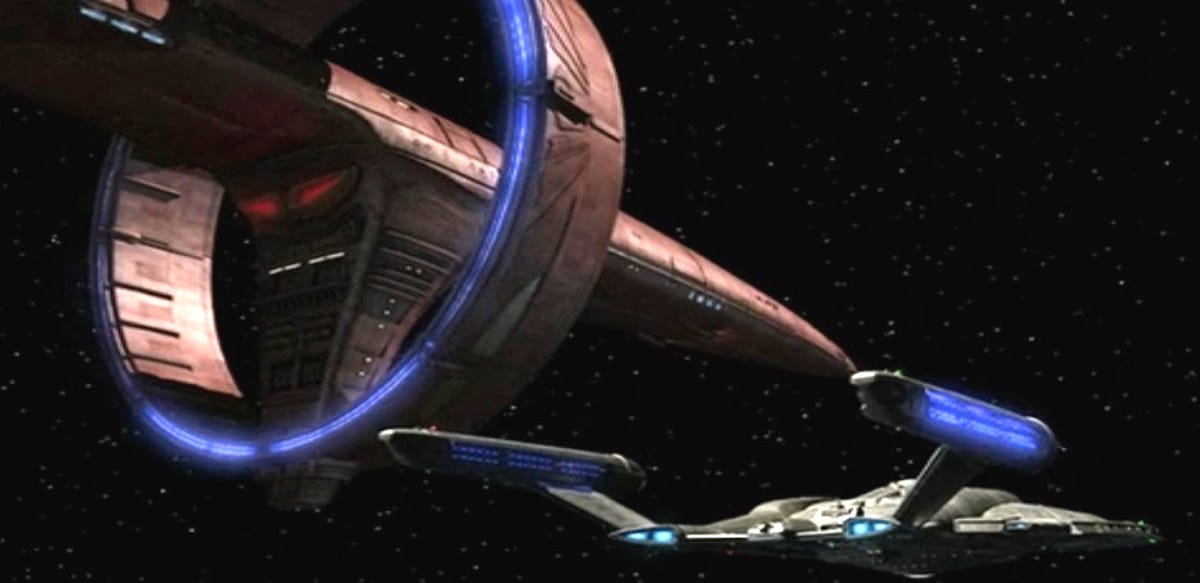
29. Sh'Raan
The Vulcans may be better known for logic than combat ships, but the pre-Federation years are a salty time, and Spock's forerunners are ready to throw down in this Star Trek: Enterprise -era craft with warp 7 power.
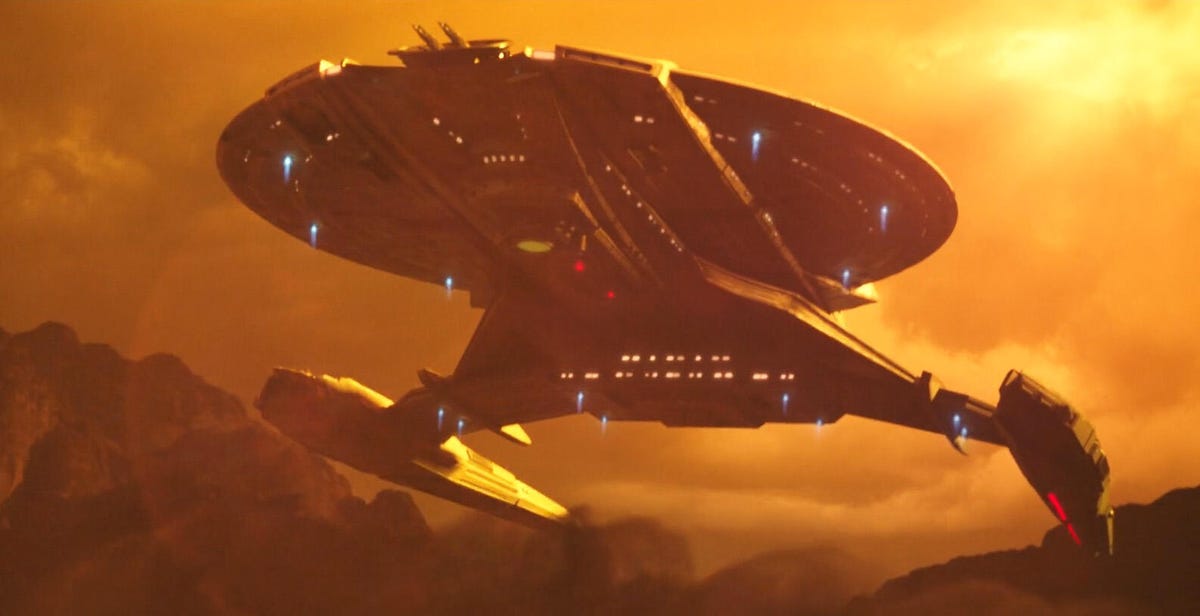
28. USS Shenzhou (NCC-1227)
Introduced in Star Trek: Discovery , the Philippa Georgiou-captained Shenzhou is a Walker-class Federation starship of the 23rd century. It's possessed of cannons, phasers, torpedoes -- and bad luck. Following a mutiny, it's destroyed in 2256's Battle of the Binary Stars.
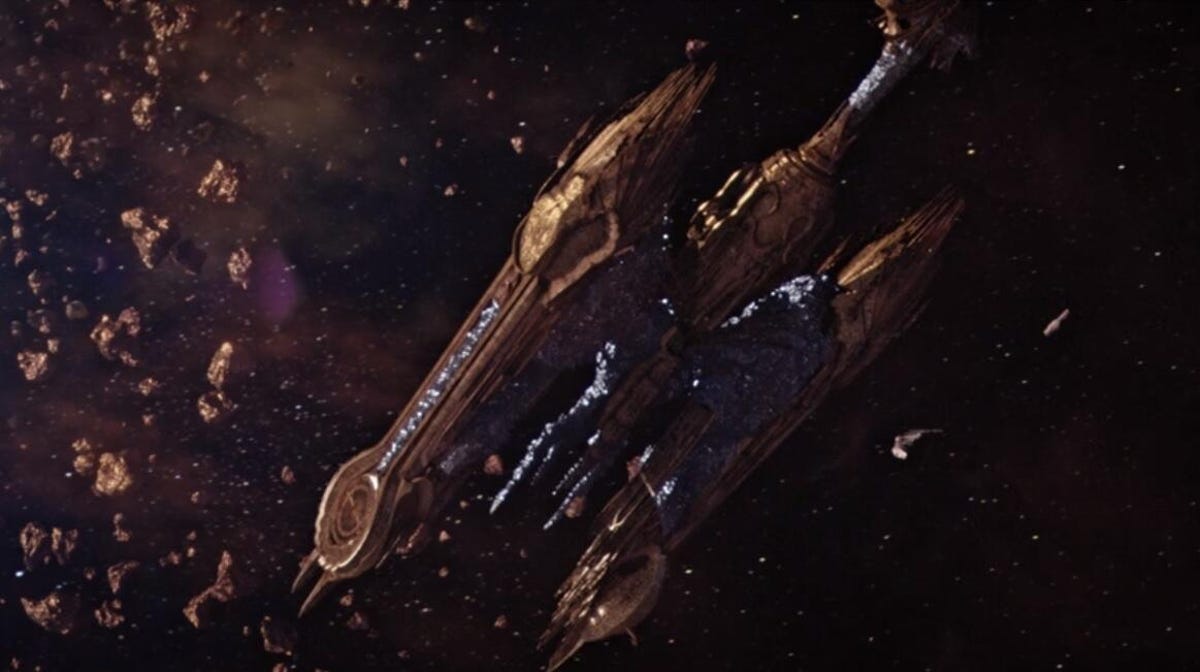
27. Sarcophagus
The Sarcophagus is a 23rd-century Klingon ship. It's larger than the Shenzhou, which it encounters in the Star Trek: Discovery pilot. Its most impressive feature is its most unique feature: Its armor is a patchwork of caskets containing the remains of Kilngon warriors.
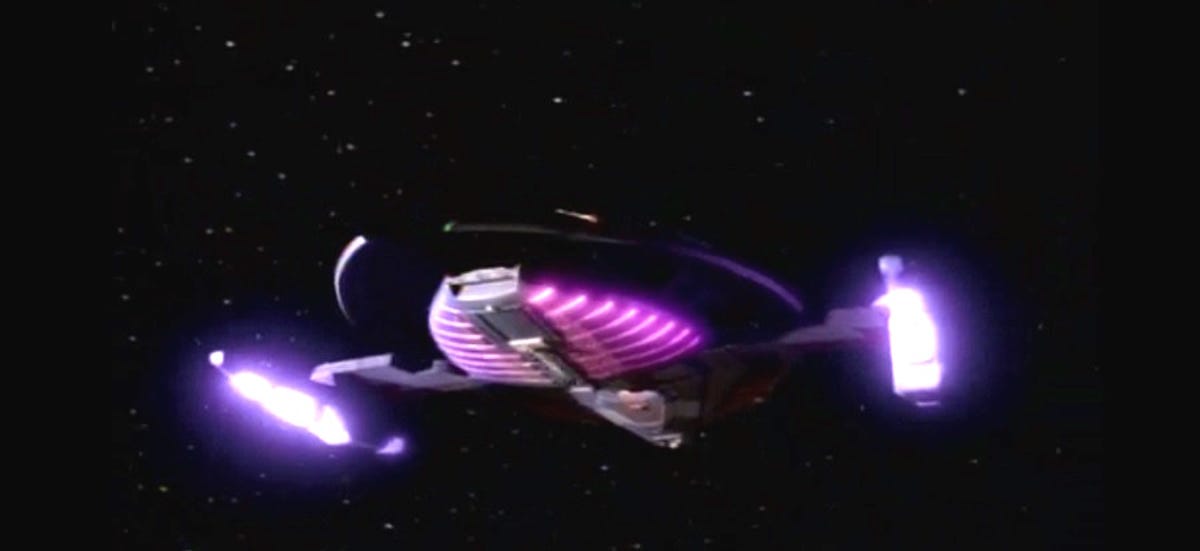
26. Jem'Hadar warship
You can't tell the story of Star Trek: Deep Space Nine without the Dominion, and you can't tell the story of the Dominion without its military branch, the Jem'Hadar, whose battleships can defy tractor beams and compromise an opponent's shields.
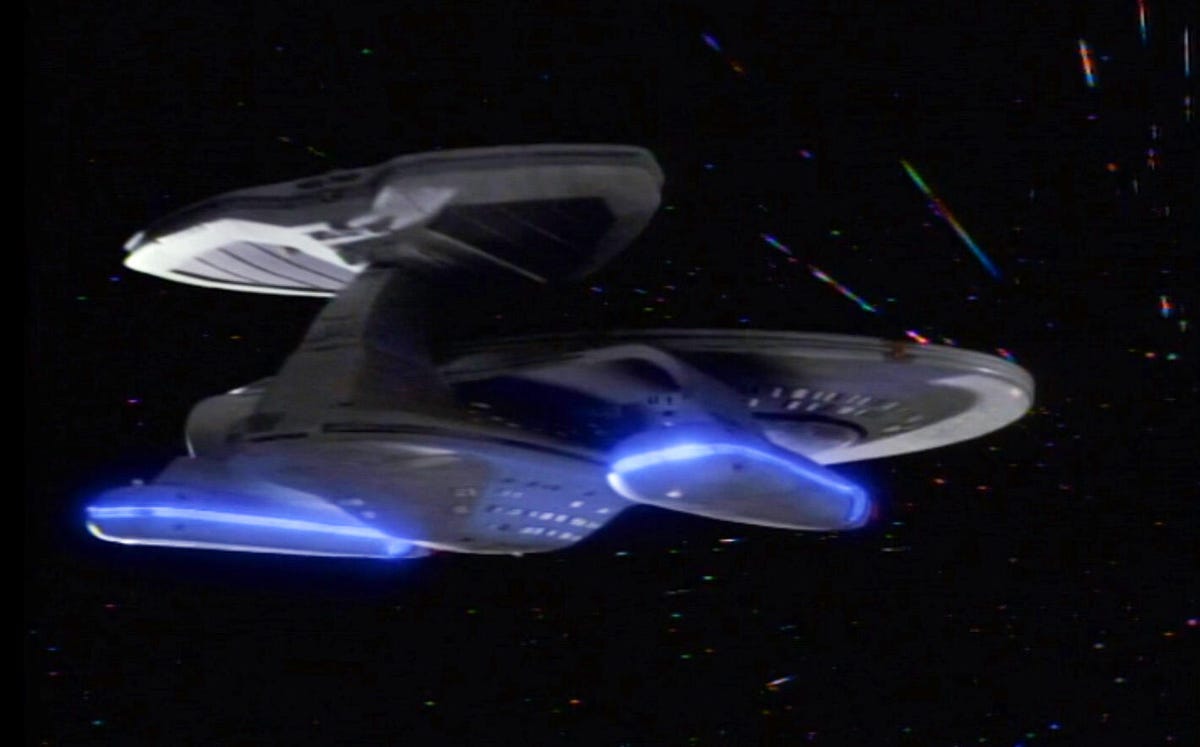
25. USS Prometheus (NCC-71201)
As seen in Star Trek: Deep Space Nine , this Nebula-class Federation ship is a floating science experiment. Its lofty goal: to reignite a dead sun. It gets the job done.
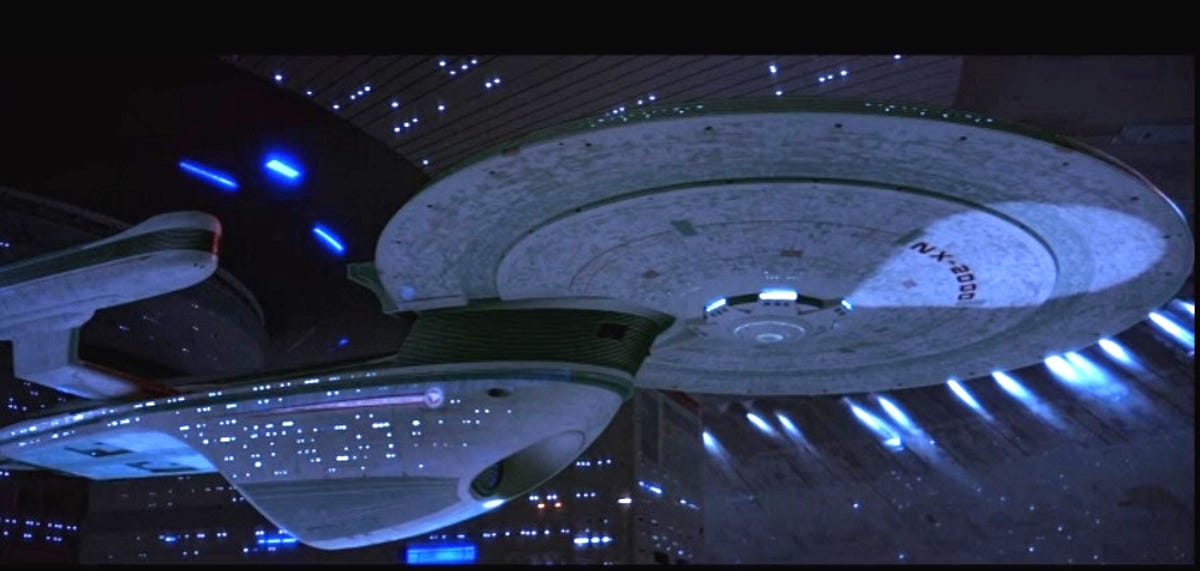
24. USS Excelsior (NX-2000)
The vessel that ably serves Captain Hikaru Sulu in Star Trek VI: The Undiscovered Country is the first Federation craft to feature transwarp drive. It would rank higher here, save for the apparent ease with which Scotty disables its bells and whistles in Star Trek III: The Search for Spock .
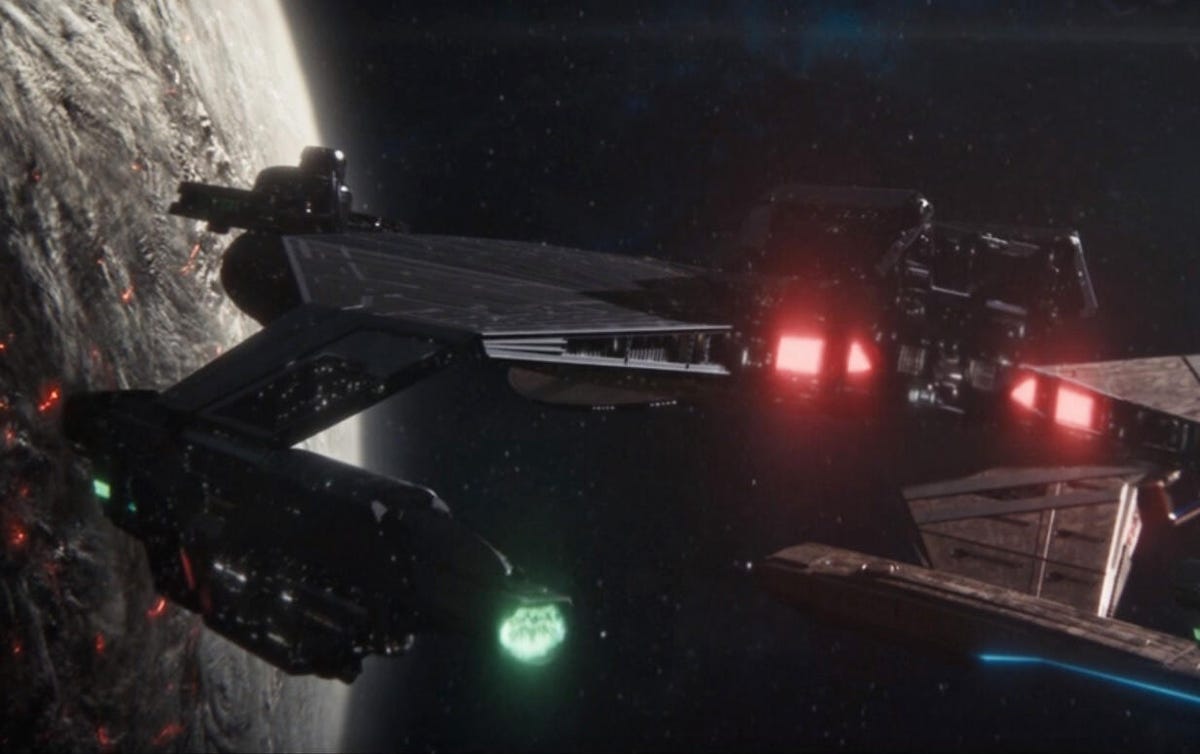
23. D7-class battle cruiser
At 748 feet long (228 meters), and with the capacity for a crew of 430, this Klingon ship is the largest of its era. Per StarTrek.com, it is also the "pinnacle of combat warships in the 23rd century." It'd rank higher here, except, well, even cooler stuff came along in the 24th century.
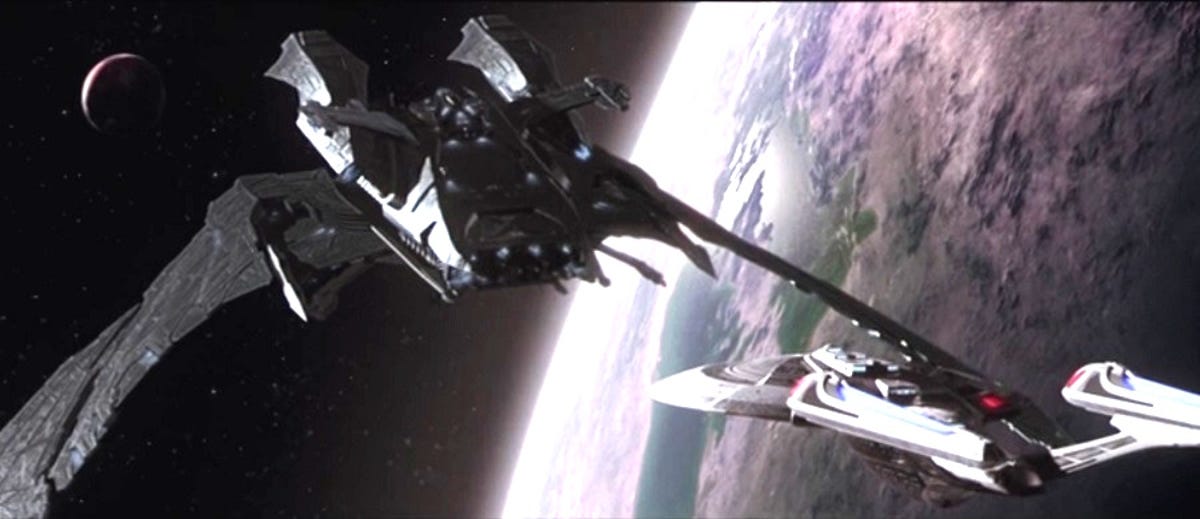
22. Scimitar
This Reman-made ship from Star Trek: Nemesis is stocked with enough disruptor banks (52) and photon-torpedo bays (27) to impress, but its real power lies in its ability to convert itself into a thalaron weapon , similar to a nuclear weapon but far more devastating.
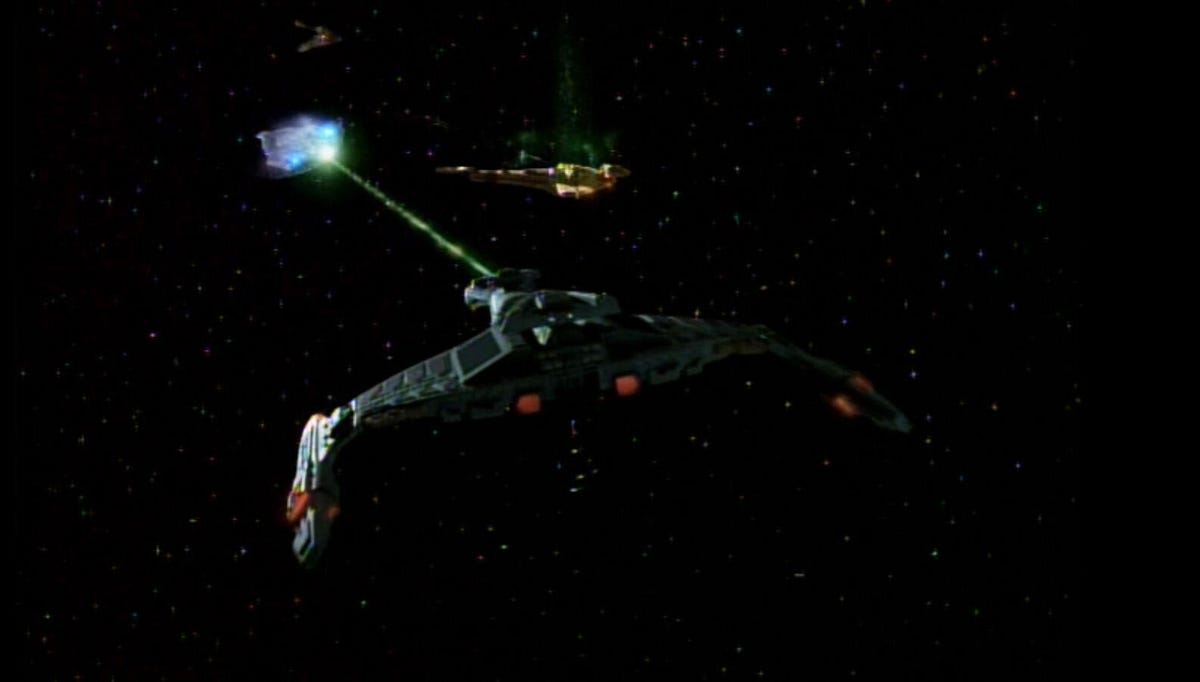
21. Vor'Cha-class attack cruiser
A mainstay of the Star Trek universe, this powerful, heavily armed Klingon craft is nearly as long as a Galaxy-class Federation starship, a la the USS Enterprise (NCC-1701-D) of Star Trek: The Next Generation .
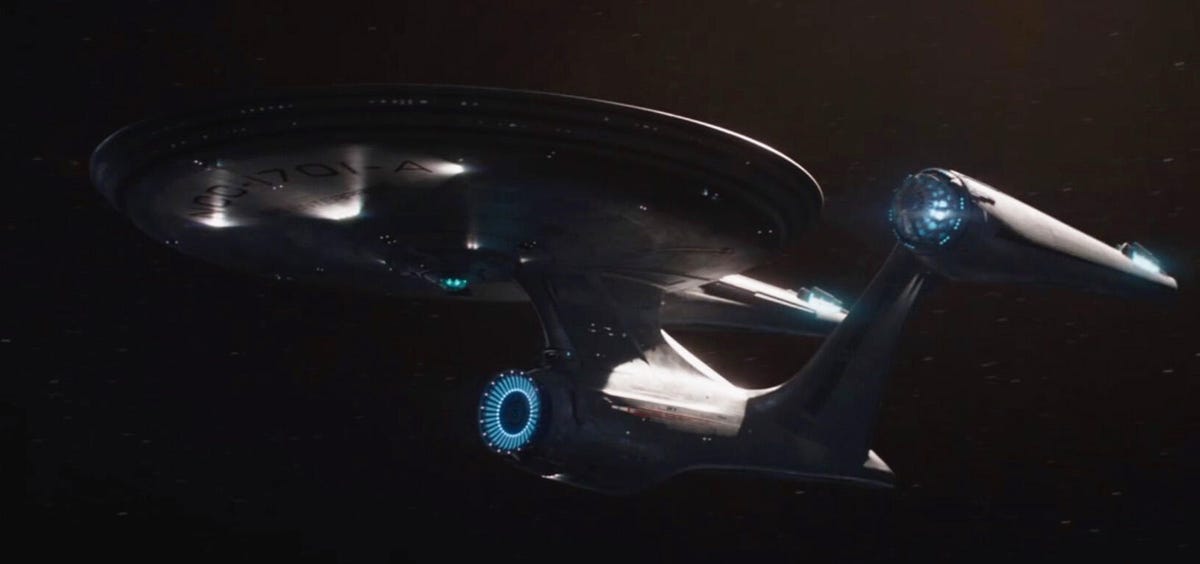
20. USS Enterprise (NCC-1701-A)
This Constitution-class starship is essentially a replica of the original, iconic Enterprise.
First seen blasting off in the prime timeline of Star Trek IV: The Voyage Home , the Enterprise-A also appears in the Kelvin timeline of the J.J. Abrams-era Star Trek films. There is no known distinction between the Enterprise-As of the two timelines.
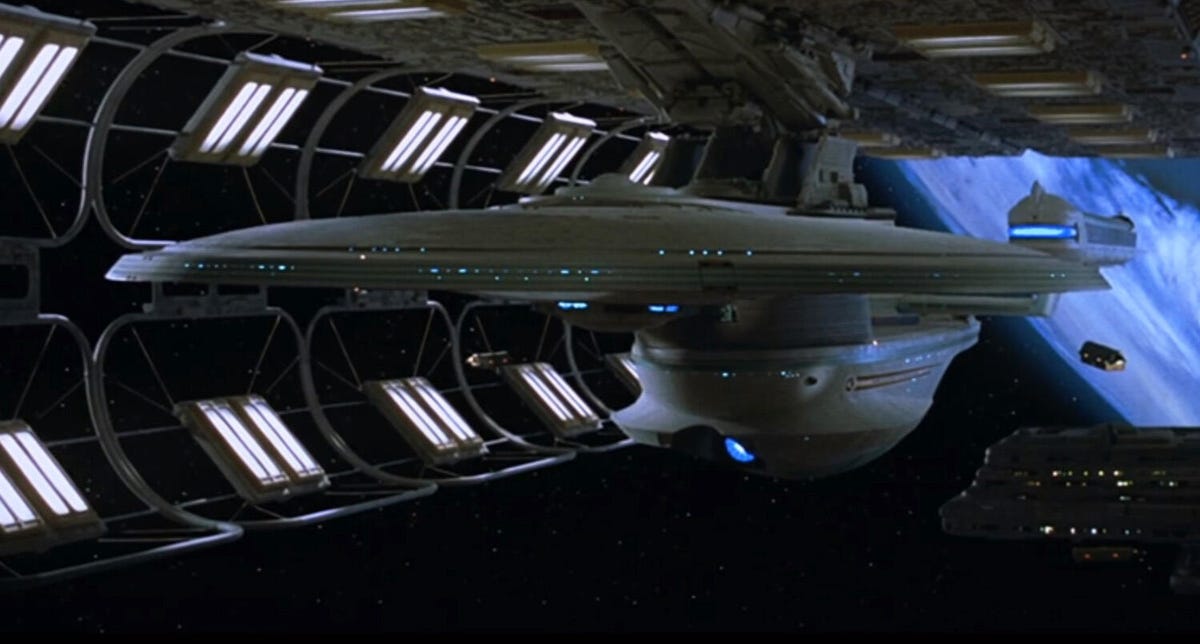
19. USS Enterprise (NCC-1701-B)
This 23rd-century, Excelsior-class Federation starship is a sleeker version of the Constitution-class Enterprise of the prime timeline. In Star Trek: Generations , Captain Kirk is aboard the Enterprise-B when it's damaged by the Nexus ribbon -- and Kirk is swept away (and presumed dead).
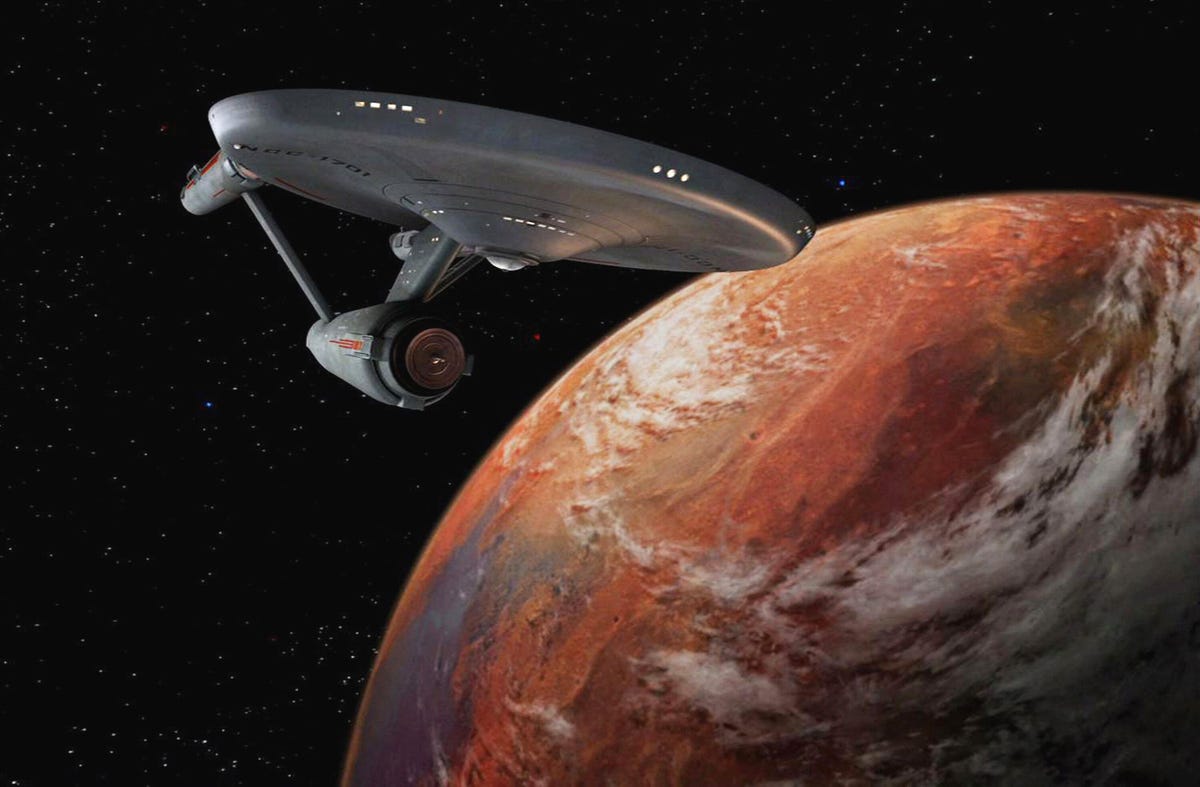
18. USS Enterprise (NCC-1701), prime timeline
So, sure, the Enterprise of the original Star Trek series (of the original Star Trek timeline, natch) would lose a drag race with, say, the USS Voyager (NCC-74656), but speed isn't everything. The Constitution-class vessel is part warship, part science lab -- and all kinds of iconic.
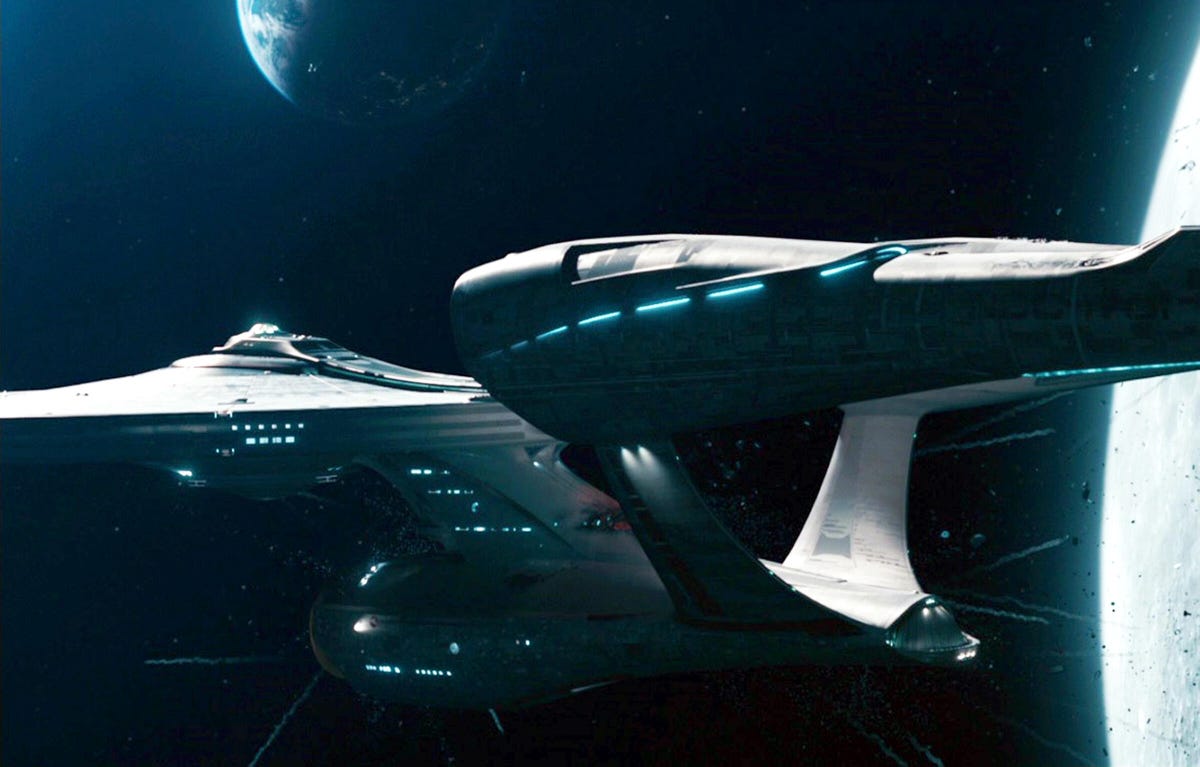
17. USS Enterprise (NCC-1701), Kelvin timeline
According to Gizmodo, the Kelvin timeline's Enterprise is more than twice the size of the prime timeline's Enterprise. Storyline-wise, however, the craft is still the product of the 23rd century, so it can't really kick it at more than warp 8.
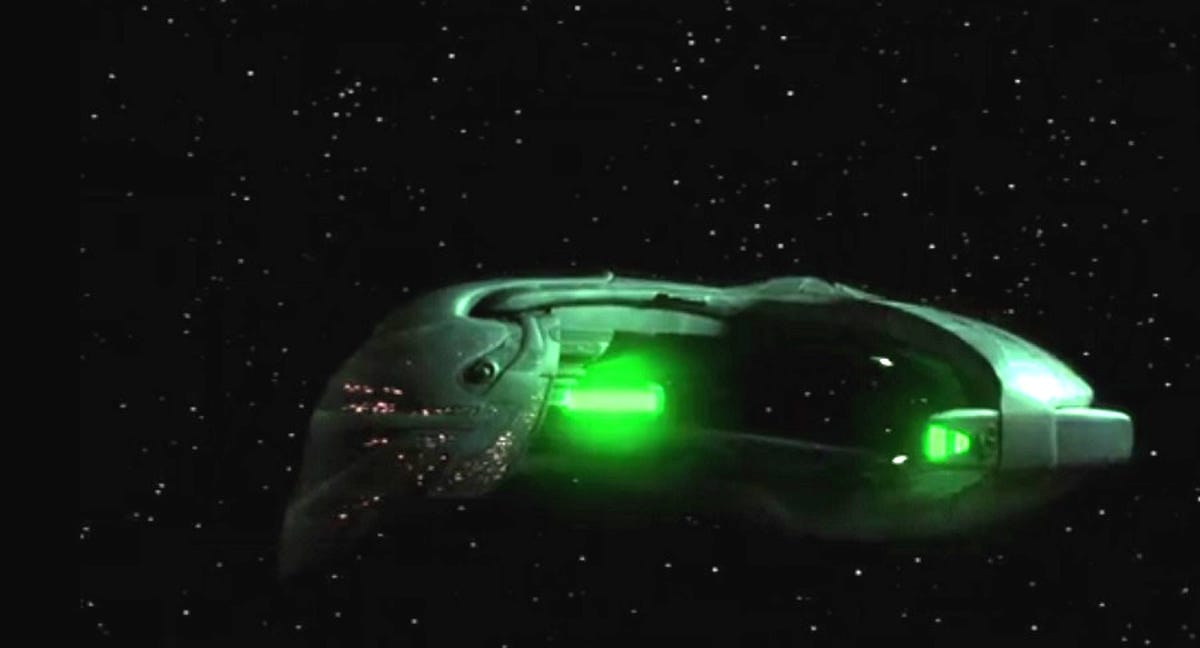
16. Romulan warbird
In Star Trek: The Next Generation , Captain Jean-Luc Picard and crew, no strangers to swank and size, are in awe of this baby -- and for good reason. Per StarTrek.com, the Romulan warbird is "the largest and most powerful of Romulan spacecraft."
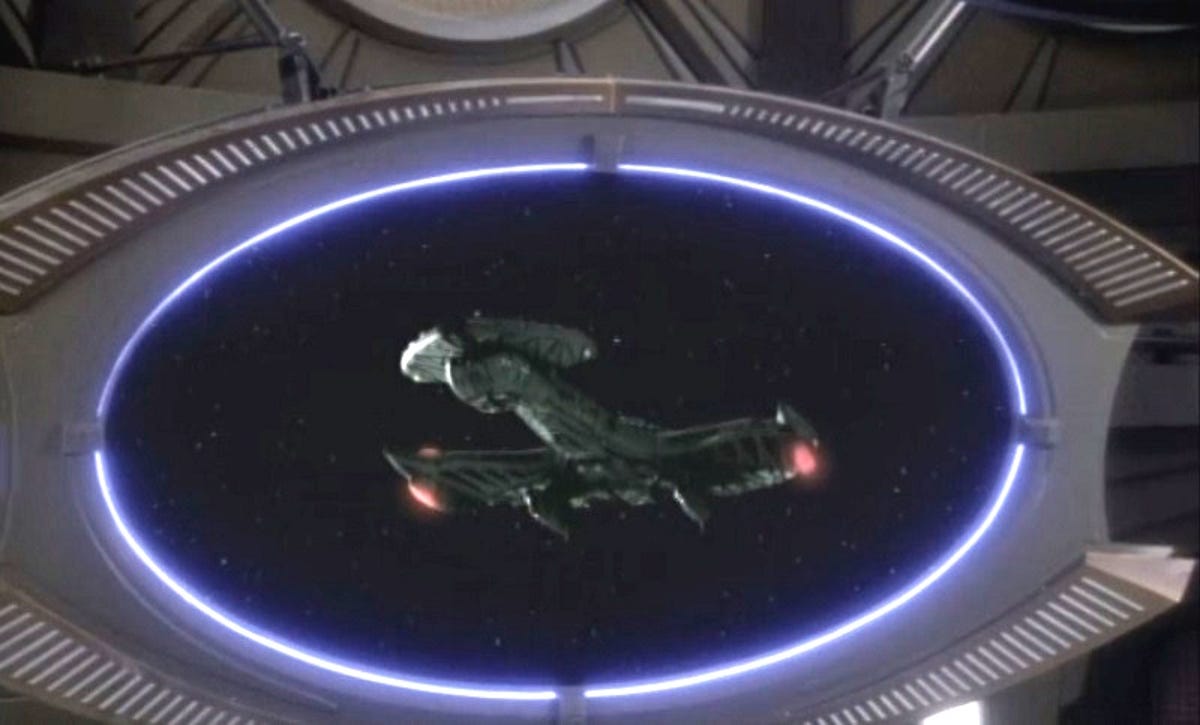
15. Negh'Var warship
In the 24th century, this Klingon craft is the flagship of its fleet. It runs more than 2,250 massive feet long.
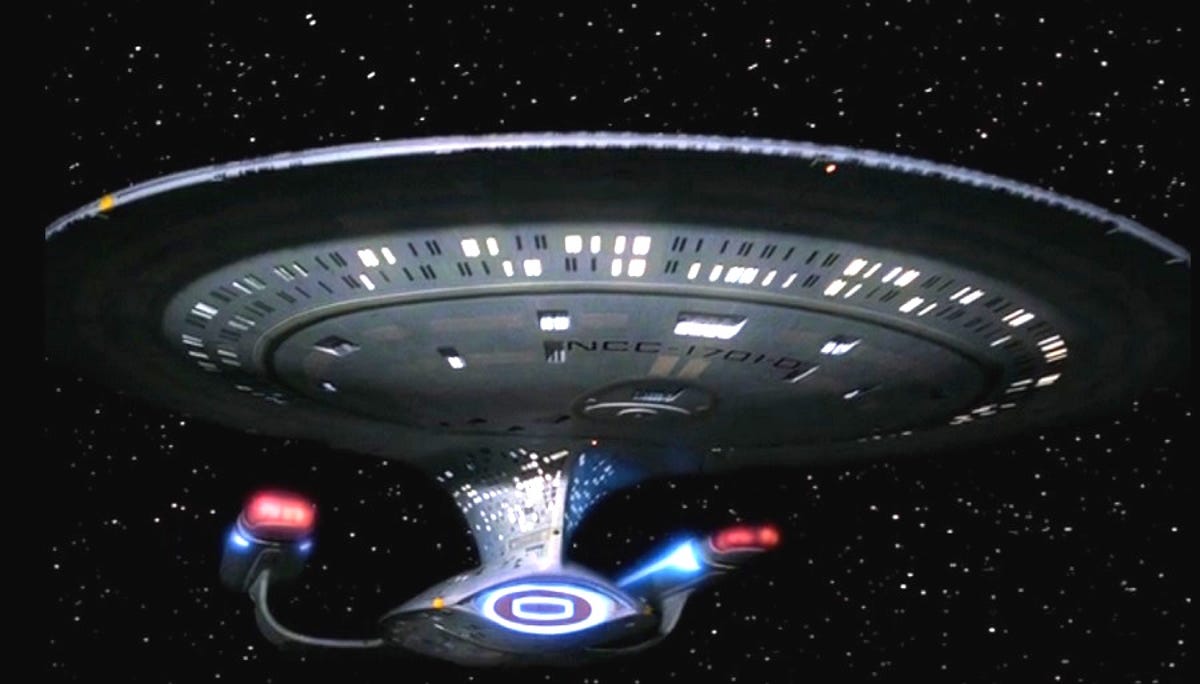
14. USS Enterprise (NCC-1701-D)
This 24th-century, Galaxy-class Federation starship is the star of Star Trek: The Next Generation , Captain Jean-Luc Picard's ride is bigger and faster than the Constitution-class Enterprise of the prime timeline. With 250 photon-torpedo bays, it's also better equipped to battle the Borg than its 23rd-century counterpart.
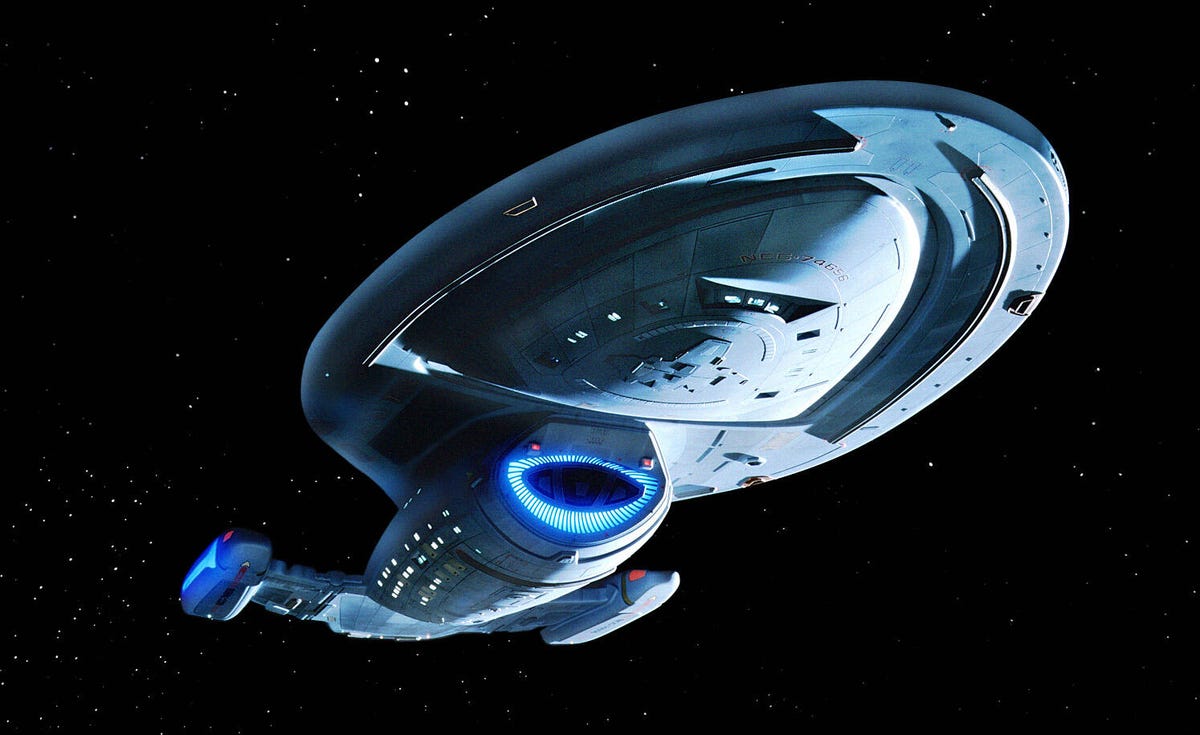
13. USS Voyager (NCC-74656)
Captain Kathryn Janeway's relatively puny ship from Star Trek: Voyager gets the edge over the Enterprise iterations we've covered so far, because it's smarter and faster. Powered in part by Borg technology, Voyager can cruise at warp 9.975.
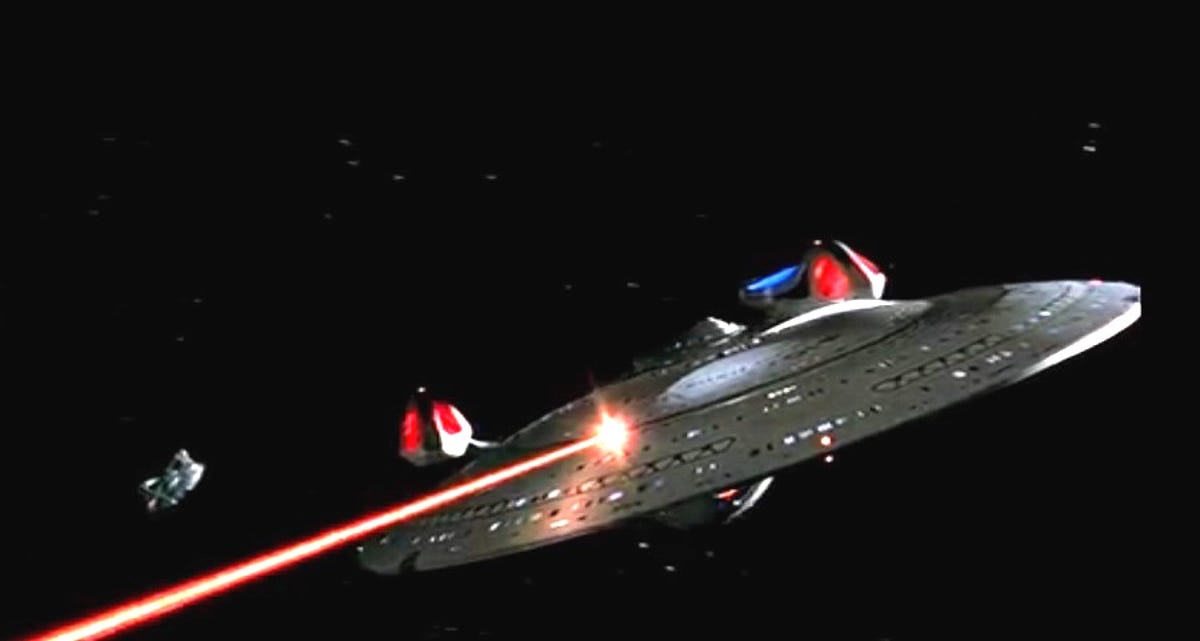
12. USS Enterprise (NCC-1701-E)
This Sovereign-class craft, captained by Jean-Luc Picard in Star Trek: First Contact , Star Trek: Insurrection and Star Trek: Nemesis , was voted the best-engineered Federation ship (prime timeline) in a StarTrek.com fan poll. With quantum torpedoes and the ability to quickly dispatch a Borg cube, it's easy to see why.
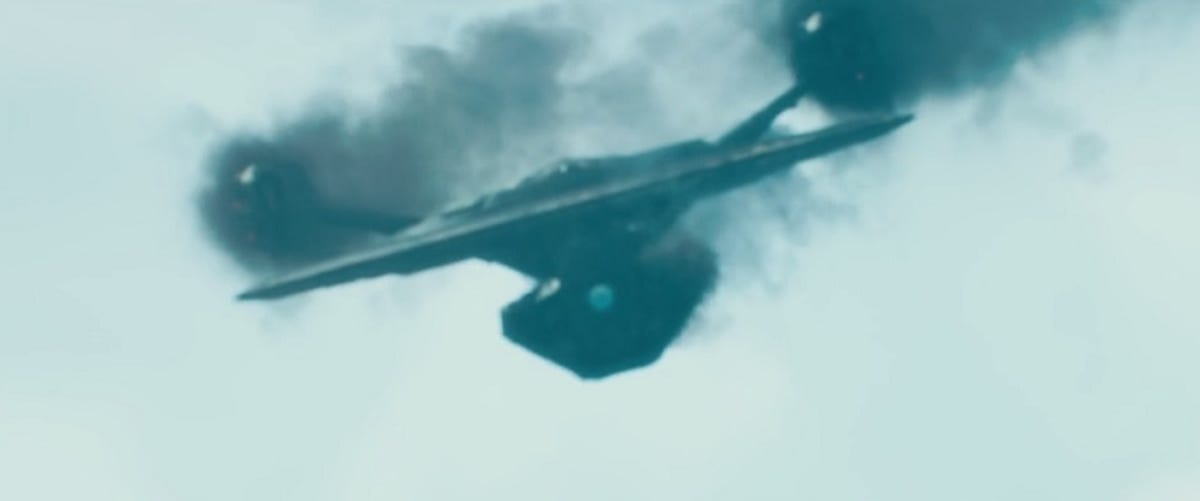
11. USS Vengeance
This is a scary-powerful vessel from Star Trek's Kelvin timeline. As related in " Star Trek: Into Darkness ," the Vengeance was developed off the Federation grid -- and with the help of Khan. The Vengeance is the one-and-only member of the Federation's Dreadnought battleship class.
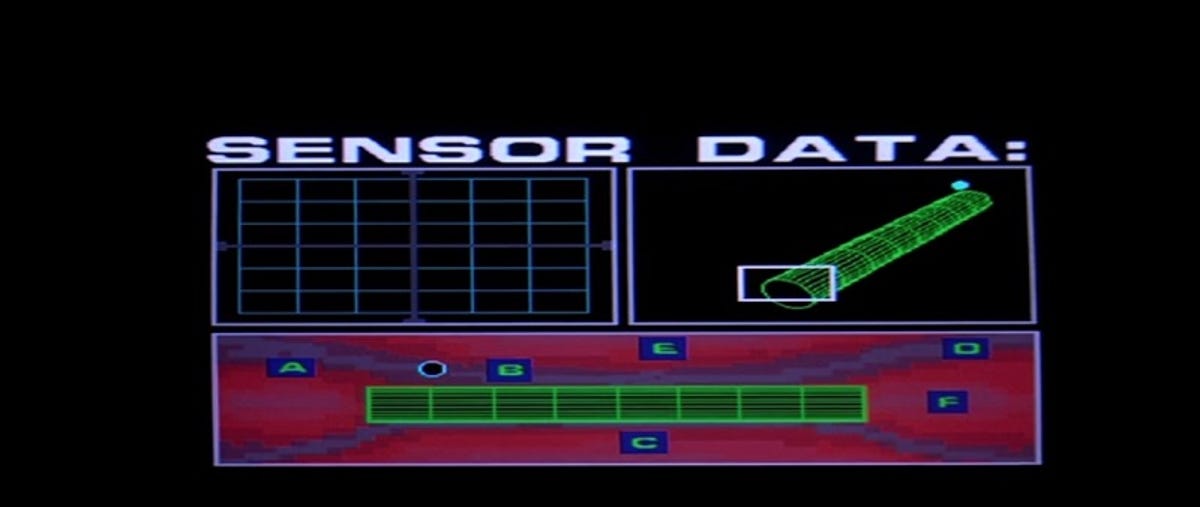
10. The whale probe
There is no defeating this massive, cylindrical, power-sucking, starship-disabling, ocean-vaporizing threat from Star Trek IV: The Voyage Home . There is only placating it with what it wants to hear: whales.
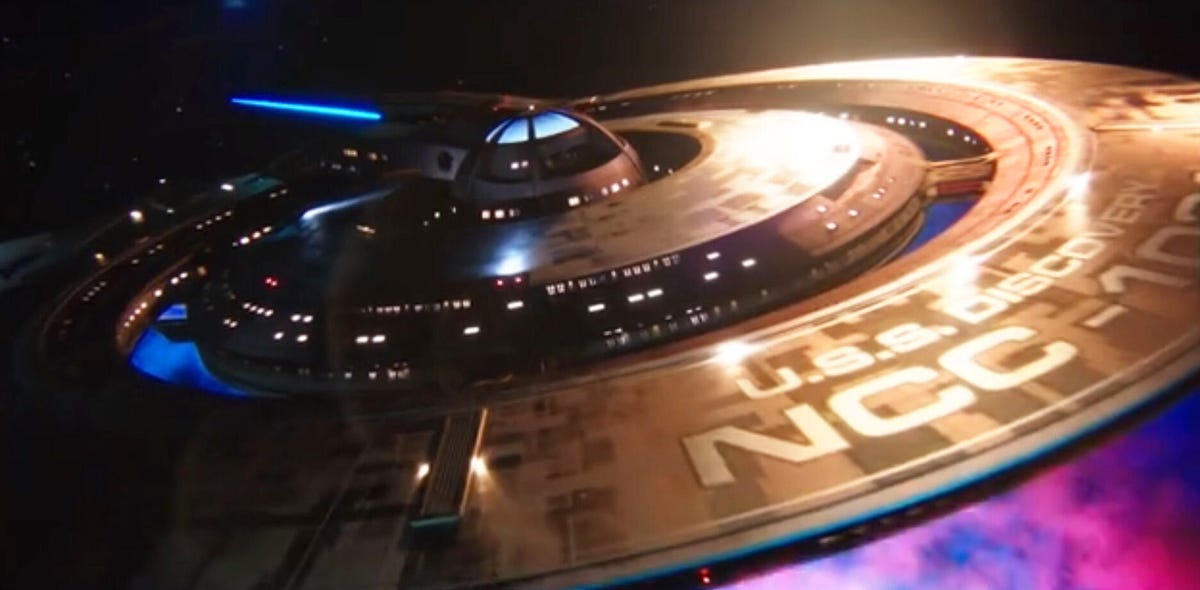
9. USS Discovery (NCC-1031)
There is nothing else quite like the namesake ship of Star Trek: Discovery . The Federation Crossfield-class starship is distinguished by a propulsion drive that allows it to jump (or, spore jump, if you prefer the technical term) from realm to realm. When last seen in the Season 2 finale, the ship had time-jumped nearly 1,000 years into the future .
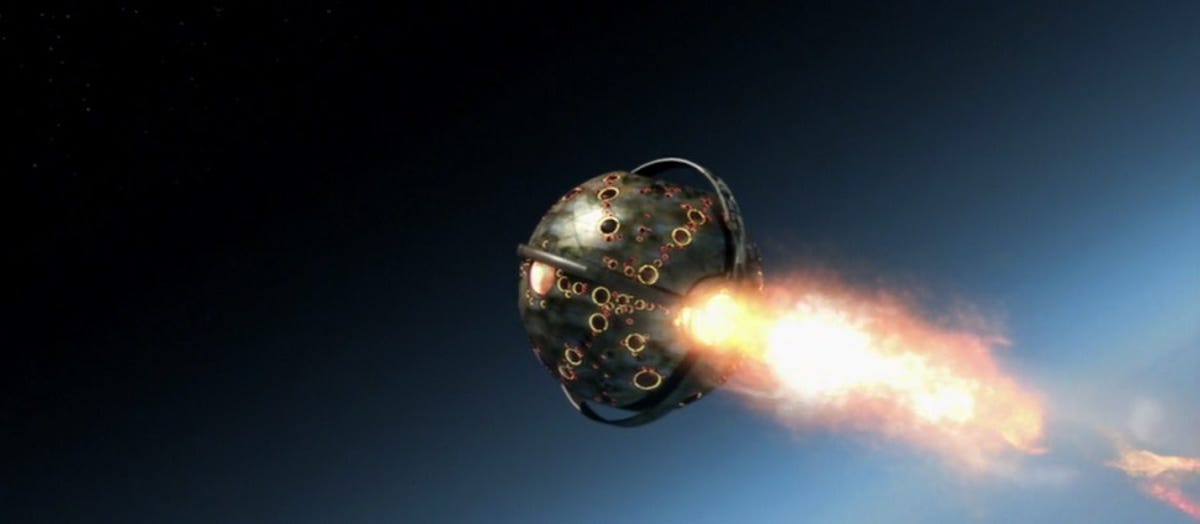
8. Xindi probe
This Xindi-dispatched probe from Star Trek: Enterprise is a pure beam of destructive force. In a 22nd century attack on Earth, it wipes out more than 7 million people from Florida to Venezuela.
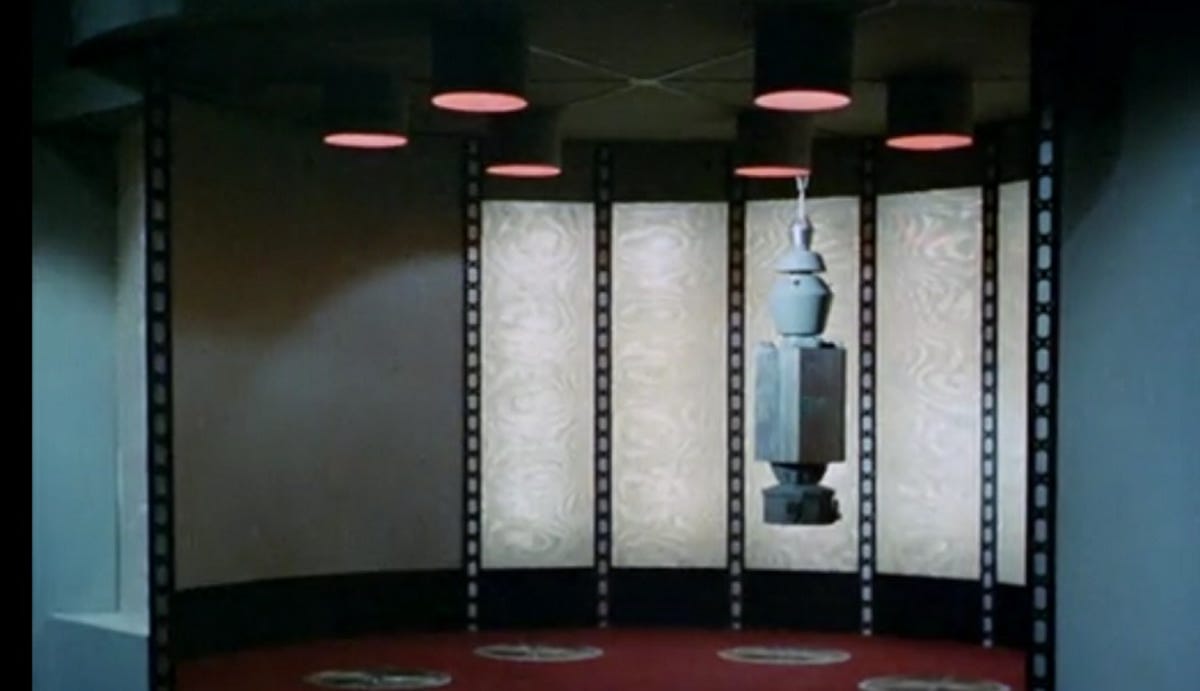
After this 20th century Earth probe melds with the E.T. probe, Tan Ru, it turns into a judgmental little bugger that wipes out at least 4 billion people across four planets. Captain Kirk and company encounter it in the Star Trek original-series episode, The Changeling .
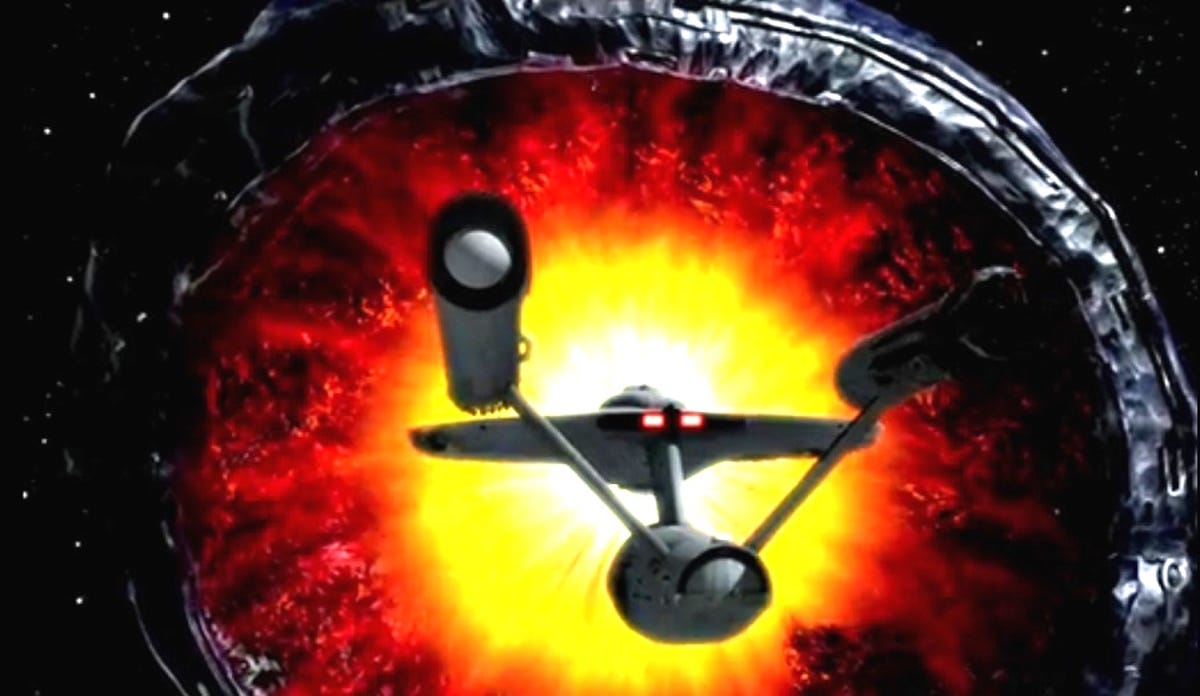
6. "The Doomsday Machine"
In " The Doomsday Machine ," the Star Trek original-series episode from which this nameless alien ship/lifeform sprang, we learn that "that thing" literally eats planets and everything else it finds, fueling itself with the resulting rubble.
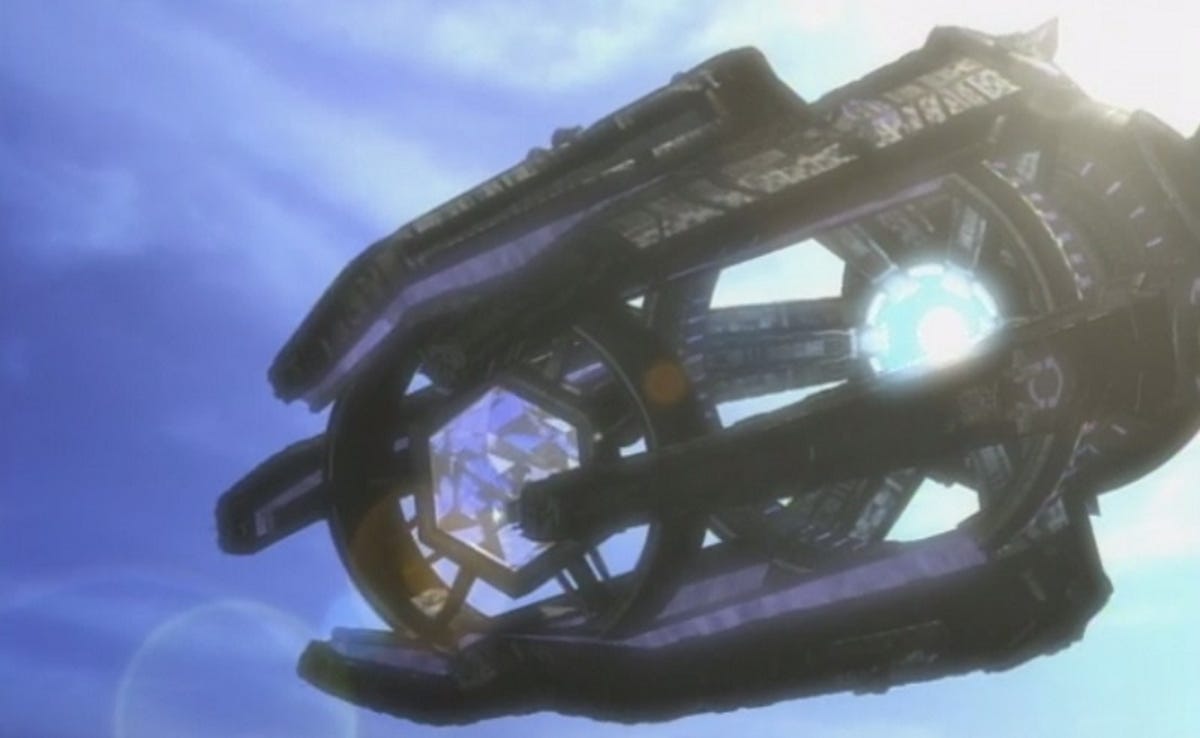
5. Krenim temporal weapon ship
The promise -- or, rather, threat -- of this Star Trek: Voyager craft is awesome: Possessed of timeline-changing power, the ship, we're told in the episode, "Year of Hell," can "erase [an] entire species from time."
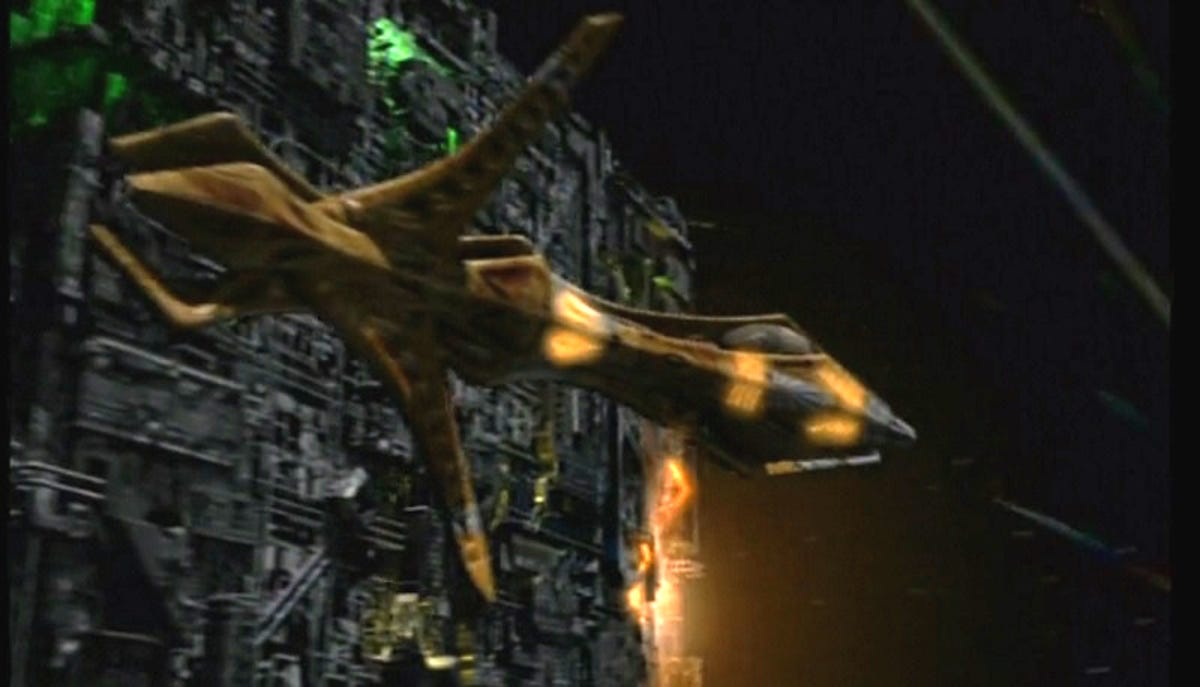
4. Species 8472 bioship
This craft is organic -- heavily armed and fortified organic. In Star Trek: Voyager , a Federation-Borg team-up is the only thing that can stop hundreds of these vessels from destroying pretty much everything they encounter. .
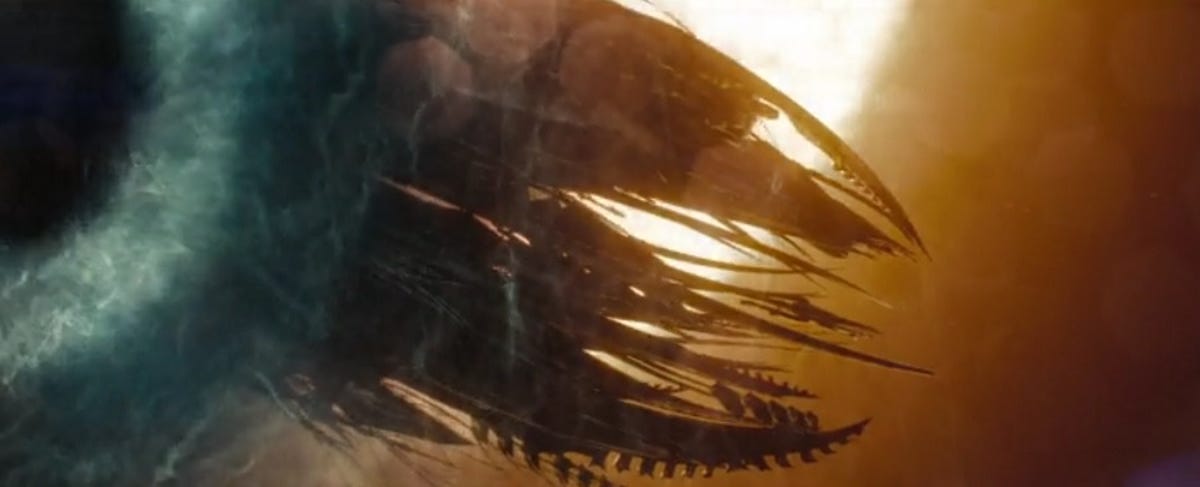
3. The Narada
This time-traveling Romulan mining ship is arguably the most significant ship in the Star Trek universe.
In the 2009 Star Trek film, the Narada launches an attack on the USS Kelvin, and prompts Captain Kirk's father, First Officer George Kirk, to take his dying ship on a suicide mission. The resulting collision with the Narada is so massive it creates a whole new timeline -- the Kelvin timeline.
In the new timeline, the devastating Narada destroys the planet Vulcan.
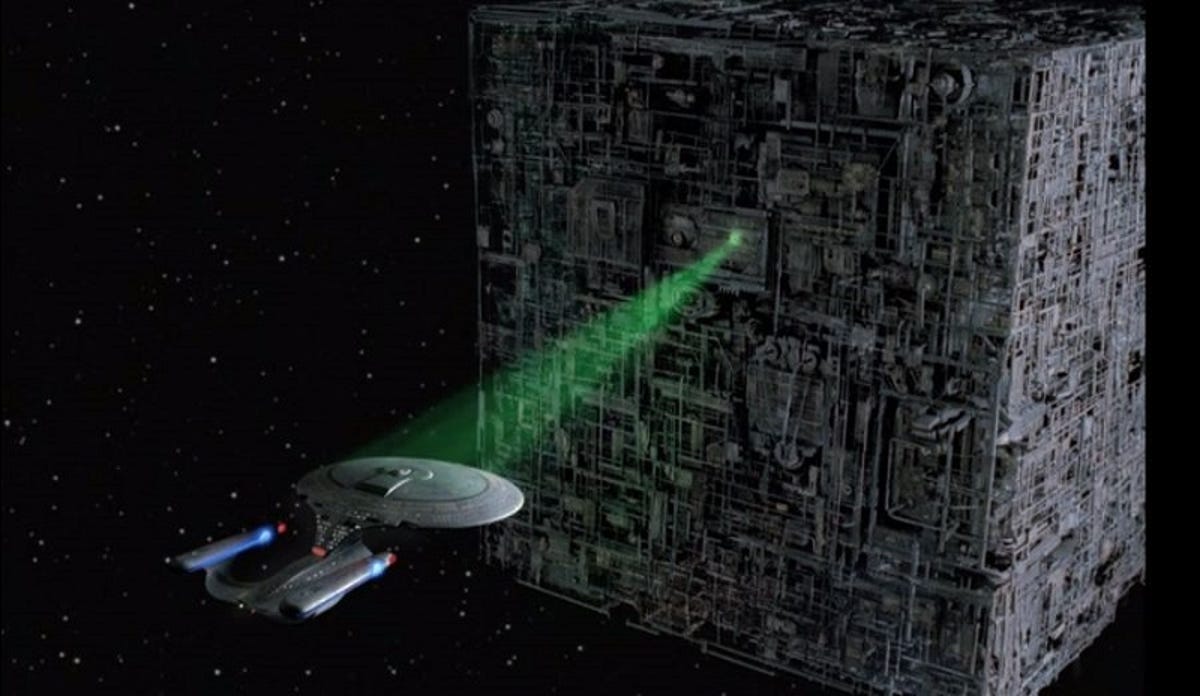
2. The Borg cube
Such is the dark legend of this inscrutable spacecraft that fans routinely debate which is more powerful: Star Wars' vaunted Death Star ... or Star Trek's Borg cube .
Before your next debate, consider this: The Death Star just wants to blow you up. The Borg cube, like the Borg itself, can blow you up, but it may just slice you up in bits instead -- the better to steal your technological soul.
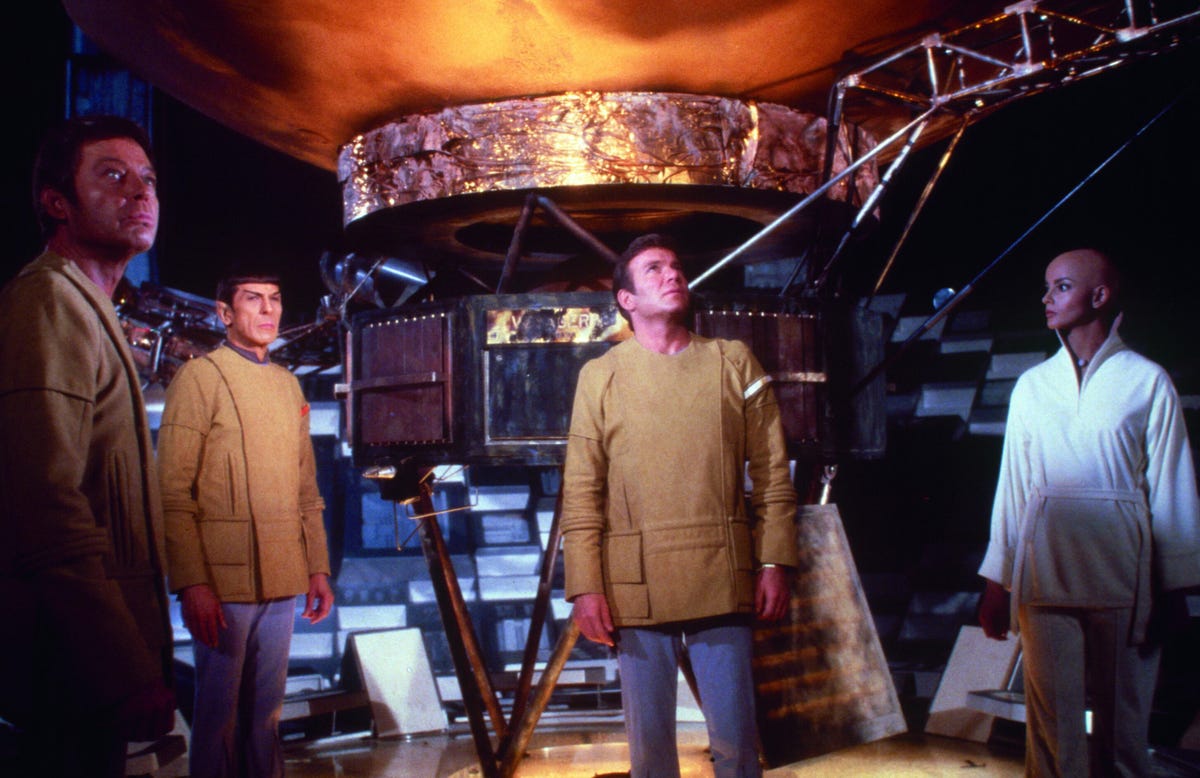
1. V'Ger
As seen in Star Trek: The Motion Picture , V'Ger is a force-field cloud of destruction driven by an old Earth probe, Voyager 6.
That it wipes out Klingon Bird-of-Prey ships and a Federation space station without any apparent effort is one impressive thing. That it spans 7.6 billion miles (or 82 astronomical units) in diameter is another. Craft like this are not defeated; they can merely be managed. Hopefully.
More Galleries

My Favorite Shots From the Galaxy S24 Ultra's Camera
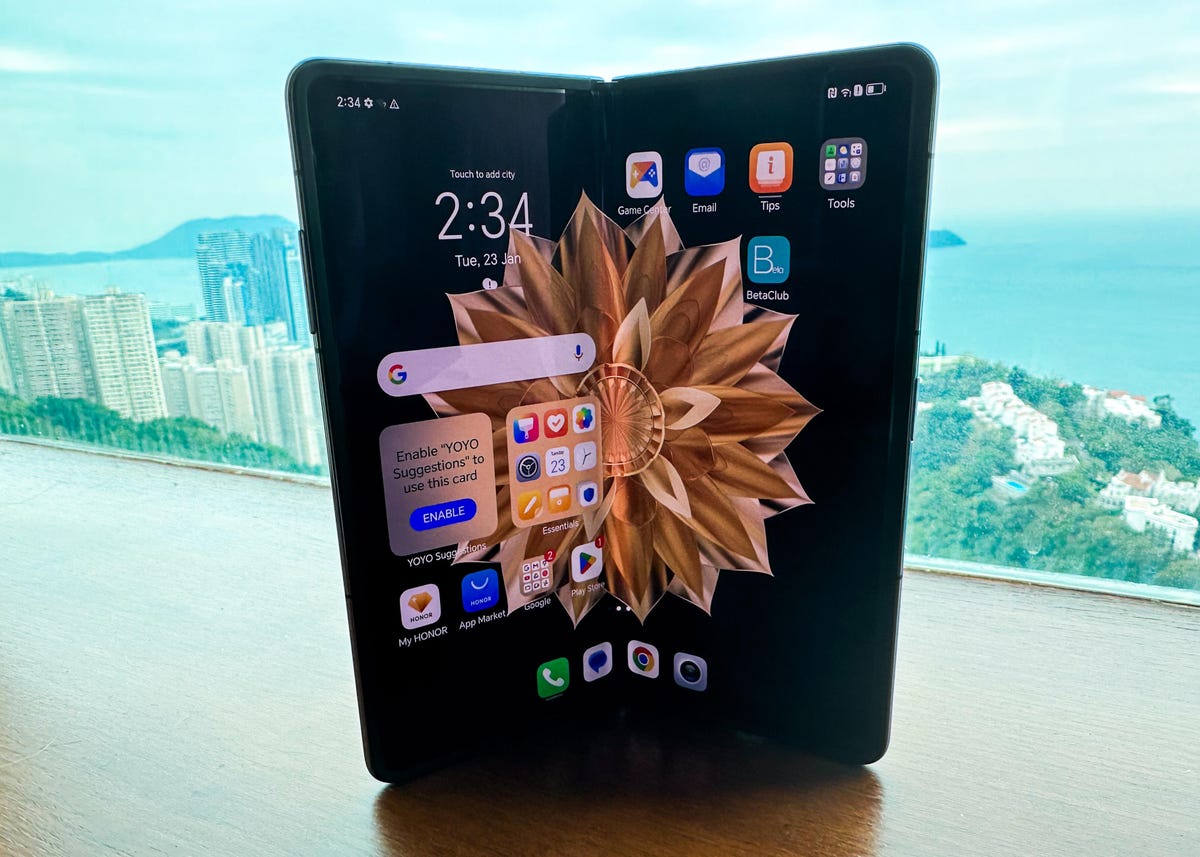
Honor's Magic V2 Foldable Is Lighter Than Samsung's Galaxy S24 Ultra

The Samsung Galaxy S24 and S24 Plus Looks Sweet in Aluminum
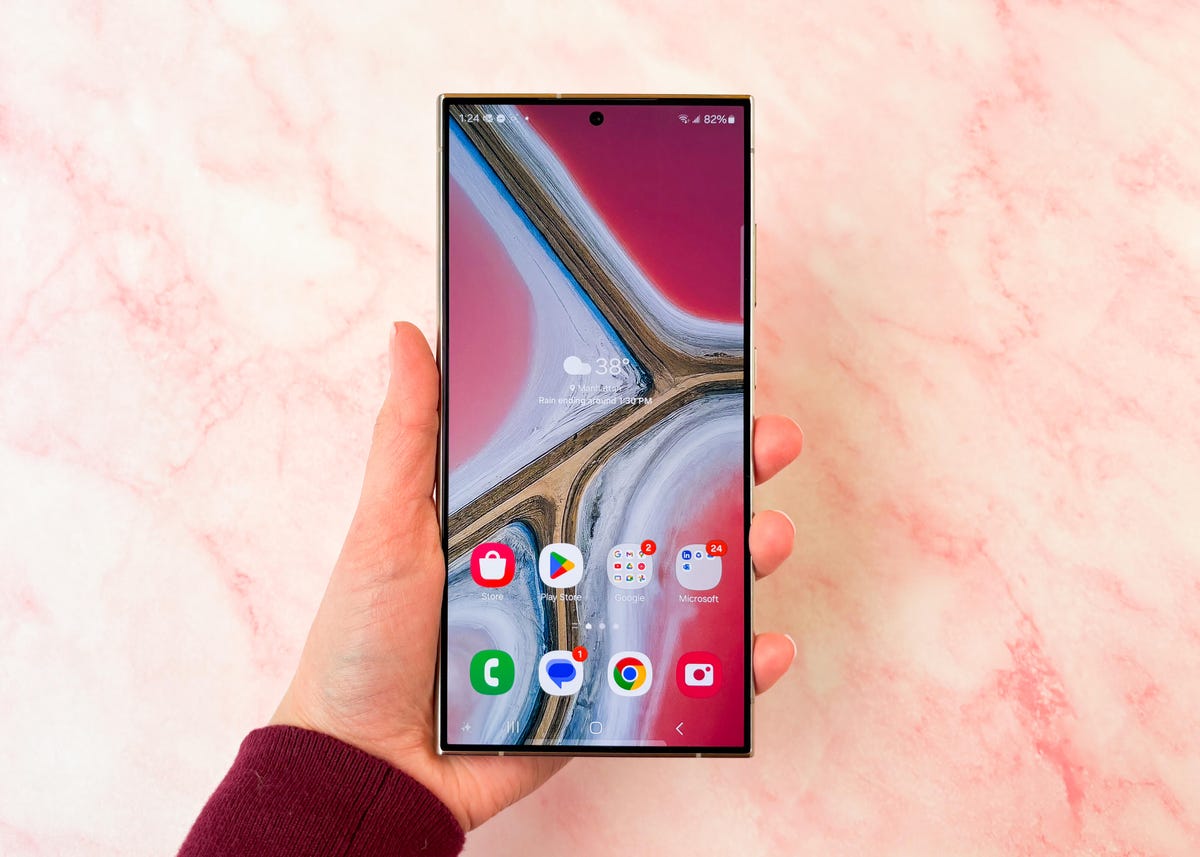
Samsung's Galaxy S24 Ultra Now Has a Titanium Design

I Took 600+ Photos With the iPhone 15 Pro and Pro Max. Look at My Favorites
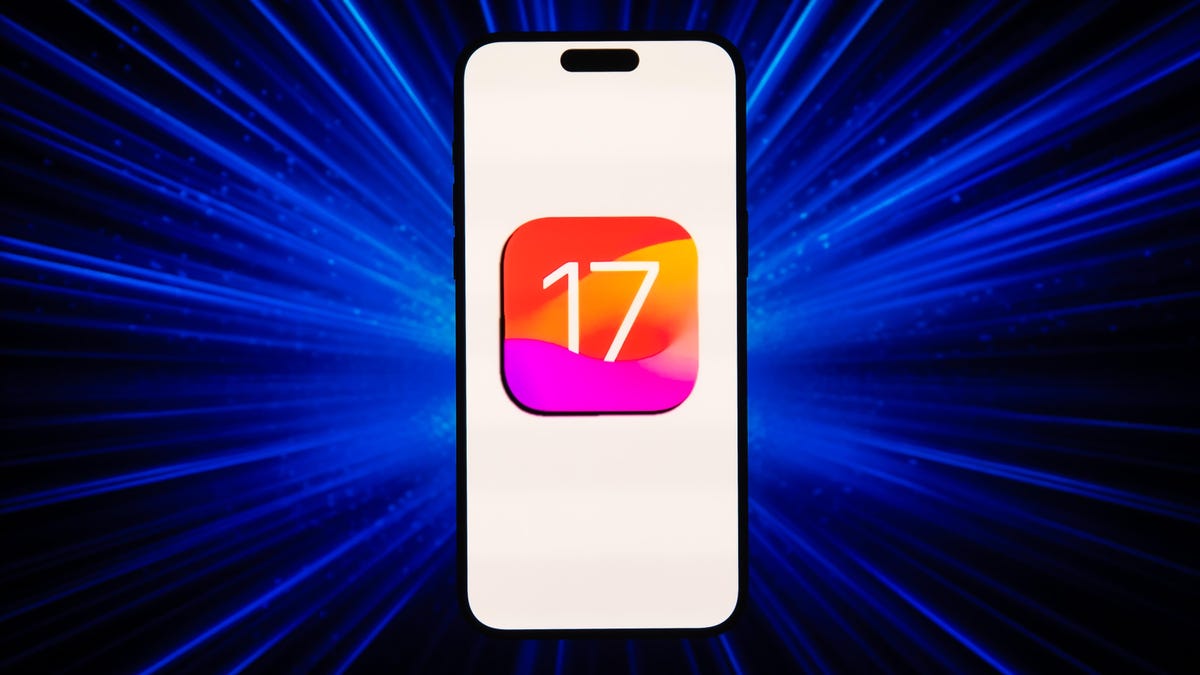
Do You Know About These 17 Hidden iOS 17 Features?

AI or Not AI: Can You Spot the Real Photos?
25 Best Star Trek Ships, Ranked

Your changes have been saved
Email is sent
Email has already been sent
Please verify your email address.
You’ve reached your account maximum for followed topics.
One of the most popular sci-fi television shows of all time, Star Trek , has been enthralling fans for decades. In recent years, the property has come back with a vengeance. The Prime timeline is in full effect, and multiple spinoffs have made their way to Paramount+.
While Star Trek is known for its big idea sci-fi, it also features some great space battles. The starships of Star Trek are some of the most powerful in all sci-fi, armed with powerful weapons and great designs. From the well-known vessels like the USS Enterprise to the lesser-known ships that appeared for an episode or two, these ships are as powerful as they are cool.
Updated January 22, 2024, by Joshua M. Patton: The Star Trek universe is vast, with nearly 60 years of history behind it, and with that longevity comes dozens or hundreds of vessels. From the physical filming models used through the 20th century to the all-digital models used in the 21st, these ships are basically characters themselves. If the ships don't "feel" real, then Star Trek doesn't work. This article has been updated to match CBR's current formatting standards and include more information about Star Trek's best ships.
25 The Krenim Time Ship Is a Unique Vessel in Star Trek Lore
Starship details at a glance, star trek: prodigy's connection to voyager, explained.
Star Trek: Prodigy is a new series with new characters in the universe, but the series is directly connected to Voyager through characters and ships.
Star Trek captains go too far at times , something Voyager' s Captain Janeway was known for. However, there was sometimes good reason for that. The Delta Quadrant was a dangerous place, and Janeway dealt with amazing threats. The most dangerous, even more powerful than the Borg or Species 8472, was the Krenim Time Ship.
The vessel was out of synch with time, which kept the crew from aging while also making the ship itself invulnerable to attack. The Krenim Time Ship's main weapon didn't destroy planets; it erased them from the timeline. On top of that, it was armed with powerful chronometric torpedoes and energy weapons. The Krenim Time Ship was a nearly unstoppable weapon made to change history.
24 The Species 8472 Bioship Was Unlike Any Ship That Came Before It
Since their introduction into Star Trek canon, the Borg have had their run over the galaxy, able to destroy entire Federation armadas with only one ship. That is until they opened a portal into fluidic space and met Species 8472. This alien race proved a threat unlike any other to the cybernetic collective, as they could destroy Borg ships with relative ease. Biogenetic in nature, the ships of Species 8472 were as resistant to technological attack as the individuals themselves — rendering conventional weapons, transporters, and force fields useless against them.
The Species 8472 bioships could also emit incredible energies in tandem, destroying Borg ships as easily as the Borg destroyed others. When the crew of the USS Voyager formed an alliance with the Borg to fight them, Command Chakotay said he believed the ship itself might be alive. The ship was designed by Steve Burg and was one of the earliest fully computer-generated models used in Star Trek .
23 The Galor Class Warship Was the Face of the Cardassian Fleet
Star Trek: Deep Space Nine 's Sisko and Gul Dukat for one of sci-fi's greatest rivalries . The Cardassians were the show's main villains for much of its run and fans got used to seeing their mainline battleship, the Galor class. This vessel was the backbone of Cardassia's fleet, spearheading its conquest of worlds throughout the Alpha Quadrant after it aligned with the dreaded Dominion.
The Galor wasn't a new ship, but she was a powerful one. The ship wasn't heavily armed compared to something like a Galaxy -class, but its forward disruptor array was extremely powerful. A Galor could do massive damage to targets and could take a beating like few other ships.
22 The Jem'Hadar Fighter Was a Scarab-Like Fighter That Packed a Wallop
Jem'Hadar Fighters were the mainline vessel of the Dominion Fleet. The Jem'Hadar were a very powerful Star Trek race , and their ships matched their might. Extremely sturdy, their ships could survive a crash landing on a planet and still be flyable with minimal repairs. Armed with phased polaron disruptors, the Jem'Hadar Fighter 's weapons could easily pierce the shields of Starfleet vessels in the early days after their first confrontation.
Over time, the efficacy of the ship's weapons and shields went down after Sisko and his crew captured one to be studied. Still, a group of Jem'Hadar Fighters was still dangerous to just about any single ship in the allies' repertoire. The ship was designed by Jim Martin, influenced by Rick Sternbach's Egyptian-scarab flavored designs. John Eaves also did the mockup of the full ship that appeared in Star Trek: Deep Space Nine Season 5, Episode 2 "The Ship."
21 The D'deridex Class Warbird Revealed How the Romulans Upped Their Game
Star trek: insurrection's first villains help the movie make better sense.
Star Trek: Insurrection failed to land like the filmmakers wanted, but the inclusion of regular The Next Generation villains would've helped it soar.
Star Trek: The Next Generation showcased powerful threats , including the return of the Romulans. The main vessel of the Romulan Star Empire's fleet, D'deridex-class Warbirds were massive vessels that dwarfed some of the largest ships the Federation put to space. Powered by a forced quantum singularity, these battlecruisers were armed to the teeth with multiple disruptor arrays and photon torpedo tubes.
Like most Romulan vessels, D'deridex-class Warbirds were equipped with cloaking devices, which was a pretty scary proposition — a vessel with the size and power of a D'deridex being able to sneak behind enemy lines undetected and wreak havoc is something any good commander would fear.
20 The Narada Is a Mining Vessel That Doubles as a Warship
As seen in the first of three Star Trek reboot movies starring Chris Pine in 2009, The Narada is a Romulan vessel from the late-24th century. After pursuing Ambassador Spock through a black hole, it arrives in the middle of the 23rd century and continues its relentless vengeance mission against the Federation and its allies.
Though it's a fairly safe bet that in its own time, The Narada is not an exceptionally powerful ship when compared to its peers, that's not the case in the 23rd century. Shortly after its arrival it destroys an entire planet (as well as a starship or two) and it's more than deserving of a place on this list. While not mentioned in the film, subsequent materials and the novelization revealed this ship was made from repurposed Borg technology, which is why it was so powerful.
19 The Excelsior Class Eventually Replaced the Original Constitution Class
Ship design was always important to Star Trek 's success , and Connie set up the most common design: primary saucer hull connected to the secondary hull, which contained the engines and power systems. The Excelsior was designed to replace the Connie , taking advantage of years of research and development. The Excelsior was built around the new transwarp drive, dubbed "the Great Experiment" by Starfleet, but the project's failure meant it would be years before the Excelsior replaced the reliable Constitution Class.
The Excelsior was an improvement on the Connie in every way — better sensors, better computers, and better defenses. The ship was armed with multiple phaser batteries and torpedo launcher, allowing the ship to cover itself with 3-D firing arcs at nearly every angle. The Excelsior would eventually fulfill its destiny of becoming the main heavy cruiser of Starfleet. It remained in use for over a hundred years, forming the backbone of Starfleet through the Dominion War and beyond, as the class got another refit in the late 2390s/early 2400s.
18 The Miranda Class Starship Was a Versatile Vessel for Starfleet
The Miranda Class starship is the backbone of the Federation fleet for a reason. First introduced in Star Trek II: The Wrath of Khan , it has since appeared in many movies and television series tied to the franchise. The ship itself has a solid array of weaponry, if nothing truly out of the ordinary, and it can more than hold its own against standard classes of enemy ship.
A fun fact about the ship's design is that it was actually meant to be the other way round, but Wrath of Khan producers looked at it upside down. When the error became clear, they decided they preferred it that way. The repurposed Constitution class design was used to save money since the film had a slim budget.
17 The Sarcophagus Was a Klingon Ship of the Dead
Why klingons look different from discovery to strange new worlds.
Strange New Worlds revisits Starfleet's aversion to genetic modification, but the Klingons in the series may be a product of that outlawed science.
The terrifyingly named Ship of the Dead or the Sarcophagus is actually used to transport the preeminent Klingon House of T'Kuvma. The ship was more than 200 years old, and the bodies of slain Klingon warriors are entombed on its hull. It serves as the main ship for their forces during the Federation-Klingon War depicted in Star Trek: Discovery .
The ship packs a heck of a punch and has guns capable of turning the entire surface of a mid-sized, habitable planet into a barren wasteland. It also has spectacular cloaking abilities and is around three times bigger than even the biggest ships in the Federation fleet. It's a truly intimidating leviathan to come up against.
16 The Jem'Hadar Battleship Was Larger Than the USS Enterprise-D
The Jem'Hadar Battleship was the largest vessel in the Dominion fleet and the most feared, which is saying something considering just how powerful Jem'Hadar vessels are. Armed with multiple polaron disruptor batteries and torpedo launchers, the Jem'Hadar Battleship was not just one of the most powerful Dominion vessels but one of the most powerful vessels in the galaxy.
Extremely hard to damage, a Jem'Hadar Battleship taking the field was met with apprehension. Twice the size of a Galaxy- class and three times as powerful, no ship that any of the allies fielded could hurt it in a one-on-one battle.
15 The Curiosity Class Was a Small, but Mighty, Advanced Starfleet Vessel
Star Trek: Picard was chock-full of nostalgic moments and exciting developments as it charted new territory in the 24th century. Without a doubt, the arrival of William Riker and the USS Zheng He at the head of a Federation fleet was one of those pulse-pounding moments viewers cheered for. It also was one of the most massive assemblage of vessels seen in Star Trek .
Primed to save Captain Picard from a Romulan fleet that was threatening to destroy him, the USS Zheng He had an imposing appearance. A new, Curiosity class vessel, Riker touted the Zheng He as “the toughest, fastest, most powerful ship Starfleet ever put into service.” Although it was never seen in action, it’s reasonable to assume it’d be more advanced than any ship that came before it.
14 The Akira Class Vessels Were Fast, Sleek Fighters
The Akira Class was commissioned in the 2370s and was part of the Federation's initiative to field more ships with the main purpose was fighting. It was basically a torpedo boat that had its dorsal weapons pod armed with a large amount of fore and aft torpedo tubes.
The Akira Class even has port and starboard tubes, almost unheard of on Starfleet ships. Like most Starfleet vessels, it also is armed with phasers. The Akira also had fore and aft launch bays, making it an ideal launch platform for Starfleet attack ships. Fast and maneuverable, it could bring a disproportionate amount of power to bear for its size. The ship got its name from the anime film, Akira .
13 The Jem'Hadar Battle Cruiser Was a Near Unbeatable Ship
Why 'in the pale moonlight' is an important ds9 episode.
There are many wonderful episodes of Star Trek: Deep Space Nine, but Season 6's 'In the Pale Moonlight' is perhaps the most important one in the show.
The Jem'Hadar Battle Cruiser was the larger cousin of the Jem'Hadar Fighter and a formidable vessel in its own right. Not seen until after the Cardassian-Dominion alliance, these large cruisers were armed with the standard polaron beam disruptor batteries that made Dominion ships so powerful, as well as multiple torpedo tubes.
Extremely durable vessels, even one Jem'Hadar Battle Cruiser was considered a substantial threat to Deep Space Nine even after its massive weapons upgrade. They often anchored Dominion lines in battle and could take down even the most powerful allied vessels single-handedly.
12 The Reman Warbird Was a Nemesis to the USS Enterprise-E
Star Trek: Nemesis was a divisive film to fans of The Next Generation , but one thing that was undeniably awe-inspiring was the power of the Reman warbird, the Scimitar . Armed to the teeth, the ship had fifty-two disruptor banks and twenty-seven photon torpedo bays, which allowed it to lay waste to the Enterprise-E and several other ships with ease.
The Scimitar was also heavily armored, able to withstand double the damage other ships could. Its cloaking technology has Geordi LaForge’s stamp of approval as “perfect,” and its thalaron radiation weapon could strip a planet of life in seconds.
11 32nd Century Federation Fleet Is Sleek and Near Magical
Star Trek: Discovery turned its narrative on a dime at the end of Season 2 by transporting its crew from the Kirk era to almost one thousand years in the future. Here, the Federation has been decimated by a phenomenon called “The Burn,” during which all dilithium in the galaxy grew inert and devastated the ships that used them. Using "programmable matter" the nacelles and some saucer sections could appear detached from the main hull.
However, the crew of the Discovery was treated to a tour of a shipyard filled with ships of the 32nd century, including the USS Nog and the USS Voyager-J . Although these ships weren't seen in action, it can be assumed nine hundred years of technological advancement would make them the most sophisticated and powerful ships on this list.
10 The Prometheus-Class Was a Multi-Attack Vessel
How a set fire led to star trek: voyager's funniest episode.
A fire damaged the bridge set on Star Trek: Voyager, the writers went to the holodeck for 'The Bride of Chaotica,' one of series' funniest episodes.
Starfleet's subtle change into a more war oriented power was heralded by multiple new warship designs. This war fleet was first meant to defend against the Borg, but the Dominion's threat kept them making ships made for war, including the Prometheus class. However, this ship wasn't just kitted out with the latest in weapons and shield technology.
The Prometheus class was created around multi-vector attack formation. The ship split into three, and was suddenly three times the threat it was before. The USS Prometheus could single-handedly destroy a D'deridex class ship with multi-vector attack mode, using only phasers. That's a powerful ship and a great weapon in Starfleet's arsenal.
9 The Defiant Class Was Starfleet's First Warship
Star Trek: Deep Space Nine is amazing , and it got better when the USS Defiant arrived. The Defiant class was originally designed to fight the Borg and was brought out of mothballs to counter the Dominion threat. Armed with four phaser cannons, three phaser banks, and four forward and two aft quantum torpedo launchers, the Defiant packs a tremendous wallop for a ship of its size.
The Defiant Class had powerful deflectors and ablative armor to make them extremely hard to damage, but their speed and maneuverability also make them very hard to hit. Able to destroy smaller vessels with a few shots with phaser cannons, the Defiant Class turned the tide of the war with the Dominion.
8 The Sovereign Class Signified Starfleet's Turn Towards the Militaristic
The most powerful vessel in Starfleet, the Sovereign class takes all the lessons Starfleet learned and puts them into practice. More powerful after a class-wide refit, the Sovereign class boasted sixteen phaser arrays, a forward quantum torpedo launcher, three forward photon torpedo launchers, and six aft photon launchers.
The Sovereign class was built for a wide variety of missions, like the Galaxy before it, but Starfleet made sure to arm it with the latest in weaponry, allowing it to hold its own against even the most powerful enemy vessels without needing reinforcements.
7 The Borg Cube Is Simplistic and Terrifying
The Borg cube is easily the most powerful ship encountered by any of the Alpha Quadrant powers. Armed with a variety of powerful beam weapons, torpedo launchers, and tractor beams, a Borg cube was more than a match for fleets of ships. In fact, it could destroy multiple ships before they could even scratch it. As the Borg assimilated new species and technology, their vessels were consistently being updated but the basic shape stayed the same.
Equipped with regenerative shielding and the adaptive technology that make the Borg so formidable, the only way Borg cubes have ever been defeated was with computer-based trickery, knowledge from when Captain Picard was assimilated, or future technology. Much from Star Trek' s past holds up , including the power of a Borg Cube.
6 The Shrike Was a Sinister Vessel for Even More Sinister Villains
Star Trek: Picard gave viewers several amazing ships, and one that grabbed fans' attention was the Shrike. Commanded by the changeling Vadic, this warship had an eye-catching design, with four claw-like protrusions extending forward from its body, giving it a fierce, insectoid look. It was also armed to the teeth.
Vadic allowed the Titan to scan them, revealing the Shrike 's armament comprising forty isolytic burst warheads, eighty-eight plasma torpedoes, two hundred thirty-six photon torpedoes, eighteen anti-matter missiles, twenty pulse wave torpedoes, and an unknown number of directed energy weapons. On top of that, the Shrike was equipped with a portal weapon, which could transport ships it engaged through space into more vulnerable positions.

Reference Tables
Updated August 18, 2024
When I first started making my starship comparison charts, I gave little thought to documenting my references. I just wanted to see the ships side-by-side! But over the years, the Star Trek Minutiae reference charts have been shared widely on social media and have even been referenced (sometimes erroneously) by official sources. To help provide the most accurate information possible, these tables provide sources for the size of the ship and credit for the artist (where known) who created the image that is used in the chart. If any ship image is used with missing or incorrect credit, please let me know !

Star Trek (all series)
Entries marked [NC] denote non-canon ships.
2001: A Space Odyssey
Battlestar galactica (1978), battlestar galactica (2003), close encounters of the third kind, dune (2000), the expanse, for all mankind, forbidden planet, galaxy quest, independence day, interstellar, the last starfighter, marvel cinematic universe, the orville, silent running, space battleship yamato ( star blazers ), space: 1999, space: above and beyond, starship troopers, war of the worlds (1953).
- More to Explore
- Series & Movies
Published Jul 5, 2021
The Fleet's In: 24th Century Federation Starships
Does your favorite ship make the cut?
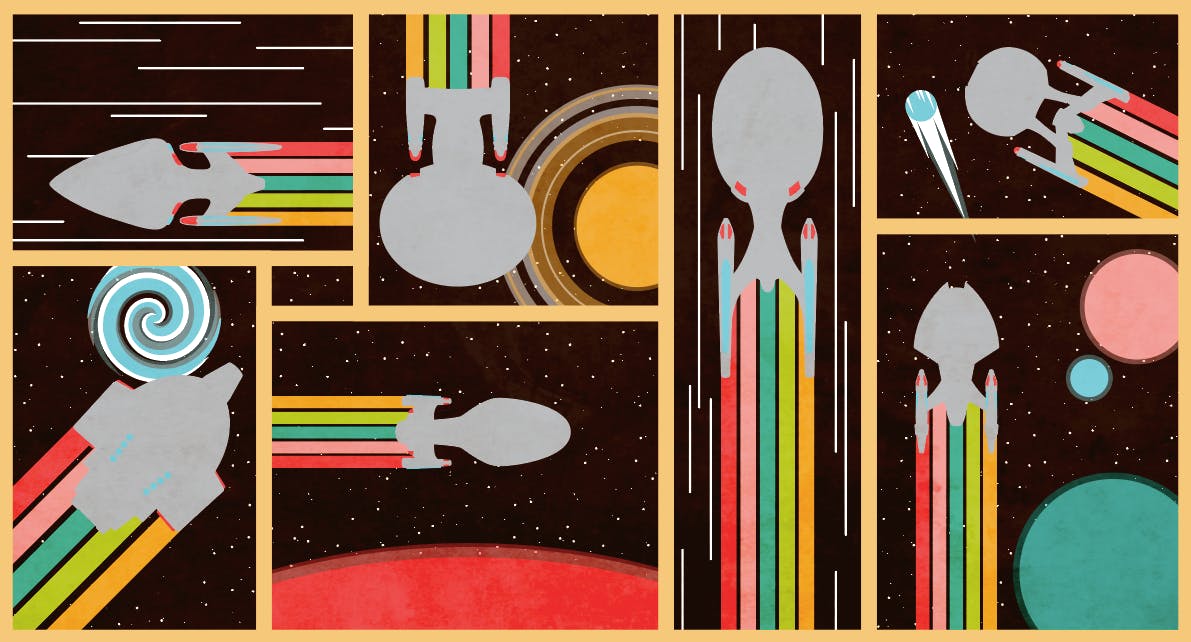
StarTrek.com
For those of us who lovingly refer to ourselves as “starship nerds,” Star Trek 's 24th century is populated with an astounding array of Starfleet vessels for us to gaze upon with awe. The series and films set in this era, namely Star Trek: The Next Generation , Star Trek: Deep Space Nine , Star Trek: Voyager , Star Trek: Picard , and the four movies helmed by the TNG crew, produced vast fleets that demonstrated the Federation's prestigious shipbuilding capabilities.
Narrowing down choices, and ranking my favorites proved difficult enough, so we have excluded 23rd century holdovers (so no Excelsior -, Miranda -, Constellation -, and Oberth -class staples), non-Starfleet vessels such as Ambassador Spock's craft from Star Trek (2009) , the relatively diminutive Danube -class runabouts, and auxiliary shuttles. With that in mind, let's take a look at the ships that have been deployed from Utopia Planitia, Riverside, Beta Antares, Eridani A, and other Federation fleet yards.
10. Nova -class in Voyager

When the Nova -class U.S.S. Equinox first popped up on U.S.S. Voyager 's sensors in “Equinox,” Captain Janeway noted that the starship was a planetary research vessel designed for scientific missions rather than long-range tactical excursions. The Nova -class bore streamlined similarities to its larger Intrepid and Sovereign -class cousins, but its limited scope and small crew left it vulnerable to a lonely jaunt through the Delta Quadrant. If Captain Ransom had commanded a sturdier vessel, perhaps he would not have resorted to the deplorable tactics he employed to find a faster route home. However, the design apparently stood an excellent chance of enduring, as Captain Harry Kim sat in the center seat aboard the Nova -class variant U.S.S. Rhode Island in the alternate future seen in “Endgame.”
9. Ambassador -class in The Next Generation and Deep Space Nine

The U.S.S. Enterprise-C remains the most well known Ambassador -class vessel due to its namesake, its prominence in the classic “Yesterday's Enterprise,” and its valiant rescue of the Klingon outpost on Narendra III from Romulan aggressors. Variants of this starship also notably appeared in Captain Picard's blockade during the Klingon Civil War, at the Battle of Wolf 359, and as a transport in “Data's Day.” The explorer's design proved to be an elegant mid-point between its Excelsior -class predecessors and Galaxy -class successors, and it would have been wonderful to see the vessel show up on a more frequent basis.
8. Prometheus -class in Voyager
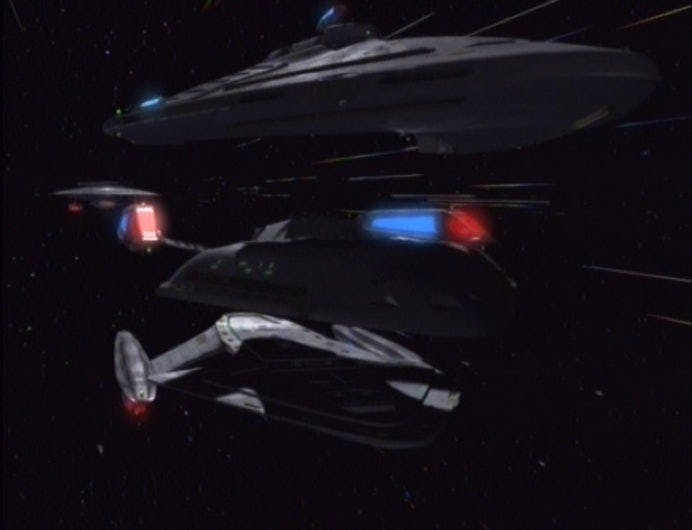
Who can forget the stunning sight of the prototype U.S.S. Prometheus becoming three independent vessels as it separated into multi-vector assault mode during “Message in a Bottle?” The Prometheus 's computer and resident EMH informed Voyager 's doctor that the advanced ship was intended for deep space tactical assignments and could achieve speeds faster than any other member of the fleet. The pair of holographic physicians managed to wrest control of the Prometheus from Romulan hands and deploy its experimental defensive systems against Tal Shiar warbirds. While it is unknown if further Prometheus -class ships were constructed, the prototype was spotted again as part of the armada sent to intercept the Borg sphere in “Endgame.”
Star Trek Ships of the Line — U.S.S. Prometheus
7. Akira -class in Star Trek: First Contact , Deep Space Nine , and Voyager
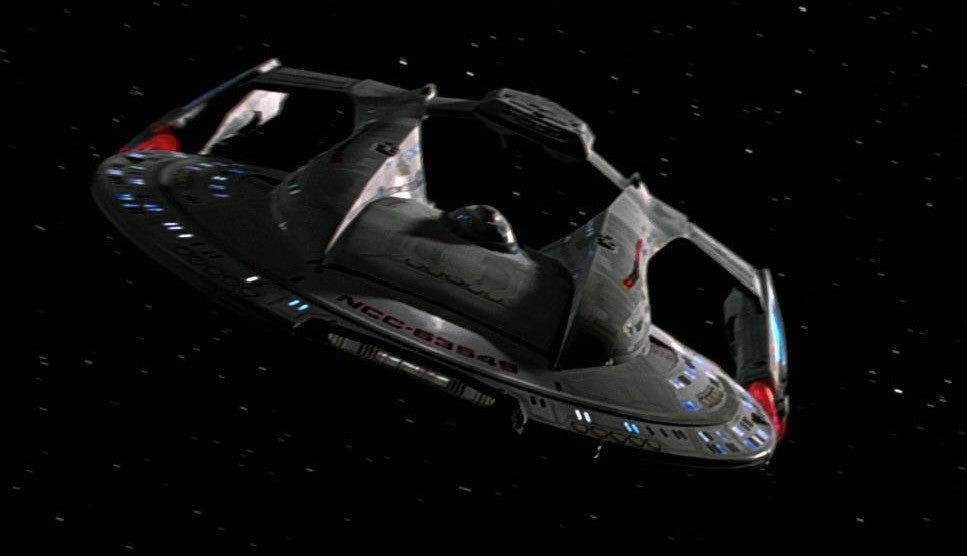
First seen on screen in the Battle of Sector 001, the Akira -class's earliest chronological appearance occurred during a flashback at the Utopia Planitia shipyards in the Voyager episode “Relativity.” While no single starship of this design ever received an excessive amount of attention, numerous Akira -class vessels substantiated their worth in battle during the height of the Dominion War. From retaking Deep Space 9 in “Sacrifice of Angels” to assaulting Cardassia in “What You Leave Behind,” these resilient craft evidently became an instrumental element in Starfleet's defense forces by the end of the 2370s.
6. Inquiry -class in Picard
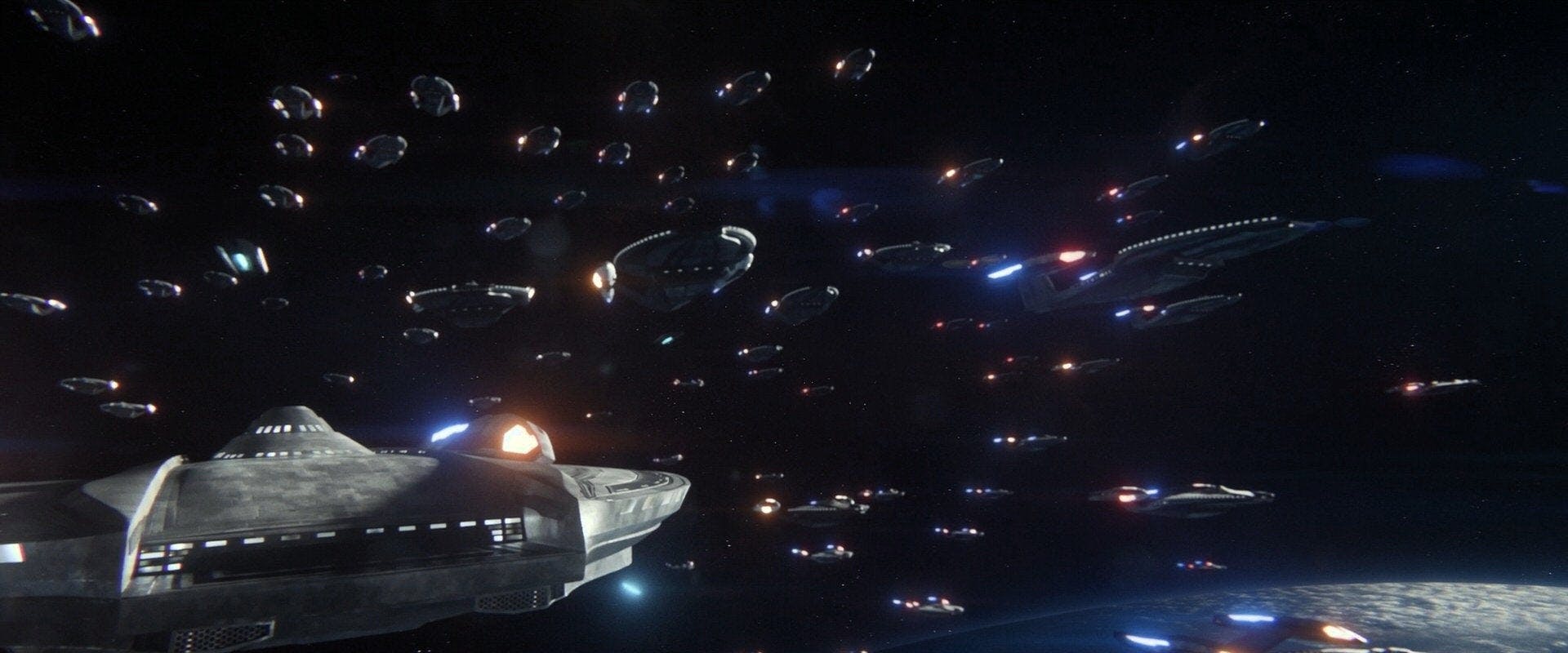
The imposing task force led by Captain Riker above Coppelius was composed of Inquiry-class vessels, including Riker's own U.S.S. Zheng He . Representing the most up-to-date Federation design of the 24th century, the reinstated captain described these ships as the toughest, fastest, and most powerful ones that Starfleet had ever produced up until that time. Although the entire fleet that confronted the Romulans in the Ghulion system fell into the Inquiry-class designation, there seemed to be two variants with differing nacelle configurations present. A whole armada of vessels more advanced than either the Galaxy - or Sovereign -classes? Now that is a majestic view to behold. I'd love to see a rundown of the entire roster of over 150 ships (by my latest count) that participated in Riker's defense formation.
5. Nebula -class in The Next Generation , Deep Space Nine , Voyager , Star Trek Generations , and Star Trek: First Contact
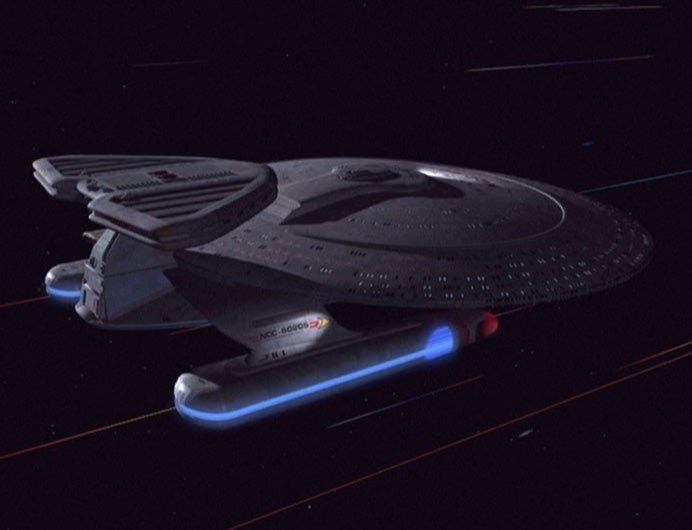
With primary hulls resembling those of its Galaxy -class counterparts, the Nebula -class explorers were featured heavily across multiple series and movies. Captain Maxwell demonstrated their tactical prowess as the U.S.S. Phoenix overwhelmed Cardassian targets in “The Wounded,” Data assumed temporary command over the U.S.S. Sutherland in “Redemption II,” the U.S.S. Farragut aided the U.S.S. Enterprise-D 's crew on Veridian III, and Professor Seyetik's U.S.S. Prometheus conducted solar experiments in “Second Sight.” The Nebula -class's diverse mission profile and extensive use over the years helped it secure such a high rank on our list.
4. Sovereign-class in Star Trek: First Contact , Star Trek: Insurrection , and Star Trek Nemesis

With its on screen credits confined to the U.S.S. Enterprise-E 's roles in the final three TNG films, the beautifully-fashioned Sovereig n-class is often considered to be an underutilized design by starship aficionados. However, given the class's appearances on background LCARS graphics in DS9, I would love to imagine that many Sovereigns were built and saw service somewhere just off-camera during those epic Dominion War battles. Geordi La Forge considered the Enterprise-E to be Starfleet's most advanced ship in 2373, and the new Federation flagship lived up to its reputation in engagements with the Borg, Son'a, and Praetor Shinzon's Scimitar . While not as voluminous as the Enterprise-D , Picard's latest command maintained a larger-than-life presence as it warped across the quadrant to extinguish diplomatic and strategic brush fires.
3. Defiant -class in Deep Space Nine , Star Trek: First Contact , and Voyager
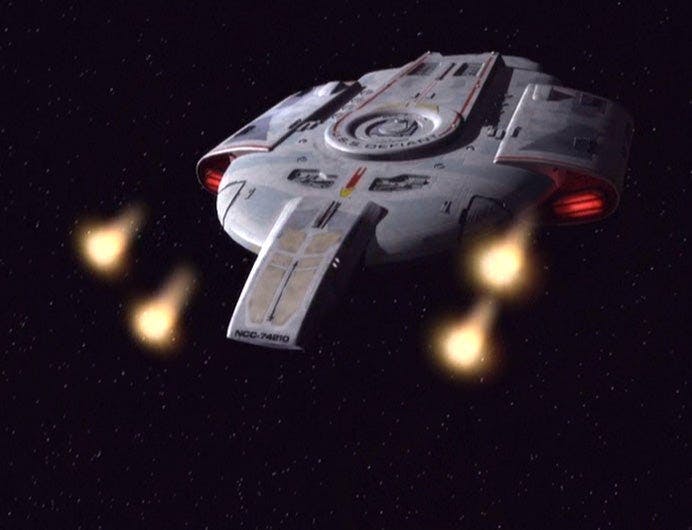
Riker's legendary quip about a “tough little ship” perfectly encapsulates the Defiant -class's ability to contain such overpowered weapons and defensive shields within such a small spaceframe. Originally developed to combat the Borg (which the U.S.S. Defiant bravely did under Worf's leadership at the Battle of Sector 001), Captain Sisko's beloved flagship ultimately earned its fiercest accolades in clashes against the Jem'Hadar both before and during the Dominion War. The only member of Starfleet to be (unofficially) considered a warship and (legally) equipped with a cloaking device, the Defiant withstood everything that was thrown at it... until a Breen energy-dampening weapon brought about its untimely end. The U.S.S. São Paulo , fittingly renamed in honor of its sister ship Defiant , allowed Sisko to oversee the Dominion's final defeat at Cardassia from a familiar bridge.
2. Intrepid -class in Voyager and Deep Space Nine
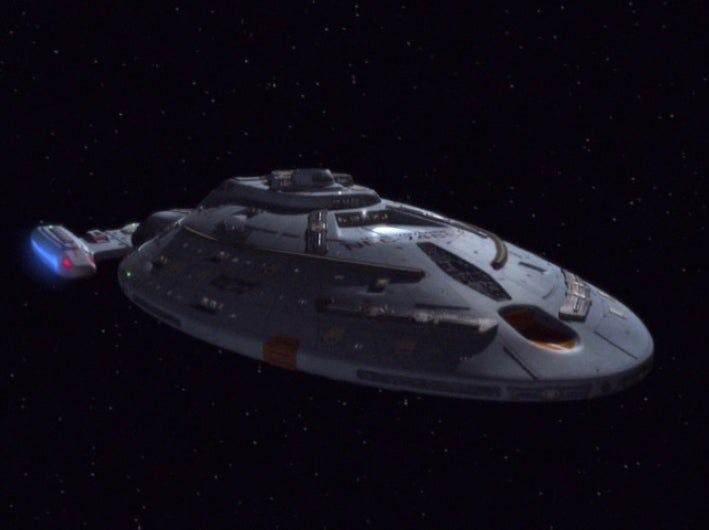
Home to Captain Janeway and her crew for their entire venture through the Delta Quadrant, U.S.S. Voyager pioneered Starfleet's use of bio-neural circuitry, the Emergency Medical Hologram, and a warp core that managed a top cruising speed of warp 9.975. Of course, Voyager also reaped the unique benefit of Seven of Nine's Borg database, a valuable library that permitted them to add a finely-tuned astrometrics lab and the Delta Flyer to the ship's already impressive complement. Voyager' s capacity to outlast everyone from the Hirogen to the Devore in a firefight while still completing countless scientific surveys and first contact missions served as a testament to its durability. When Admiral Ross visited Romulus during the height of the Dominion War, even the high-ranking officer opted to travel on the Intrepid -class U.S.S. Bellerophon rather than any other craft.
1. Galaxy -class in The Next Generation, Deep Space Nine, Voyager, Picard , and Star Trek Generations
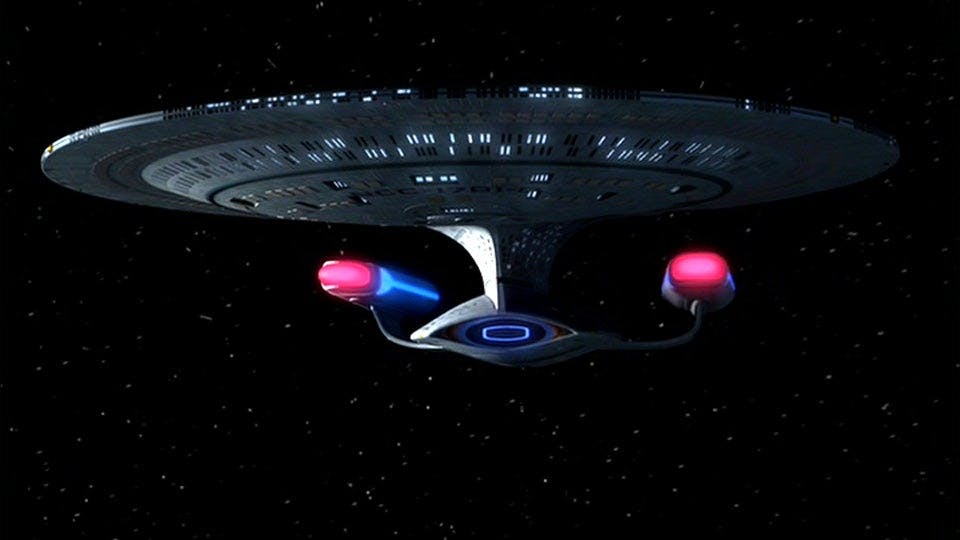
In what is sure to become a controversial decision, the Galaxy -class explorer tops our list of incredible Federation vessels. Despite early concerns over potential design flaws, the Enterprise-D and its sister ships acquitted themselves admirably from TNG's opening moments through Voyager 's return to Earth. Whether hosting dignitaries or being transported to regions beyond the Milky Way's confines, the Enterprise-D acted as a home and refuge for its crew and their families. Although the U.S.S. Odyssey fell in the Federation's first skirmish with the Jem'Hadar, other Galaxy-class starships held the line against the Dominion throughout the war. In the alternate version of 2390 depicted in “Timeless,” the U.S.S. Challenger remained in service under Captain Geordi La Forge. If the Galaxy -class is good enough for Starfleet's most accomplished 24th-century engineer, who am I to disagree?
Star Trek Ships of the Line — U.S.S. Enterprise
Jay Stobie (he/him) is a freelance writer who contributes articles to the official Star Trek website and Star Trek Magazine, as well as to Star Wars Insider and the official Star Wars website. Jay also serves as a part-time assistant and consultant advising many actors and creatives who work on his favorite sci-fi shows and films. He can be found on Twitter and Instagram at @StobiesGalaxy.
Star Trek: Picard streams on Paramount+ in the United States, n Canada on Bell Media’s CTV Sci-Fi Channel and streams on Crave, and on Amazon Prime Video in more than 200 countries and territories.
Get Updates By Email
Star Trek: The 12 Most Important Ships In Federation History, Ranked
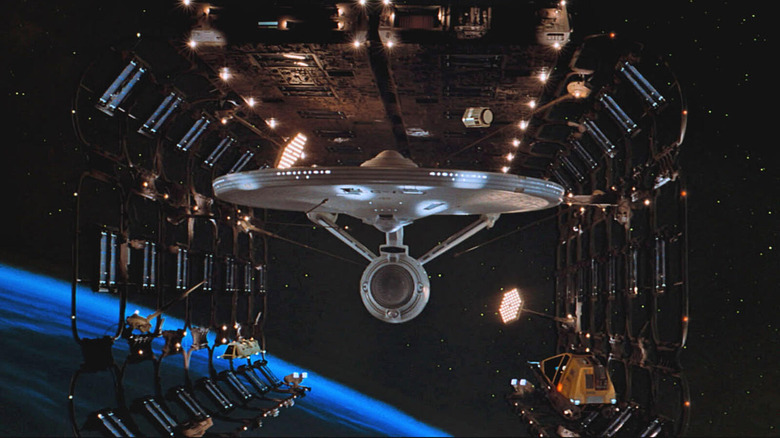
The "Star Trek" franchise, for more than 55 years, has defined mainstream science fiction in the United States with its utopian vision of the future. Created by Gene Roddenberry, "Star Trek" — which spans numerous television series and feature films — follows the United Federation of Planets and its spacefaring force Starfleet as they explore the galaxy. Boasting a wide armada of unique vessels to keep the peace and invite other civilizations into its ranks, Starfleet's starships have taken on a fan-favorite legacy of their own. Capable of traveling faster than the speed of light, these starships also are equipped with weaponry to take on the most fearsome threats in the cosmos.
Check out this comprehensive ranking of the 12 most important starships in Federation history throughout the "Star Trek" franchise. The ranking — not based on the quality of the shows or movies, and certainly not their penchant for action – addresses their place in making the Federation what it is in-universe.
12. USS Cerritos NCC-5567
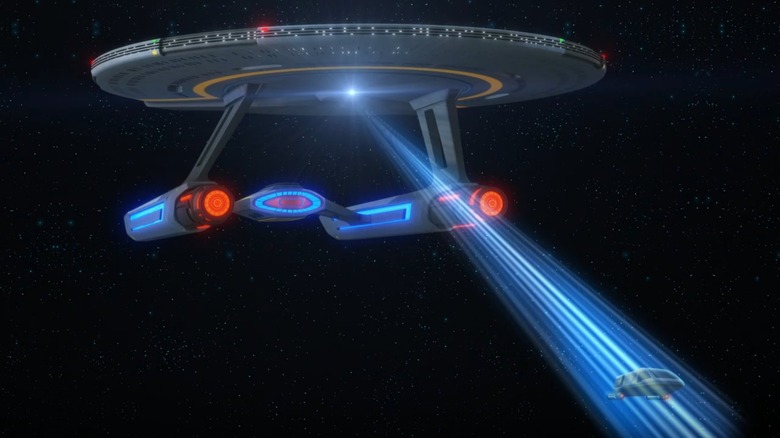
The animated series "Star Trek: Lower Decks" centers on the low-ranked Starfleet personnel who handle the organization's more menial tasks. Their duties include carrying out routine maintenance, cosmic clerical work, and other thankless jobs. Such assignments tend to fall to the crew members aboard California-class starships, including the overlooked men, women, and aliens who serve on the USS Cerritos NCC-5567, the main vessel on "Lower Decks." Fortunately, in addition to poking fun at "Star Trek" tropes , "Lower Decks" explores the notion of overcoming expectations, with the Cerritos' ensigns rising above their assumed stations — along with their ship.
Because of all its wacky hijinks, among them foiling a terrorist plot targeting the Federation, the Cerritos has reached legendary status among California-class starships by Season 3. The Cerritos' impressive reputation plays a pivotal role in the third season finale, rallying other California-class starships to stop a rogue artificial intelligence from attacking Starfleet. "Lower Decks" is all about the ideas that no task is too small or unimportant and that the little guys deserve respect too. And as the California-class ship leading the charge, the Cerritos earns the right to stand among its more nominally elite counterparts.
11. USS Enterprise NCC-1071-A
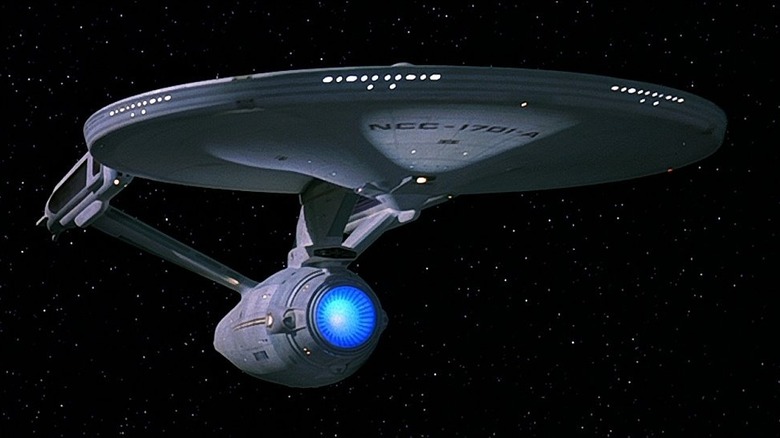
The Klingons destroyed the original Constitution-class Enterprise during a showdown in "Star Trek III: The Search for Spock." It seems only fitting that its replacement, the USS Enterprise NCC-1701-A finally facilitates an armistice between the Federation and Klingon Empire. The swan song for the "Original Series" crew, "Star Trek VI: The Undiscovered Country" finds Captain Kirk leading a diplomatic mission to broker peace with the Klingons. However, a conspiracy poised to plunge Starfleet and the Klingon Empire back into an active war threatens this unprecedented cooperation between the two rival governments.
The Klingons rank as one of the bitterest enemies the Federation has ever faced, nearly conquering them outright during "Star Trek: Discovery." Peace between the two seemed inconceivable but, despite everything the Klingons cost him personally, including his only son, Kirk makes an armistice possible. This alliance not only brings the two governments together but saves them from the Dominion during "Star Trek: Deep Space Nine." The Enterprise-A also confronts a powerful entity masquerading as God in "Star Trek V: The Final Frontier" but the less perhaps said about that adventure, the better.
10. USS Protostar NX-76884
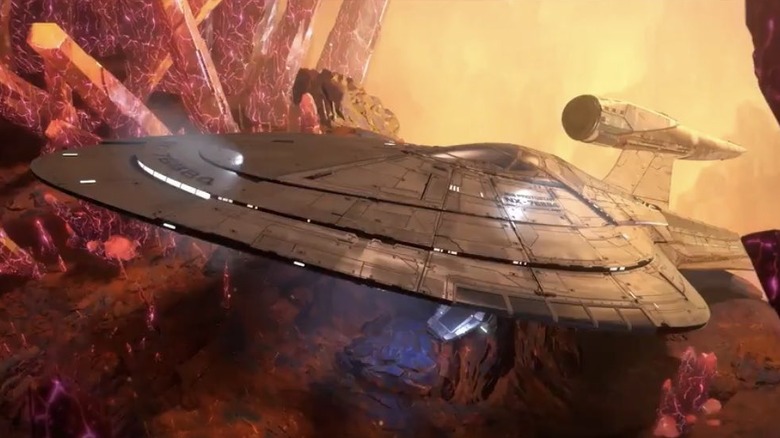
The USS Protostar NX-76884, the main starship from the CG-animated series " Star Trek: Prodigy ," has already left its mark on the Federation, though certainly not as intended. A spacefaring prototype, the Protostar's warp drive is complemented by the inclusion of an experimental proto-drive, powered by an actual, small protostar. When fully powered, the proto-drive allows the starship to travel to different quadrants around the galaxy in an instant, exponentially faster than warp drive-propelled starships. Chakotay initially captained the Protostar, doing so until before he and the starship were captured by the villainous Diviner, with a ragtag crew of refugee children reclaiming it.
The scientific breakthroughs behind the Protostar alone warrant its appearance on this list but its role in Prodigy's first season finale makes it an infamous inclusion. While under the Diviner's control, the Protostar is infected with an advanced computer virus acting as a Trojan horse for any Federation systems with which it interfaces. Once infected, defensive systems go out of control and attack any other Federation targets in the immediate area. While the Protostar crew stops the virus' spread, it infects and devastates a significant portion of Starfleet's armada, transforming the Protostar into the fleet's deadliest vessel.
9. USS Titan NCC-80102-A/USS Enterprise NCC-1701-G
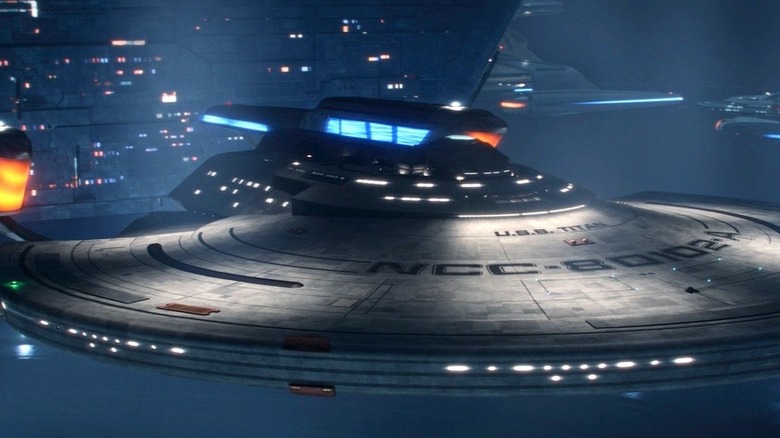
The Protostar and Cerritos incidents are far from the only times Starfleet has nearly been destroyed from within. The final season of "Star Trek: Picard" reveals the remnants of the Borg Collective and the Dominion have formed an alliance to infiltrate and annihilate the Federation. Using Borg technology, Changelings modify Starfleet transporters to secretly assimilate younger personnel, creating sleeper agents across the armada. The ship that uncovers this far-reaching conspiracy? The USS Titan NCC-80102-A, with nominal Captain Liam Shaw led by Admiral Jean-Luc Picard.
The Titan plays a pivotal role in distracting the assimilated armada from bombarding Earth's planetary defenses, giving Picard and the Enterprise-D valuable time to disrupt Borg communications. Though the Titan is disabled by the opposition, without its diversion, the fleet would have proceeded to bomb Earth's major cities before spreading their devastation across the galaxy. The Enterprise-D may get the glory for ultimately defeating the Borg and saving the day, but Titan merits recognition for playing good defense single-handedly. In the "Picard" series finale, the powers that be rechristen the Titan-A as the USS Enterprise NCC-1701-G , cementing its importance and heroic legacy.
8. USS Discovery NCC-1031
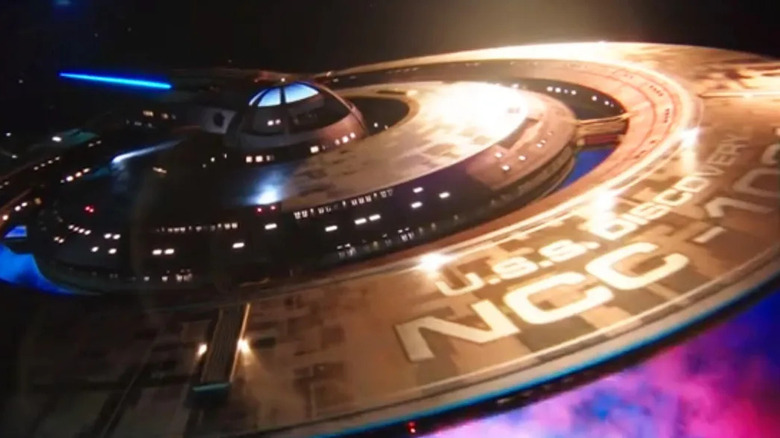
Across the Federation's entire history, the USS Discovery NCC-1031 rates as the most unique starship, thanks to its Spore Drive. A sentient set of spores within the Discovery's engineering section interface with Chief Engineer Paul Stamets, allowing the ship to leap through subspace. More than simply traversing great distances in an instant, the Spore Drive gives the Discovery limited access to the Mirror Universe.
The Discovery not only assumes a pivotal role in stopping the bloody war between the Federation and the Klingon Empire but saves it from an enemy within its ranks. In the Season 2 finale, the Discovery teams up with the Enterprise to destroy Control, a rogue artificial intelligence poised to wipe out all organic life in the galaxy. And just as Discovery preserves the Federation's existence in the relative present, it also restarts its legacy in the far future. Transported more than 900 years into the future, the Discovery inspires the Federation to rebuild itself from a massive catastrophe, restoring its ideals across the stars.
7. USS Enterprise NCC-1701-E
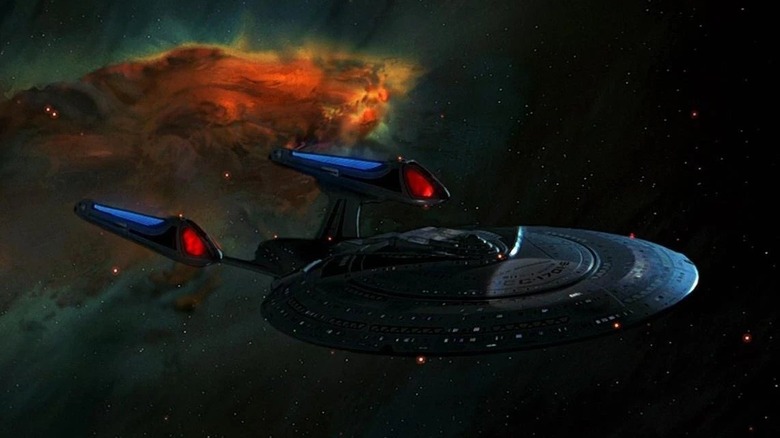
Just as Kirk commanded two starships with the Enterprise moniker, Picard gets his second Enterprise in the 1996 film "Star Trek: First Contact." Commander Will Riker describes the Enterprise-E as the most advanced in the entire fleet and one better outfitted for combat than its predecessor. While not as prolific as the Enterprise-D, the ship spares the Federation total defeat on at least two separate occasions. The Enterprise-E also uncovers a conspiracy within Starfleet Command in "Star Trek: Insurrection," exposing a group undermining the Federation's principles.
The Enterprise-E's superior weaponry and Picard's intimate knowledge of the Borg save Earth and the defending Starfleet armada from the Borg Queen. This timely intervention also involves the Enterprise-E following the Borg into the 21st century to defeat them and ensure the preservation of humanity's history. Later, the Enterprise-E takes point in brokering a landmark peace agreement with the Romulan Empire in "Star Trek: Nemesis." With no armistice achieved without significant complications, the Enterprise-E takes down a rogue Romulan warship targeting Earth, proving itself as capable in a fight as diplomatically.
6. USS Voyager NCC-74656
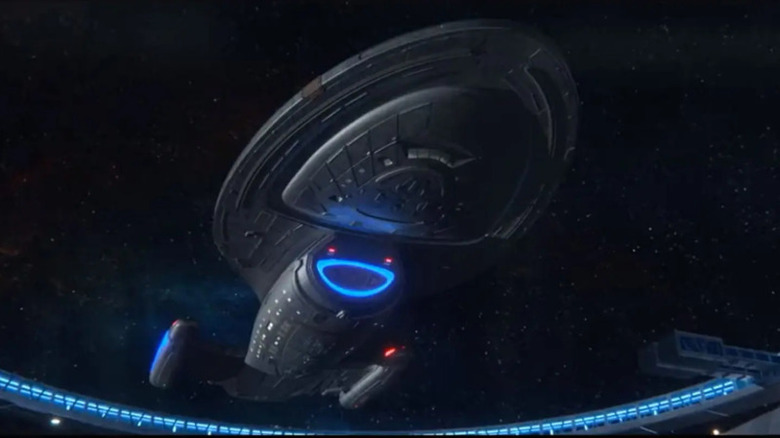
The USS Voyager's most famous mission strands it on the far side of the galaxy, approximately 70 years from home and without Starfleet support. Captained by Kathryn Janeway, it took the starship seven seasons to return to the Alpha Quadrant, exploring the true undiscovered expanse within the Delta Quadrant along the way. Encountering new species and phenomena, the Voyager upgrades itself during its long journey to accelerate its trip significantly. While the sheer amount of exploratory information and technological enhancements are enough to make the Voyager stand out in Starfleet, its final act remains its noteworthiest.
In the last leg of the ship's voyage, Janeway teams up with an alternate future version of herself to destroy the Borg Collective seemingly for good. The older Janeway allows herself to be captured by the Borg Queen, infecting her with a terminal virus that spreads across the Collective. Though the Borg are revealed to survive in a diminished capacity decades later, the incident represents a major victory for the Federation. Voyager not only returned to the Federation with a wealth of new information, but the ship vanquished its greatest foe to deliver an interstellar mic drop.
5. USS Defiant NX-74205
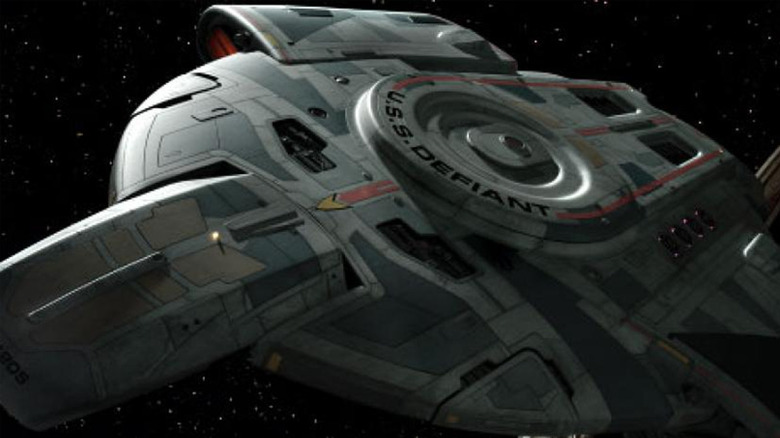
" Star Trek: Deep Space Nine " marks a departure from the franchise's established formula, with its characters not on an exploratory mission but maintaining a strategically located space station. In the third season, the crew welcomes the USS Defiant NX-74205 in order to engage in away missions around the cosmos. As "Deep Space Nine" evolves into a show depicting Starfleet at war, here comes a primary vessel designed specifically for combat. And it boasts not only remarkable maneuverability and a formidable weapons system, but the Defiant is one of the few Starfleet vessels with a functional cloaking device.
The Defiant figures prominently in the Dominion War, outmaneuvering and concealing itself from even the deadliest Jem'Hadar vessels, and playing a major role in Starfleet's eventual victory. After Starfleet temporarily loses control of Deep Space Nine, the Defiant embarks on a series of strikes on vital Dominion targets in the quadrant. Beyond its seek-and-destroy function, the Defiant heads the armada that retakes the station. The original Defiant is destroyed by the Breen in the show's final episodes, with Captain Benjamin Sisko receiving an identical replacement shortly thereafter to finish the fight.
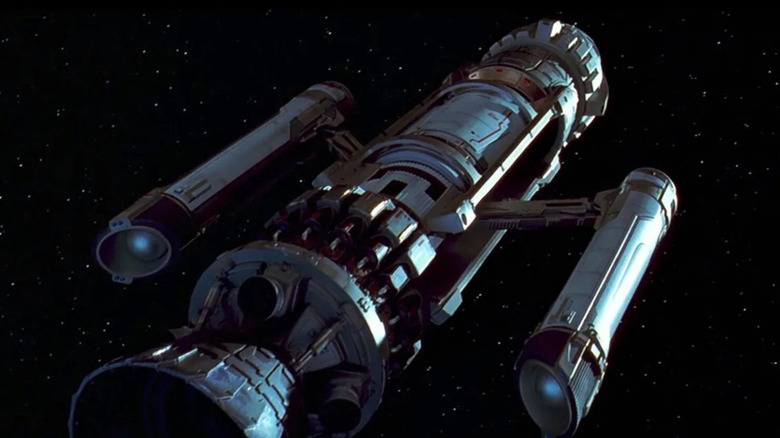
Zefram Cochrane, the most revered figure in 21st-century human history, became the first person from Earth to achieve lightspeed spaceflight. Aboard his makeshift starship, the Phoenix — fashioned from a repurposed Titan II nuclear missile in Montana — Cochrane makes his fateful voyage in 2063, aided by the time-traveling Enterprise-E crew. Vulcans immediately take notice of humans emerging as a warp-capable civilization, prompting them to make first contact with Earth and lay the groundwork for what will become the Federation. After the successful flight, Cochrane continues to improve upon his warp drive designs, with his innovations informing the development of subsequent generations of starships.
Though the flight of the Phoenix occurs well before the Federation's founding, its influence cannot be overstated as it's felt for centuries to follow. The Borg Collective identify the Phoenix's landmark flight as a turning point in the galaxy's narrative, attempting to disrupt it to ensure their domination. More than 300 years later, Beckett Mariner hijacks the Phoenix to gain access to the Cerritos in the "Lower Decks" Season 3 premiere, proving the ship is still mission-ready. Even centuries after Cochrane's disappearance while exploring the cosmos, the Phoenix continues to make history.
3. USS Enterprise NCC-1701-D
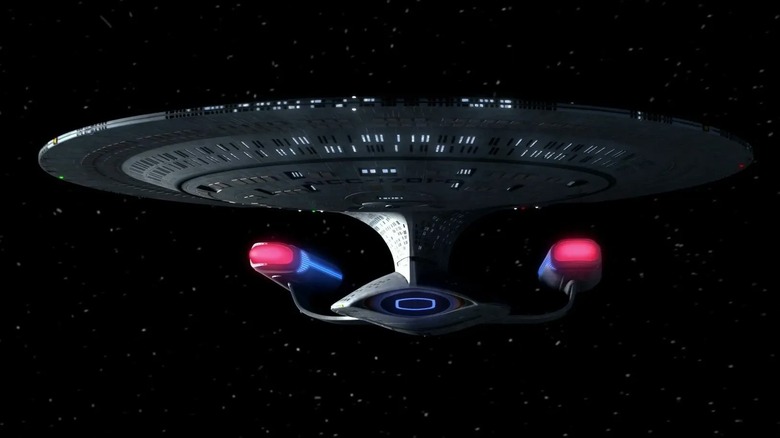
The Enterprise-D may be the fifth NCC-1701 starship to carry the name but it belongs among the most vital in the Federation. Captained by Jean-Luc Picard, the Enterprise-D soars as the main ship in "Star Trek: The Next Generation" and the 1994 film "Star Trek Generations." The final season of "Star Trek: Picard" reveals Chief Engineer Geordi LaForge salvaged the Enterprise-D, quietly repairing it over time to make it fully operational again. This repair job proves instrumental in the Enterprise saving the galaxy once again, adding to its vaunted status within Starfleet.
The Enterprise-D crew are the first ones to rescue the Federation from the Borg, while Picard himself convinces the omnipotent Q that humanity deserves to exist. Much like the original Enterprise NCC-1701 goes out with an anticlimactic bang, so too does the Enterprise-D, scuttled stopping the terrorist Soran from manipulating the Nexus anomaly. Fortunately, the Enterprise-D gets a better, if delayed, swan song in saving the Federation from the resurgent Borg in "Picard." Even decades after its initial service, the Enterprise-D holds a legendary place for the Federation, more than worthy of the value that comes with its name.
2. USS Enterprise NCC-1701
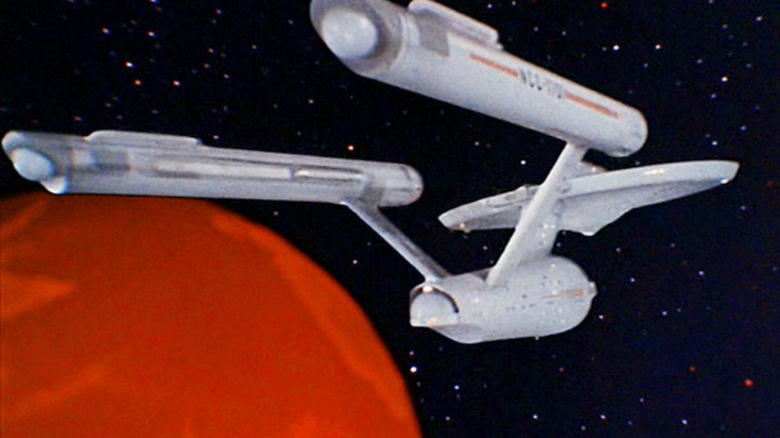
The first Constitution-class Enterprise enjoys a storied history that surpasses that of any other starship in the franchise to date. The original USS Enterprise NCC-1701 appeared as the main ship in "Star Trek: Strange New Worlds," "The Original Series," and the franchise's first three films. Helmed by iconic captains like Christopher Pike and Jim Kirk, the Enterprise is the most important starship of its era. As a testament to the Enterprise's importance being recognized in-universe, no less than seven starships carry the moniker so far.
In "The Original Series" alone, the Enterprise saves the Federation from dozens of enemies and dangerous phenomena that endanger it. From thwarting the Romulan effort to restart their war against humanity to deactivating ancient doomsday machines, the Enterprise stops threats before they grow out of control. This tradition continues on the big screen, with Kirk returning to the Enterprise to save the Federation from an entity barreling toward Earth. This Enterprise is self-destructed in an unauthorized mission at the Genesis Planet to prevent it from falling into Klingon hands, an anticlimactic end to its legendary run.
1. USS Enterprise NX-01
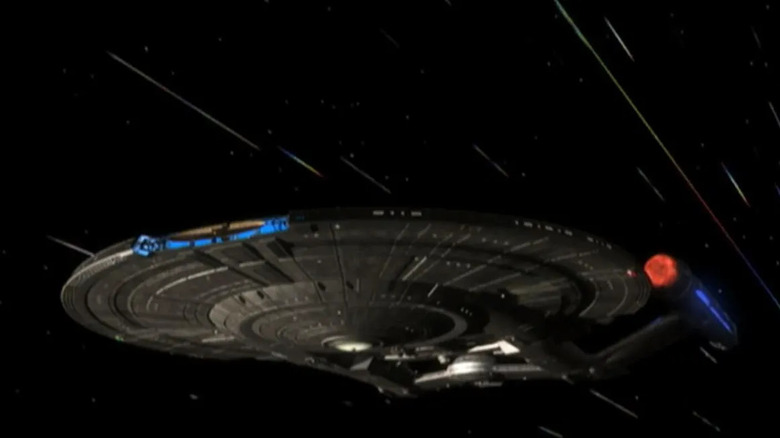
The USS Enterprise NX-01, commanded by Captain Jonathan Archer, leads the way in the decade building to the creation of the Federation. This Enterprise spearheads several technological innovations for Starfleet, including the transporter, universal translator, photonic torpedoes, and phase weapons. The NX-01 plays a crucial role in defending Starfleet in its initial skirmishes with the Romulans and Xindi, revealing that humanity can hold its own in the cosmos.
The impressive exploits of Captain Archer and his crew aside, the NX-01 actually helps facilitate the Federation's formation. It not only brings together a human and Vulcan joint crew for the first time, but the Enterprise draws the Tellarites into the fledgling alliance. These three civilizations form the foundation of what becomes the Federation in 2161, as the NX-01 stands front and center in battles against mutual enemies. A strong argument can be made that without the NX-01, the Federation never exists — and that explains why this starship tops the list.
20 Best and Most Interesting Star Trek Ships
Star Trek is considered a most-watched and followed sci-fi TV. The Federation Starfleet, and other planets in Star Trek boasts many powerful and strong ships.
Star Trek: Motion Picture has been alluring and thrilling fans for many years. The show has returned with retribution in current years, as CBS returned the Prime timeline against the Kelvin timeline of the recent Star Trek movies to secure the streaming service. Kelvin Timeline refers to an alternative quantum Star Trek universe made when Romulan Nero traveled to the year 2233 and wiped out the starship USS Kelvin . The Kelvin timeline doesn’t become visible in canon material. However, it’s CBS Television’s inner name for the changed timeline made by Nero’s assault on USS Kelvin.
Star Trek TV and movies alike feature a lot of spaceships or spacecraft. Different space vessels make the primary setting of the TV series, films as well as the expanded Star Trek universe. They also help advance franchise stories. All through the production of the franchise, spaceships have been portrayed and showed by many physical and computer-generated models. Producers worked to balance often limited budgets with the need to show convincing, futuristic vessels.
Beyond the media appearances, Star Trek spaceships have been markets as models, books as well as rides. Filming models have sold for a huge amount at public auction.
Getting to Know the Best Star Trek Spacecraft
It is very likely that most of us, adults and children, are familiar with Star Trek, both the movies and the TV shows. And what makes this very popular? Maybe because of spaceships! Since ancient times, people have been looking at the sky and dreaming of traveling to the stars.
While this is renowned for its huge sci-fi concept, it still Star Trek has many great and remarkable space fights and battles for fanatics of that kind of thing. Without a doubt, Star Trek ships are some of the most distinctive and powerful in the worlds of science fiction, equipped with a remarkable weapon as well as amazing designs. Follow us as we give you the 20 most popular and interesting spaceships of this franchise. Some of them are also the most powerful Star Trek ships.
1. The Probe
First on the list is the Whale Probe. Probe considered the most powerful and strongest Star Trek spaceships, debilitated and laid up the Federation with no launch of an assault- it was just attempting to communicate. Popular called The Probe, a colossal cylindrical object, which appeared in an early episode of the popular Star Trek IV: The Voyage Home , this managed to exhaust the control as well as life sustain from starbases, ships as well as Starfleet command.
This was the outcome of the dampening field made by its sleeting frequencies- and effort to contact as well as keep in touch with the vanished humpback. Gratefully, a well-times intrusion by Captain Kirk as well as his squad managed to save the day. It has amazing warp speed.
2. USS Enterprise NCC 1701 (Features in Original Film)
USS Enterprise NCC 1701 was launched in the year 2245 and considered the illustrious as well as original starship made in the San Francisco Yards. Enterprise NCC 1701 features in the original Star Trek. This starship was formerly captained by Christopher Pike as well as Robert April prior to coming under the supervision of James T. Kirk . This Enterprise vessel was considered one of the most popular Star Trek starships. Enterprise NCC 1701 was gained its name as the best-renowned spaceship ever seen in Star Trek.
The popularity of this starship is because of its five-year mission. Other USS Enterprise vessels are the NCC 1701-A, NCC 1701-B also features in the first or original series. The Next Generation era featured three ships named USS Enterprise: NCC 1701-C, NCC 1701-D, and NCC 1701-E. We also have Enterprise vessels featured in alternate timelines: NCC 1701-D, NCC 1701-J, and NCC 1701-F.
3. V-Ger Voyager
Without a doubt, V-Ger is the strongest and powerful threat Kirk encountered apart from a thing that might or might not have been God. Some time ago, this was the meek space probe that NASA had launched. That was at the end of the 20th century. On the other hand, a planet pack of machines that some fanatics think might have been a Borg planet made this spacecraft into something mighty.
As a matter of fact, we never witness the outer limits of Voyager’s power. Yes, this ship is able to vaporize ships at will as well as able to create ideal and perfect copies of the team of Kirk. And it seems very likely that, if Kirk and Spock had not handled to assist Voyager to evolve, this could have wiped out all living things on Earth.
4. Jem’Hadar Fighters
Jem’Hadar Fighters is also considered the best and popular Star Trek spaceships in the new series with remarkable warp speed. These were the line spaceship of Dominion Fleet. The very tough and sturdy craft, able to survive hurtle landing and can still fly with just a few repairs. Those fighters, equipped with phased disruptors, could easily pierce the protection or shield of the Starfleet spaceships in the early times after the first fight or confrontation.
On the other hand, in due course, the vessel weapons’ efficiency and the shields subside as Starfleet, and the supporters managed to learn how to cope with them. However, a group of Jem’Hadar fighters was still perilous to any battleship in the allies’ range.
5. Negh’Var-Class (Klingon Warship)
This is one of the popular starships that were considered the biggest warship in the Klingon Defense Force. This was often utilized as a flagship for high-ranking troupes of the Klingon hierarchy. Like most Klingon warships, this one was also armed with many cloaking devices.
As mentioned above, this is considered the most powerful vessel in the fleet of Klingon, and this could stay in one area and destroy enemy starships all around it and worry little about retaliatory strikes. However, in spite of being powerful, this ship also has a weakness, which is when a small and easy to maneuver craft could get in close. However, that is rare to happen.
6. D’deridex-Class (Romulan Warbird)
D’deridex-Class Warbird is considered the main spaceship of the Romulan Star Empire’s fleet. These were gigantic ships that dwarfed the biggest vessels of the Federation in Star Trek space. With high warp speed and cloaking technology, these vessels are also enforced by “ forced quantum singularity ” as a power source. These were battlecruisers equipped with new and state-of-the-art weapons, including many disruptor arrays and torpedo tubes.
Akin to many Romulan spaceships, the D’deridex-Class Warbird was armed with powerful cloaking tools, which was a relatively scary and creepy fact – a spaceship with the control and size of a D’deridex being capable of sneaking behind the lines of the enemy unnoticed and wreak chaos is something good chief would fear.
7. Borg Cube Vessel
Over the decades, we have witnessed diverse types of Borg ships. On the other hand, the most powerful and perhaps the most iconic of these ships stay the Borg Cube . Perhaps, you are asking what makes this very threatening and dangerous; well, it is the best combination of adaptability and power that makes this feared all through the galaxy.
This scary and frightening cube annihilated a group of Federation vessels in every fight. Worse, although you manage to do a lot of damage to the Borg cube, redundant technologies would take it over, and it would keep on working, which makes this a hard and tough vessel to pound.
Basically, this can trap an assailant in a tractor beam and drain the adversary shields prior to the assailant could do much damage. Few teams who got inside the ship beheld another frightening sight: all the diverse alien species being absorbed or took into a collective, which could adapt its style of fighting very quickly in hand to hand fight, given its hive mind.
In addition to “smart” weapons that adapt, the ship can also analyze the opponent’s weapons system and adapt the defense within seconds.
The power of this is undeniable- a single craft wiped out 39 Starfleet ships at Wolf 359 quickly and without breaking a sweat. The capability of this ship to adapt to any kind of attack means that although someone does make an innovative solution, it wouldn’t work for long.
8. Defiant–Class
This class is also the most common and popular ship in the Star Trek universe. This was originally made to combat the Borg . Brought out to fight the threat of Dominion, this was equipped with 4 phaser cannons, 4 forward and 2 aft torpedo launchers, as well as three phaser banks. The Defiant-class ships pack a remarkable punch for a craft of its size.
These are considered powerful and strong deflectors. The integrated ablative armor makes the Defiant-class very hard to harm. On the other hand, it is hard to operate or maneuver despite its power, and this is not fast compared to the Akira class . However, this is capable of wrecking smaller ships with some shots using phaser cannons.
9. Bioship (The Species 8472)
Since the introduction of this ship into the franchise canon, the Borg have literally trampled the galaxy and spread unseen terror by assimilating all the civilizations they encounter and proving that it can destroy an entire Federation armada with just one spacecraft. That is until they opened a gateway into fluidic space where they met Species 8472. The alien race has proven to be a danger to the cybernetic collective more than any other species because they can destroy and wiped out Borg starships instantly and without too much effort.
The Species 8472 ships were basically biogenetic and, as such, were resistant to any technological attack, making conventional weapons and force fields useless against them. Individual members of their species also had such an ability. Moreover, they were capable of emitting incredible energies in tandem, wiping out Borg vessels as fast as the Borg wiped out other ships.
10. USS Voyager
This is a Starfleet ship whose unplanned voyage to the Delta Quadrant is the main story in Star Trek: Voyager . The USS Voyager is known not only for researching the little-known Delta Quadrant but also for various innovative techniques it has adopted from alien species to shorten its 75-year journey back home to the Alpha Quadrant. One of these adopted techniques and also the most famous is Borg technology for transwarp travel, which shortened the trip by several years.
11. Tin Man
Many of us found Star Trek: The Next Generation very cool but unknown. That ‘unknown’ that was shrouded in mystery attracted us. Maybe one good reason is that it assists in redefining what human being considered life. For example, in one episode of the third season of The Next Generation , a space probe detects something that appears to be a “living” starship that has some unknown source of energy. This spacecraft was named Tin Man by the Starfleet, and we later discover that its name is Gomtuu .
Initially, this spaceship just seems mysterious and big. On the other hand, when it likes to, it is capable of eliminating even the most powerful and stronger vessels like the Romulan Warbirds in just a single shot. While we never witness the upper range of Tin Man powers, it looks like it could be a threat to the whole galaxy when it so opts to be. This spaceship is rarely seen in Star Trek.
12. Galaxy Class
This is another famous spaceship. The strongest and most powerful vessel in Starfleet for a time, this spacecraft was regarded as a phenomenon or vision of current engineering due to its amazing warp speed. This starship, equipped with 14 phaser strips as well as a fore and aft torpedo launcher, is able to bring a great number of weapons to bear at any direction of the ship’s superstructure.
Like many Starfleet vessels, Galaxy-class was intended to fill an extensive array of roles and responsibilities; therefore, it was not straight-up warships. On the other hand, it could protect and guard itself very well. Later iteration would have more devastating firepower and make this craft better in battle.
13. Jem’Hadar Battle Cruiser
This ship was considered the bigger cousin of the previous Jem Hadar Fighter. This is also a frightening ship. Not seen subsequent to the Cardassian-Dominion coalition, this big cruiser was equipped with the typical polaron beam disruptor batteries, which made Dominion vessels very powerful and with many torpedo tubes.
Very durable ships, even one of them was regarded as a great threat to Deep Space Nine’s spaceships after its huge upgrades of the weapon such as cloaking device. They often secured the Dominion line in the fight and could destroy even the strongest and powerful allied ships single-handedly.
14. Akira Class
Also, very popular spaceships, state-of-the-art Star Trek, were bespoke in the 2370s. This ship was also considered part of the Federation’s plan to field lots of vessels with the key object – combating. The Akira-class was a torpedo boat that has a dorsal weapons pod equipped with vast numbers of fore and aft torpedo tubes. Like other vessels of Starfleet, this is also integrated with phasers.
This also comes with fore and aft launch bars, which makes the Akira class a perfect launch platform for the attack ships of Starfleet. Easy to maneuver or operate and fly faster, this battle craft could bring an uneven amount of control and supremacy to stand for its range.
15. Relativity
This ship is a close cousin to Aeon . Both vessels come from the 29th century that is essentially half a millennium in the future from the era of Captain Janeway. Akin to the miniature Aeon, Relativity is a time ship.
This spacecraft is presumably packing serious traditional weaponry. On the other hand, its major weapon is the capability of the ship to beam people to and from any time in temporal history. This is a remarkable tool or equipment for scientific discovery. But, it is a totally destructive weapon that can change galactic history when in the wrong hand.
16. Enterprise – J
This is also one of the most popular spaceships, but we don’t have enough information about Enterprise –J . Nonetheless, we can determine that this craft is packed with powers, which is the case with this gigantic hitter from the far future.
This starship is far in the future of the Trek timeline. Captain Archer is moved to this spacecraft briefly by a Temporal Agent. The fact that we know how modern as well as groundbreaking vessels akin to the Enterprise-E and Enterprise –D are, we are able to just presume that this iteration of the renowned ship is packing lots of power. Here’s hoping we see a lot of it in action in the future.
17. Sovereign Class
This is also considered the most powerful ship in Starfleet, and at the same time takes all of the experiences Starfleet experienced and puts them into practice. This Sovereign Class is stronger and more powerful after a class-wide repair. This craft boasted 16 phaser arrays. It is also equipped with a forward quantum torpedo launcher as well as six aft photo launchers, which makes this really powerful and a threat to enemies.
This ship was made for an extensive array of expeditions, such as the Galaxy before it. On the other hand, Starfleet assured to equip this ship with state-of-the-art weaponry, which allows it to hold its own against the strongest and most powerful enemy ships without asking and requesting reinforcements.
18. Reman Warbird (from Star Trek: The Next Generation)
The Nemesis was a discordant movie to the Star Trek: The Next Generation fanatics. However, one vital thing that was unquestionably grand and overwhelming was the power of this ship. With very heavy weapons, this craft has 52 disruptor bands as well as 27 photon torpedo bays that permitted it to lay waste to many other ships such as Enterprise-E without too much effort.
Also, this ship is very heavily armored and is capable of withstanding severe damage that could be fatal to most other ships. It also has a very good cloaking device. The ability to disguise delighted Geordi LaForge and he rated it as ‘perfect.’ Thalaron radiation weapons are capable of destroying all life on the planet with just one blow. Reman Warbird is indeed considered one of the most powerful ships in Star Trek.
19. Jem’Hadar Battleship
This was the largest ship in the fleet of Dominion, a very frightening ship that everyone was afraid of, which tells us how great the power of Jem’Hadar warships is. It’s equipped with many polaron disruptor batteries as well as torpedo launchers. This warship was not only the most powerful craft of Dominion but also considered the strongest and most powerful ships in the entire galaxy.
What makes this ship apart from the others is that it so hard to damage. When this battleship arrives on the battlefield, it encounters fear and apprehension among its opponents. Double the size of a Galaxy-class craft, as well as three times more powerful, no spaceship that any of the allies fielded could harm it in single combat. This is truly a very powerful battleship in the history of Star Trek.
20. Voth City Ship
The last but not the least interesting ship is the Voth City Ship . Given the enormous size of this object, at first glance, we might ask whether this is a spaceship or a planet. Well, the answer is both. This is one of the renowned ships in Star Trek. This tremendous city-ship appeared in Star Trek: Voyager in the episode “Distant Origin.” As the name suggests, even if this is far more than a ship, this is big and strong enough to accommodate the whole civilization. Yes, you heard it right; it can accommodate the entire civilization as this looks like a planet.
We do not see this spaceship do anything crazy with photon torpedoes and phasers; on the other hand, it is strong, powerful, and advanced enough to immediately interrupt the rival ship’s communication system as well as the main power. What is more, the gigantic size of this spaceship is remarkable. When USS Voyager is close to this ship, it looks like a dot or an ant as opposed to this huge vessel.
It is safe to say that all of us love the vessels in Star Trek, not just to the reason that they fly fast or as they are often utilized outside of the design parameters, but due to the fact that these vessels challenge the concepts of design as a whole. How strange is it to witness a big ball or a gigantic cube flying in space? Or encounter a warp 5 speed- a capable vessel that looks like a natural object? Above are the top 20 best, most renowned, and interesting vessels of Star Trek, which audiences, as well as fanatics, have witnessed so far.
However, there are other popular ships no included in the list, such as the Klingon Bird of Prey , which appears in Star Trek: Deep Space Nine and Star Trek: The Next Generation , the popular constitution class Enterprise B , and Enterprise ship NX-01 . Also, there are more ships in the Star Trek: Discovery series , like the USS Nog and the USS Voyager-J , whose capabilities and specifications we don’t know much about yet. We only know that they exist because they were seen in the spaceport of the Federation Fleet of the 32nd century. We are expecting more ships to come in the new episodes of Star Trek.
For more exciting news and articles related to the Sci-Fi stuff, please follow us on Facebook and Twitter.
Share this:
Comments are closed.
Subscribe to Blog via Email
Enter your email address to subscribe to this blog and receive notifications of new posts by email.
Email Address
Recent Posts
- Dune: Part Two Review – A Cinematic Odyssey Continues
- Master Yoda: The Life Journey of the Wise Master
- The Wheel of Time TV Series: A Fantasy Epic Unfolds
- Unlocking the Legacy: Exploring the Foundation Series
- 15 Lightsaber Types: A Comprehensive Guide
- Marvel Universe
- Movie Reviews
- SciFi Books
- SciFi Corner
- SciFi Games
- Series Reviews
- February 2024
- September 2023
- February 2023
- January 2023
- November 2022
- September 2022
- August 2022
- February 2022
- October 2021
- February 2021
- January 2021
- December 2020
- November 2020
- October 2020
- August 2020
- February 2020
- January 2020
- December 2019
- November 2019
- October 2019
- September 2019
Federation playable starship
- VisualEditor
There is a wide variety of Federation playable starships currently available in Star Trek Online for Starfleet , DSC Starfleet and TOS Starfleet characters. Most Federation ships are also available to Starfleet-aligned Romulan Republic and Dominion characters.
There are three specific types of starship (if carriers are attributed to one of the pre-existing types), and each starship has multiple variants and differing statistics depending on the type and tier of vessel. These details are explained on the starships' individual articles.
Note: Many of the Tier 6 starships have hull values that are at level 50, in contrast to most other ships which are valued at level 40. Thus comparisons are inaccurate unless all values are at the same level.
- 3 Destroyers & Warships
- 6 Battlecruisers
- 7 Science Vessels
- 8 Carriers & Strike Wing Escorts
- 9 Small Craft
- 10 Fleet Charts
- 11 Procurement
- 12 See also
Escorts [ | ]
At the forefront of the smallest skirmishes and the largest battles, you will find Federation Escort vessels. These smaller, more nimble craft are vastly more maneuverable and are built for one purpose and one purpose only. With the ability to equip cannons , these ships are designed to damage and destroy enemy vessels quickly and efficiently, and it is at this single role that they excel.
The Escort is a Tactical vessel, and any Captain with a thorough understanding of tactical warfare will be able to maximize the effectiveness of their vessel at the forefront of battle. With a small crew compliment typical for vessels of this size and role, the Escort class vessels are unable to man full medical facilities onboard, but with extensive armour and weaponry, coupled with its speed and agility, this is of minimal concern for astute Captains.
Raiders [ | ]
Destroyers & warships [ | ], frigates [ | ].
Frigates represent a unique combination of Cruiser capabilities, in a smaller, faster and more fragile package. They come with the Strategic Maneuvering and Weapon System Efficiency Cruiser Commands , and are able to benefit from Raider Flanking bonus as well. These nimble vessels are also similar to a Raider in that they boast an abundance of Universal BOff seats, can load dual cannons, and have similar weapon slot configurations.
Cruisers [ | ]
Federation Cruisers are the workhorses of fleets far and wide, and as such they are capable of filling a multitude of roles depending on their configuration. The Cruiser favours Engineering tasks with the bridge officer stations reflecting this, and is well suited for those Captains who have an in-depth understanding of Engineering functions and duties.
Despite their slow maneuvreability, Cruisers have Advanced Warp cores, and with the extra power produced are capable of withstanding large amounts of damage, extending their shields to nearby damaged vessels, and equiping multiple phaser arrays to in their bow and aft equipment bays. These vessels also have large cargo holds making them ideal for moving equipment or personnel on long journeys.
Battlecruisers [ | ]
Following the end of the Federation-Klingon War of 2405-2410 and the advent of the Alpha Quadrant Alliance formed between the United Federation of Planets, the Klingon Empire and the Romulan Republic, joint operations were prioritized by Starfleet. Based on after-action reports by its captains, Starfleet Command had the SCE develop the command battlecruiser at the San Francisco Fleet Yards.
The Allied militaries Starfleet, the Klingon Defense Force and the Romulan Republican Force developed three modular command battlecruiser starship classes each. The command battlecruiser was designed to function as mobile command center. Its advanced communications array was capable of relaying battle-critical information instantaneously. In addition, command battlecruisers were equipped with a technology allowing them to inspire Allied crews to improve combat performance.
All nine command battlecruiser starship classes were tier 6 vessels. Commanding officers required a minimum rank of vice admiral or its KDF/RRF equivalents, respectively, to attain command of such a ship.
Science Vessels [ | ]
The Federation Science Vessel is perhaps the most versatile and useful ship found on the front lines of combat, and can be configured to support other vessels in a variety of different ways. The Science vessel shines when it comes to scientific research and application with the majority of the Bridge Officer stations focussed to Science personnel. Captains with a deep understanding of Scientific research and theory will find themselves and their vessels sought on the battlefield for the multitude of tasks they are able to perform.
Although Science vessels are not the most powerful, indeed some may see them as the most vulnerable, they are not unarmed and can still be formidable vessels.
Carriers & Strike Wing Escorts [ | ]
Although their Bridge Officers slotting and consoles can be attributed to one of the pre-existing ship types, Carriers , Flight Deck Carriers and Strike Wing Escorts are relatively new additions to Starfleet and follow similar developments by the Klingons . They carry smaller vessels into combat via hangar bays which are capable of launching various different types of vessel, depending on the type of carrier, that are equipped by the player in the shipyard and deployed while in combat.
Small Craft [ | ]
Fleet charts [ | ].
The following are size charts, mostly player-made.
Size chart of playable and non-playable Starfleet ships from the ENT era to the TMP era. (See here for a chart of the canon ships at their correct sizes).

Size chart of playable and non-playable Starfleet ships from the TNG era to the PIC era.
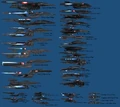
Size chart of playable and non-playable refits of earlier Starfleet ships from pre-2409 STO.

Size chart of playable and non-playable new build Starfleet ships from pre-2409 STO.
Size chart of playable and non-playable refits of earlier Starfleet ships from post-2410 STO.

Size chart of playable and non-playable new build Starfleet ships from post-2410 STO.

Size chart of playable and non-playable starships of Alliance aligned factions of the 26th to 32nd centuries.

Recognition and size chart for Starfleet ships in 2411 STO.
For a key and notes on the player-made charts see here .
Procurement [ | ]
Most new ships can be purchased on Earth Spacedock from Lieutenant Laurel in Ship Requisitions, on Deep Space K-7 from Lt. Commander Dant Kroll in the Shipyard, and on Deep Space 9 from Eclia in the docking ring.
New vessels come with standard equipment and weapons, but players may wish to upgrade this immediately by purchasing items of a higher mark before undertaking missions. Better equipment can usually be found on the exchange , or purchased with Energy Credits or Dilithium from vendors.
See also [ | ]
- 2 List of canon starships
- 3 Playable starship

Galaxy class
The Galaxy -class was a Starfleet heavy capital ship class first introduced in the mid 2360s . It was one of the largest and most powerful Federation starship classes of its time, with many serving in the Dominion War . Starfleet had previously operated another type of Galaxy -class starship in the 2250s . ( TNG : " The Ensigns of Command ")
- 1.1 Design and development
- 1.2 Early years
- 1.3 Dominion War
- 1.4 Later status
- 1.5 Alternate timelines
- 2.1 Physical arrangement
- 2.2 Command and control systems
- 2.3.1 Upgrades
- 2.4.1 Upgrades
- 2.5.1 Upgrades
- 2.6 Crew support
- 3.1.1 Upgrades
- 3.2 Observation lounge
- 3.3 Battle bridge
- 3.4 Main engineering
- 3.5.1 Sickbay
- 3.5.2 Medlabs
- 3.5.3 Surgical suite
- 3.5.4 Emergency bio-support unit
- 3.5.5 Physical rehabilitation bay
- 3.5.6 Morgue
- 3.5.7 Counselor's office
- 3.6.1 Stellar cartography
- 3.6.2 Cybernetics lab
- 3.6.3 Arboretum
- 3.6.4 Cetacean labs
- 3.7.1 Transporter rooms
- 3.7.2.1 Embarked craft
- 3.7.3 Cargo bays
- 3.8 Crew quarters
- 3.9.1 Ten Forward
- 3.9.2 Holodeck
- 3.9.3 Phaser range
- 3.9.4 Gymnasium
- 3.9.5 Theater and concert hall
- 3.9.6 Salon
- 3.9.7 Relaxing area
- 3.9.8 Replicating center
- 3.10 Educational facilities
- 4 Ships commissioned
- 5.1 Appearances
- 5.2.1 Studio model
- 5.2.2 Designing the bridge
- 5.2.3 Technical Manual
- 5.3 Apocrypha
- 5.4 External links
History [ ]
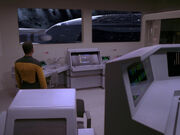
Utopia Planitia design lab, with a Galaxy -class starship under construction outside the window
Design and development [ ]
The Galaxy Class Starship Development Project took place at the Utopia Planitia Fleet Yards . ( TNG : " Booby Trap ", " Eye of the Beholder ") Numerous technologies implemented on Galaxy -class starships were tested aboard earlier prototype vessels, including the Oberth -class USS Pegasus in the 2350s . ( TNG : " The Pegasus ")
The warp core was designed at Outpost Seran T-1 on stardate 40052 by some of the most brilliant engineering minds in the Federation, including Leah Brahms of the Theoretical Propulsion Group . ( TNG : " Booby Trap ")
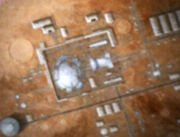
Galaxy -class ship under construction at Utopia Planitia
Major component construction of Galaxy -class ships was carried out both in orbit and at ground based facilities. ( TNG : " Booby Trap ", " Parallels ")
Although the Star Trek: The Next Generation Technical Manual portrays a long, multi-decade design and construction of Galaxy -class ships, " Booby Trap " and " Eye of the Beholder " seem to suggest that this timeline was much faster, as the warp core design was finalized just one year prior to the launch of the Enterprise -D. The ship itself was still under major construction one year prior to " Encounter at Farpoint ".
Upon its launch, the Galaxy -class had become the most technologically sophisticated and complicated ship ever built by the Federation. ( TNG : " Encounter at Farpoint ", " Lonely Among Us ", " Contagion ")
Early years [ ]

A starboard view
Service aboard a Galaxy -class starship was considered an extremely prestigious assignment with 91% of Starfleet Academy graduates not posted on their first assignment, and they attracted some of Starfleet's finest officers. ( TNG : " Ménage à Troi ", " Ensign Ro "; VOY : " Relativity ") They were noted for their impressive abilities among Federation citizens and other Alpha Quadrant races. ( TNG : " Tin Man ", " Chain Of Command, Part I "; DS9 : " Valiant "; VOY : " Infinite Regress "; Star Trek Generations ) Some Galaxy -class ships were able to house large civilian populations; many assigned personnel even brought their families aboard to live with them. ( TNG : " When The Bough Breaks ", " Disaster ", " New Ground ", " Imaginary Friend ")
In 2365 , the safety of the Galaxy -class, in particular its warp propulsion system , came into question when the USS Yamato was lost in a mysterious accident near the Romulan Neutral Zone claiming the lives of all personnel and their families. The ship had experienced massive system-wide failures which eventually led to a loss of antimatter containment . Further investigation revealed the malfunctions were the result of an Iconian software transmission and not a design flaw inherent to the ship. ( TNG : " Contagion ")
Undoubtedly the most prominent early Galaxy -class starship was the Federation flagship USS Enterprise -D , which, apart from two brief periods under the commands of William T. Riker and Edward Jellico , was commanded for its entire service history by Captain Jean-Luc Picard . The Enterprise -D made first contact with a multitude of new species, including the Q Continuum and the Borg Collective . Its diplomatic efforts helped cool tensions between smaller, regional powers and prevent dramatic upheavals to the security of the Federation during the Klingon Civil War , and frequently checked Romulan and Cardassian operations in tense situations. It fought off some of the Federation's toughest foes, most notably preventing the assimilation of Earth during the Borg invasion of 2367 . ( Star Trek: The Next Generation )
Dominion War [ ]
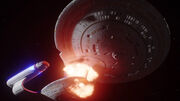
The USS Odyssey critically damaged
A Galaxy -class ship was involved in the disastrous first contact with the Dominion . The USS Odyssey had entered the Gamma Quadrant in order to rescue several Federation citizens who had been taken captive by the Jem'Hadar . While the Odyssey was retreating, a Jem'Hadar attack ship made a suicide run at its stardrive section , causing a massive hull breach and resulting in the complete destruction of the ship. ( DS9 : " The Jem'Hadar ") This act marked the beginning of three years of hostilities between the Federation and the Dominion, culminating in the outbreak of the Dominion War .
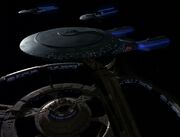
Venture docked at Deep Space 9, with a pair of Excelsior -class ships in the background
Galaxy -class starships saw action in many of the major fleet actions of the war including Operation Return , where ships of the class played a tactical role as leaders for Galaxy -wing squadrons , ( DS9 : " Sacrifice of Angels ") the First Battle of Chin'toka , ( DS9 : " Tears of the Prophets ") and the Battle of Cardassia . ( DS9 : " What You Leave Behind ")
Analysis of the battle from " Sacrifice of Angels " showed no less than ten Galaxy -class vessels in the combined Federation fleet during Operation Return. This would indicate that there were more than the initial six Galaxy -class starships referenced in the Star Trek: The Next Generation Technical Manual . The total of six ships stems from Roddenberry's assumption that Starfleet would not have constructed vessels of that large a size in substantial numbers. The Manual however also states that an additional six space frames were constructed and laid up to be completed at a moment when circumstances so dictated.
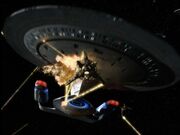
The USS Galaxy takes on an orbital weapon platform in the First Battle of Chin'toka
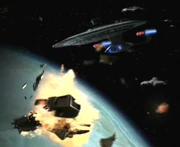
The Venture destroys a deactivated orbital weapon platform (2374)
Later status [ ]
Several more starships entered the fleet inventory during the 2370s . Several Galaxy -class ships were shown under construction at Utopia Planitia . ( TNG : " Parallels "; VOY : " Relativity ") By the latter half of the decade, Galaxy -class ships were seen all around Federation space, from stations near Earth where a number of Galaxy -class ships were part of the fleet assembled to intercept a Borg sphere in 2378 , to ships operating near the Romulan Neutral Zone . ( VOY : " Endgame "; Star Trek Nemesis )
By 2399 , a hologram of a Galaxy -class vessel was occasionally displayed at the ceiling of Starfleet Headquarters . ( PIC : " Maps and Legends ")
In 2401 , the rebuilt USS Enterprise -D was pressed back into service by her old command crew after the Borg compromised the rest of Starfleet. ( PIC : " Võx ")
Alternate timelines [ ]
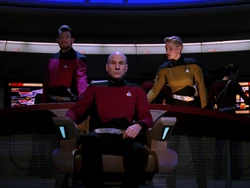
Picard in the sole chair in the alternate timeline
In an alternate timeline 2366 , in which the United Federation of Planets was at war with the Klingon Empire , the Enterprise -D was the Federation's first Galaxy -class warship . It featured 42 decks and was capable of transporting over 6,000 troops. Though the vessel's exterior appearance was similar if not identical to that of the vessel in the normal timeline, there were interior changes. The ship's bridge was darkly lit, while Ten Forward featured much brighter lighting. Certain features, such as the captain's chair , possessed a more militaristic appearance, and this chair was not surrounded by seats for the first officer and an additional officer. ( TNG : " Yesterday's Enterprise ")
In an alternate future , refitted Galaxy -class ships remained in service long after 2370, although some attempts had been made to decommission them. ( TNG : " All Good Things... ")
Technical data [ ]
Physical arrangement [ ].
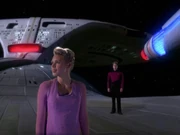
Amanda Rogers and Q standing on the hull of a Galaxy -class ship, near the stern
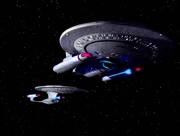
Nebula - and Galaxy -class starships
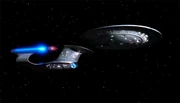
Saucer separation in progress
The Enterprise -D had an overall length of 641 meters, an overall width of 473 meters, and an overall height of 133 meters. The gross vehicle mass of this ship was 5,000,000 metric tons. The ship had a standard crew complement of 1,012 persons, with a maximum evacuation capacity of 15,000 persons. The environmental standard on the ship was equivalent to M-class . The maximum sustainable speed was warp 9.2 and the maximum rated speed was 9.8. ( TNG : " New Ground " okudagram )
Andrew Probert had originally wanted to make the Galaxy -class exactly 2,000 feet long, but the final design is slightly longer because Gene Roddenberry asked him to lengthen the nacelles in order to match the traditional Enterprise proportions more closely. [1] (X) The vast majority of informed sources state that the Galaxy -class is 2,108 feet (642.5 meters) long, including Ed Whitefire's unpublished blueprints which were created with the help of the Star Trek art department. [2] [3]
The design included two hull sections: a saucer-shaped primary hull , and a detachable secondary hull which housed the ship's primary engines. They could be reversibly separated and were both equipped with independent flight and combat capabilities. Generally, civilians and non-essential personnel would evacuate to the saucer module , while the senior staff confronted a threat in the battle section , which contained the majority of weapons systems. ( TNG : " Encounter at Farpoint ") The saucer was able to withstand a crash landing on a planetary surface. ( Star Trek Generations ) However, in dire situations, the saucer section could still be used in combat. ( TNG : " The Best of Both Worlds, Part II ")
Although children appeared to be evacuated from the star drive section in Generations , Ronald D. Moore commented: " I believe the children were actually being rushed to their "crash stations" or "emergency stations" or something, not being brought up from the battle section. The same goes for the patients in sickbay. " ( AOL chat , 1997 )
The interior space of the Galaxy -class was left somewhat customizable; areas such as Deck 8 were designated as unfinished and multipurpose, in the event that extra space was needed for a specific mission. ( TNG : " Liaisons ")
According to the Star Trek: The Next Generation Technical Manual , when the Enterprise -D was initially launched from Utopia Planitia, a full 35% of the customizable space was left empty, to be later filled with individual modules as seen fit.
Command and control systems [ ]
The computer system on board the Galaxy -class was isolinear -based. ( TNG : " The Naked Now ") Computer systems were concentrated in a computer core , which was accessible through a maintenance room. ( TNG : " Contagion ", " Evolution ", " The Bonding ") There was a starboard computer core. ( TNG : " The Nth Degree ") Each Galaxy -class vessel carried a total of three independent computer cores; two located in the saucer section and one in the engineering section.
According to the Star Trek: The Next Generation Technical Manual , all of the ship's essential computer processing functions may be handled by a single core.
Propulsion systems [ ]
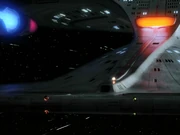
Impulse engine (aft torpedo launcher is also visible)
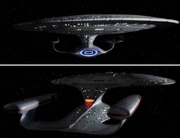
Traveling on impulse power only
Galaxy -class ships achieved warp flight through two warp nacelles, which housed multiple pairs of warp coils . ( TNG : " Eye of the Beholder ") The warp core was one of the most powerful in Starfleet, generating approximately 12.75 billion gigawatts of power. ( TNG : " True Q ") The efficiency of the warp drive could be tweaked to a point where it rivaled the new USS Intrepid in 2370. ( TNG : " Force of Nature ") The warp core spanned twelve decks in the engineering hull. The deuterium tanks were above the core, while antimatter storage pods surrounded the base of the core on Deck 42. ( TNG : " Liaisons ")
The acceleration delay between slow-reverse impulse and top warp speed, or about warp 9, was 0.300 milliseconds . ( TNG : " The Last Outpost ") Warp speeds above 9.3 were beyond the red line. The maximum warp speed was warp 9.6, which could be maintained for a few hours. ( TNG : " Encounter at Farpoint ", " The Best of Both Worlds ") It was also possible to achieve warp 9.65. ( TNG : " Q Who ") Warp 9.8 was also achievable in theory, but at extreme risk. ( TNG : " Encounter at Farpoint ") As of the year 2366, the USS Enterprise -D, a Galaxy -class vessel, was known to have been the fastest ship in Starfleet. ( TNG : " Tin Man ")
There were three impulse engines , two on the saucer section and one in the stardrive section. In early ships, only the impulse engine in the stardrive section was usually active. ( TNG : " Encounter at Farpoint ")
Upgrades [ ]

The navigational deflector dish of a Galaxy -class starship. Also seen is the forward torpedo launcher and ventral phaser array
Upgrades to the propulsion systems were tested in 2370 aboard the Enterprise -D; the ship received a new warp core manufactured with interphase technology. ( TNG : " Phantasms ") A major overhaul of the nacelles was also conducted that year. ( TNG : " Eye of the Beholder ") By the mid 2370s, most Galaxy -class ships began operating with all three impulse engines activated. ( DS9 : " Favor the Bold ", " Tears of the Prophets "; VOY : " Timeless ")
Scientific systems [ ]
Galaxy -class ships supported a wide variety of scientific equipment and laboratories studying many different disciplines. ( TNG : " Liaisons ") The departments often had to compete for limited resources such as sensor time, which were allocated by the operations officer or, on occasion, the executive officer . ( TNG : " Lessons ")
In addition to sensors, Galaxy -class ships were equipped with a variety of probes and scientific devices that could be launched from the torpedo launchers. These included basic scanner probes and reconnaissance probes , class-A probes and probes from class-1 to class-5 . ( TNG : " Where Silence Has Lease ", " Force of Nature ", " Ship In A Bottle ", " Chain Of Command, Part I ") The ships were also equipped with a number of space buoys including the basic stationary beacons , warning buoys and emergency buoys . ( TNG : " Where Silence Has Lease ", " Identity Crisis ", " Descent, Part II ")
Sensor systems could be customized and upgraded as necessary for a specific mission. Additional equipment could be added as required. ( TNG : " Cause And Effect ", " Schisms ") The latest technologies were generally outfitted to Galaxy -class ships as they left the experimental stages. ( TNG : " All Good Things... ")
Tactical systems [ ]
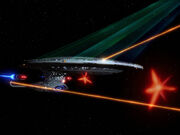
A Galaxy -class starship fires its phasers and photon torpedoes
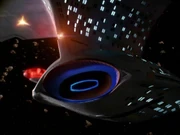
A Galaxy -class starship's forward torpedo launcher
Aft torpedo launcher on a Galaxy -class vessel
The Galaxy -class was equipped with twelve phaser banks , distributed in phaser arrays at various points along both hulls. One array was located on the dorsal of the battle section and could only be used following a separation. Multiple phaser beams could be fired simultaneously from a single array. ( DS9 : " Sacrifice of Angels ") There were also fore and aft torpedo launchers on the engineering section. ( TNG : " Conundrum ") Each launch tube was capable of firing at least five photon torpedoes simultaneously, each torpedo capable of being independently targeted. ( TNG : " The Arsenal of Freedom ", " Yesterday's Enterprise ") In the 2360s , Galaxy -class ships typically carried about 250 photon torpedoes. The torpedo launchers were also capable of launching probes. The Galaxy -class also carried antimatter mines and supported a high-capacity deflector shield grid. ( TNG : " Chain Of Command, Part II ", " Conundrum ")
While "Conundrum" establishes that there were only ten phaser banks aboard the ship, a visual inspection shows twelve arrays and effects in " The Best of Both Worlds " and " Darmok " have established extra emitters on the nacelle pylons and in the forward torpedo launcher. Schematics of the Enterprise created by Rick Sternbach include an aft-firing launcher on the saucer section, [4] but this launcher was not incorporated to the filming model. The Star Trek: The Next Generation Technical Manual states that ten torpedoes can be launched simultaneously from a launcher and 275 torpedoes are usually carried by the ship. The script of " Conundrum " also uses the figure 275, instead of the 250 mentioned on-screen. [5] In TNG : " Preemptive Strike ", Ro stated there was a weakness in the aft shields where the impulse exhaust destabilized them, but this appeared to be a ruse, as Captain Picard gave the order to let Ro's ship come through.
Additionally, the engineering crew of the Enterprise -D discovered a way to convert the main deflector dish of the Galaxy -class into a beam weapon of unprecedented power. This weapon was successfully tested against a Borg cube in 2367 and possessed enough firepower that the Borg cube would likely have been destroyed in a single shot had it not been for the fact that, with the assimilation of Jean Luc Picard, the Borg had managed to preemptively adapt to the frequency of the energy. Initial usage of the weapon burned out the main deflector dish and required the crew of the Enterprise -D to spend several hours conducting repairs. However, the only other time the weapon was used, it appeared not to have caused any of the system damage that it had previously been observed to cause, though it was not fired for the same length of time. ( TNG : " The Best of Both Worlds, Part II ", " Night Terrors ")
The Venture with the additional arrays
Certain Galaxy -class ships, such as the USS Venture , were fitted with additional phaser arrays on the dorsal surfaces of their nacelles. ( DS9 : " The Way of the Warrior ")
The additional phasers were originally designed for the modified four-foot Enterprise -D model in TNG : " All Good Things... ". The "bumps" containing the phaser arrays on the Venture were rotated a full one-hundred eighty degrees from those on the Enterprise -D. The Venture was the only ship seen with these weapons; none of the CGI Galaxy -class ships used exclusively since the fifth season of DS9 (including the Venture itself) had these weapons.
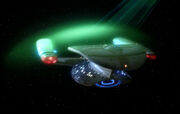
The deflector shields of a Galaxy -class starship's secondary hull
The Enterprise -D received weapons systems upgrades in 2370, including a loadout of higher-yield photon torpedoes and enhanced targeting sensors programmed by Lieutenant Worf . ( TNG : " Genesis ")
Crew support [ ]
While Starfleet policy permitted the immediate family of officers and crew to stay aboard starships prior to the advent of the Galaxy -class, it was the first class specifically tailored to accommodate civilian as well as Starfleet personnel. ( TNG : " Encounter at Farpoint ") Civilians were allowed to hold varying positions in the science division aboard the Galaxy -class. ( TNG : " Night Terrors ")
Regarding the presence of families on starships, Ronald D. Moore commented " Perhaps [still] on some Galaxy -class ships, but I think this was an experiment that failed. " ( AOL chat , 1997 ) " I think that the "family friendly" starship notion was an interesting idea, but one that didn't pan out. There was always something awkward about Picard ordering the ship into battle situations with kiddies running through the corridors. And no matter how much lip service we paid to the "our families are part of our strength" concept, it never seemed very smart or very logical to bring the spouse and kids along when you're facing down the Borg, or guarding the Neutral Zone, or plunging the ship into uncharted spatial anomalies. " ( AOL chat , 1997 )
Interior design [ ]
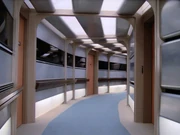
A typical saucer section corridor
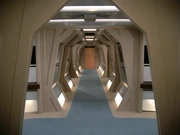
A corridor in the engineering section
The predominant color scheme of the corridors aboard possessed blue carpeting on the corridor floors and silver-blue wall paneling.
In Star Trek Generations , the interior lighting scheme of the Enterprise -D was noticeably darkened.
Main bridge [ ]
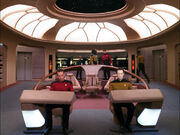
The main bridge circa 2366
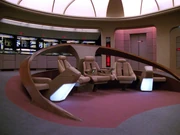
Aft bridge section
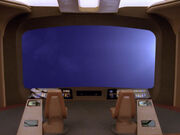
The ops and conn consoles
The main bridge of the Galaxy -class was located on Deck 1 of the saucer section . Different Galaxy -class starships had different bridge designs. The following describes the bridge design used in at least two Galaxy -class starships, including the USS Enterprise -D.
The theory of different bridge designs for different Galaxy -class starships comes from the Star Trek: The Next Generation Technical Manual . In DS9 : " The Jem'Hadar ", the USS Odyssey featured a completely different bridge design from that of the USS Enterprise -D.
The forward bulkhead was dominated by the main viewscreen . Directly aft of this were the operations officer and conn positions. At the very center of the room was the command area – the captain's chair at the center, flanked by chairs for the first officer to the right, and an additional officer (typically the ship's counselor or chief medical officer ) to the left. Each of these command stations included consoles for shipboard systems access. Smaller backless seats were located on the edges of the command area, for other officers to sit, should the need arise.
In the pilot, as well as early in the first season, the forward bridge consoles did not seem to be dedicated specifically to either helm control or operations since Data , the operations officer, can be seen in both the left and right stations at different times. The console seats were also more reclined in earlier seasons, but became more upright in later seasons.
It should be noted that helm control could either be operated from the left or right forward stations, or in some cases from the tactical station. It also should be noted that the operations console was capable of communications, scanning, and course navigation.
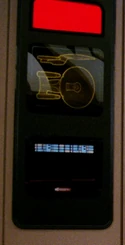
A replicator on the bridge
The tactical console, positioned directly behind the captain, was located in the wooden handrail that encircled the rear half of the central command area. The aft bulkhead carried several additional consoles. These could be customized as needed, ( TNG : " Chain Of Command, Part I ") and were reconfigured at least twice. In 2364 , the consoles, from starboard to port, were Science I, Science II , Propulsion , Emergency Manual Override , and Environment . By 2365, they were Science I, Science II, Mission Ops , Environment, and Engineering . The stations featured pullout seats below the console, which were normally flush with the panel below the stations. The bridge was also equipped with two food replicators . ( citation needed • edit )
In Star Trek: Bridge Commander , the " tactical " console was reconfigured for engineering and sciences.
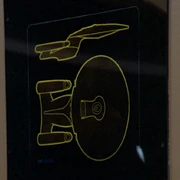
A wall-mounted diagram of the Enterprise -D, located near the ready room
By necessity, the bridge had easy access to and from all other important areas of the ship. In all, there were six doors leading from the room. Moving clockwise from the main viewscreen , the first door, level with and to the right of the conn, led directly to the battle bridge emergency turbolift . At the rear right of the bridge, a shallow alcove contained two doors, one of which led to a head, the other to a corridor leading to the observation lounge . The door at the rear left of the room opened onto a standard turbolift. Continuing around, the fifth door led into the captain's ready room , the sixth to another turbolift. ( TNG : " Encounter at Farpoint ")
As the main bridge housed so many critical systems, numerous emergency environmental and power backups were included so that duty personnel could continue to work for up to 72 hours in the event of a major shutdown or incapacitation of the vessel. ( citation needed • edit ) Other safeguards included seven redundant safety interlocks to prevent the life support from being turned off on the bridge. ( TNG : " Brothers ")
During production on Star Trek: The Next Generation , the set of the Enterprise -D bridge was situated on Paramount Stage 6 for the first season but was moved to Paramount Stage 8 for the second season , where it continued to be housed through the rest of the series.
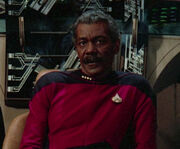
Another version of the Galaxy -class bridge
The USS Yamato 's bridge had a very similar configuration to the Enterprise -D bridge. ( TNG : " Where Silence Has Lease ", " Contagion ")
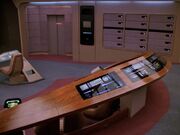
The security station, integrated in the wooden handrail
The bridges of Galaxy -class ships were subject to several minor cosmetic changes over their first decade of service. Aboard the USS Enterprise -D, these could be seen as early as 2365, the starship's second year of service. The computer access panels on the port and starboard walls were replaced; pin-striping was added to the tactical console bulkhead behind the captain's chair; the reclined conn and ops seats were replaced with upright versions; the cushioned end seats were removed from the command area; the "flip-open" captain's chair consoles were replaced with permanently open units; and the direction of the viewscreen beacon was reversed. ( TNG : " The Child ") Several changes were also made to the bridge's carpeting in subsequent years.

The bridge in 2371
The Enterprise -D bridge's first major refit came in 2371. Six new stations were added, three on each side of the bridge replacing the equipment lockers. The aft stations were accordingly reprogrammed and moved to different locations. The three starboard stations were designated Science I, II, and III. Science IV became the first aft station, followed by Mission Ops, Environment, and Engineering I/II. The port side of the bridge had three communications stations , consoles which were not common to the bridges of 24th century ships. In addition, the command chairs were raised two steps above the helm and ops stations, to provide the captain with an unobstructed view of the forward viewscreen. New carpeting and handrails were also added. ( Star Trek Generations )
Observation lounge [ ]
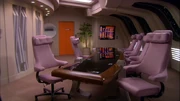
The observation lounge
The observation lounge was located directly aft of the main bridge. The room was usually used as a conference room for the vessel's senior staff. It featured large, aft-facing windows that offered a spectacular view of the back of the starship and space beyond. A conference table with seating for ten people was the main feature of the room, ( TNG : " Encounter at Farpoint ") with LCARS screens on the port and starboard walls for information displays and retrieval. ( TNG : " The Child ") Holographic emitters embedded within the table could also be used for presenting data. ( TNG : " The Last Outpost ") Some starships featured artwork along the wall opposite the windows; when this was not present the bare wall showed several structural supports. ( TNG : " Darmok ")
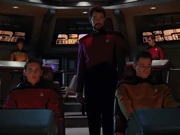
The battle bridge
Battle bridge [ ]
The battle bridge was located on Deck 8 and was connected to the main bridge and other vital areas of the ship by an emergency turbolift. It was designed to control the stardrive section following a saucer separation. Unlike the main bridge, there was much more focus on combat and tactical systems and no science stations. The battle bridge was modular, like the main bridge; at least two variants have been seen aboard Galaxy -class ships. ( TNG : " Encounter at Farpoint ", " The Arsenal of Freedom ", " The Best of Both Worlds, Part II ")
The battle bridge also had an auxiliary turbolift located on Deck 17, according to TNG : " Heart of Glory ".
Main engineering [ ]
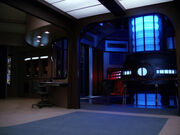
Main engineering, with the warp core visible
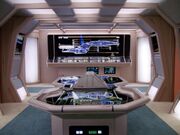
The "pool table" and the MSD
Engineering systems spanned twelve decks of the engineering section. Engineering itself was located on Deck 36, ( TNG : " Liaisons ") and was an open-plan facility, directly accessible from the corridor. Consisting of two levels, it provided direct access to the vessel's warp core and primary engineering support systems. The corridor bulkhead housed the Master Situation Monitor . Inside the main section, the master systems display was the operational focus of the room. Beyond this, heading towards the warp core, the chief engineer 's office and several support consoles were located on the left, and the assistant chief engineer's console on the right. These formed part of the bulkhead protecting the main part of engineering from the warp core. Access to the upper level, a circular area surrounding the warp core, was provided by a ladder to the left of the warp core or an elevator on the right. The upper level had access to other warp core maintenance systems. ( TNG : " The Dauphin ", " The Best of Both Worlds, Part II ")
Engineering could also serve as a backup to the main bridge if it was damaged or disabled. ( TNG : " Brothers ")
In the event of a major failure, such as an imminent warp core breach, engineering was equipped with isolation doors and force fields to contain various sections of the facility, usually to seal off the warp core prior to detonation or ejection. ( TNG : " The Best of Both Worlds ", " Violations "; Star Trek Generations )
Medical facilities [ ]
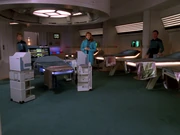
Intensive care unit
The Galaxy -class medical department was charged with providing health care to the ship's company and all attached personnel.
Sickbay [ ]
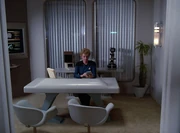
The CMO's office
There were at least three sickbay wards aboard the ship, ( TNG : " Tapestry ") with at least one in the saucer section ( TNG : " Genesis ") and another in the stardrive section. ( TNG : " The Arsenal of Freedom ") There were four recovery biobeds on the periphery of the room with a main surgical biobed opposite them, covered by a large overhead sensor cluster and capable of hookup to a surgical support frame . Equipment storage and various control panels were located throughout sickbay. The chief medical officer 's office was a small space just off the main sickbay, with desk and workspace for the CMO. A small foyer connected the office to the sickbay; it contained a replicator terminal.
Separate, private recovery rooms were also located near sickbay, ( TNG : " Ethics ") as was a nursery ( TNG : " Home Soil ", " Data's Day ") and a diagnostic center. ( TNG : " Transfigurations ")
A Galaxy -class sickbay also had the facilities to isolate parasitic protoviruses . ( TNG : " Brothers ")
In an alternate timeline caused after the USS Enterprise -C traveled from 2344 to 2366 via a temporal rift , there was a null-G ward of sickbay. ( TNG : " Yesterday's Enterprise ")
Medlabs [ ]
Galaxy -class ships had at least four medical laboratories of varying sizes. There was a small laboratory accessible through the foyer outside the chief medical officer's office where minor experiments run by on-duty personnel could be monitored. ( TNG : " Home Soil ", " Evolution ", " Clues ", " The Game ") Other larger medlabs similar to standard science labs were elsewhere. ( TNG : " Ethics ")
Surgical suite [ ]
Surgeries too complicated for the sickbay ward could be conducted in a separate surgical area which had a large variety of bio-support systems. ( TNG : " Ethics ")
Emergency bio-support unit [ ]
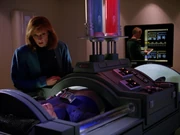
The emergency bio support unit
There was a separate room located near the main sickbay facility on Deck 12 that contained the emergency bio-support unit. Patients with severe burn injuries could be treated here in a closed cell. ( TNG : " Transfigurations ")
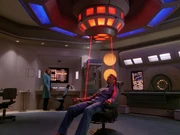
The physical rehabilitation bay in use
Physical rehabilitation bay [ ]
Similar in size and design of the room housing the emergency bio support unit, this space was used for the physical rehabilitation of patients in sickbay. Several weights were available in racks as well various scanners, including the prominently placed unit located in the center of the ceiling. ( TNG : " Transfigurations ")
A morgue facility with storage slots for several bodies was located adjacent to sickbay. ( TNG : " Man Of The People ", " Suspicions ", " Night Terrors ")
Counselor's office [ ]
The ship's counselor had their own office, located on Deck 9. Crew members needing emotional support could meet in private with the counselor here. ( TNG : " The Icarus Factor ", " The Price ", " Realm Of Fear ", " Man Of The People ", " Dark Page ")
Scientific department [ ]
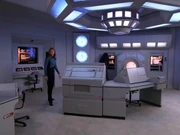
A science lab
The Galaxy -class starship housed over one hundred ( citation needed • edit ) separate scientific research labs . Very few of the research labs remained under the same discipline of science for more than six months. ( citation needed • edit ) Most shared the same design; only a few had extremely specialized equipment.
Stellar cartography [ ]
Stellar cartography was located on Deck 9. There were at least two laboratories based there; one, a smaller facility similar to the other labs aboard the ship ( TNG : " Lessons "); another, a much larger cylindrical room spanning three decks. The walls of the room were designed to be a three-dimensional display. ( Star Trek Generations )
Cybernetics lab [ ]
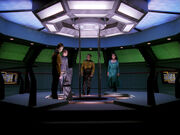
Cybernetics lab
Aboard the Enterprise -D, the cybernetics lab was a circular room, with a raised platform in its center containing a shell which could hold a cybernetic body. The entire assembly could retract into the ceiling and was directly controlled by a console to the side. There were additional wall-mounted consoles throughout the room. ( TNG : " The Offspring ", " The Best of Both Worlds, Part II ") Another laboratory was of a rectangular design, although it still featured the shell assembly. ( TNG : " I Borg ")
Arboretum [ ]
The arboretum was capable of studying and supporting a wide variety of plant life, and also doubled as a social area. ( TNG : " Night Terrors ", " Imaginary Friend ", " Dark Page ")
Cetacean labs [ ]
The Galaxy -class starship carried a complement of cetaceans . Among the crew, these facilities were also known as "the dolphin tanks" ( TNG : " The Perfect Mate ") or the "aquatic lab." ( TNG : " Genesis ")
In an alternate timeline, these facilities were also known as Cetacean Ops. ( TNG : " Yesterday's Enterprise ")
These labs are shown in the saucer section in the Star Trek: The Next Generation USS Enterprise NCC-1701-D Blueprints and are mentioned in the Star Trek: The Next Generation Technical Manual . While the area itself was unfortunately never seen on the show, their existence has been confirmed in dialogue.
Transport and cargo [ ]
Transporter rooms [ ].
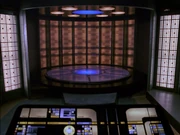
Transporter room
Galaxy -class starships had twenty transporter rooms located throughout the vessel. ( TNG : " 11001001 ") Four transporter rooms were located on Deck 6 in the saucer section, ( TNG : " The Game ") while two more were on Deck 14 in the stardrive section. ( TNG : " Encounter at Farpoint ")
Shuttlebays [ ]
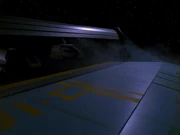
Main shuttlebay, external view
There were three shuttlebays aboard each Galaxy -class starship, supporting many varieties of shuttlecraft . The main shuttlebay was located on Deck 4 in the saucer section. It was so massive that an explosive decompression of the air within the bay would contain enough force to propel the ship forward. ( TNG : " Cause And Effect ") Two smaller bays, Shuttlebays 2 and 3 , were on Deck 13 in the engineering hull. ( TNG : " The Next Phase ")
Galaxy -class starships were equipped with five hangars, Hangars 1 , 2 , 3 , 4 , and 5 , for the overhauling , refitting , testing, and storage of auxiliary craft. ( TNG : " Evolution ", display graphic )
The main shuttlebay would have been prohibitively expensive to build as an actual set, and was only seen in miniature form during " Cause And Effect ". During the first few seasons of Star Trek: The Next Generation , Shuttlebays 2 and 3 were erroneously shown on Deck 11.
Embarked craft [ ]
- Type 6 shuttlecraft ( TNG : " Darmok ")
- Type 7 shuttlecraft ( TNG : " Coming of Age ")
- Type 15 shuttlepod ( TNG : " Time Squared ")
- Danube -class runabout ( DS9 : " Emissary "; TNG : " Timescape ")
- Captain's yacht
Cargo bays [ ]
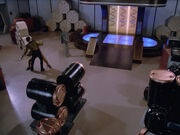
A typical cargo bay
There were numerous multi-level cargo bays located all throughout the ship. Most of these bays contained sufficient room for storage, cargo transporters, and anti-grav units for the transportation of cargo. ( TNG : " The Hunted ", " Hollow Pursuits ") Cargo bay four was the only cargo bay with direct access to the exterior hull. ( TNG : " Power Play ", " Disaster ")
Crew quarters [ ]
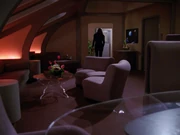
Standard officers' quarters
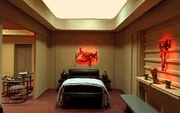
Junior officers' quarters
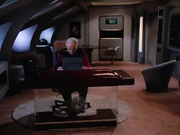
Luxurious VIP quarters
Crew quarters on the Galaxy -class were located throughout both the saucer section and the engineering hull. ( TNG : " Imaginary Friend "; Star Trek Generations ) Pets, including cats and dogs , were also allowed aboard ship. ( TNG : " Data's Day ")
There were several types of crew quarters aboard:
- Junior officers' quarters – These small-unit quarters were located on the interior of the ship and lacked windows. They were comprised of a living area, a bedroom, and a bathroom. Crewmembers of lieutenant junior grade were given their own quarters; ensigns were required to share quarters. ( TNG : " Lower Decks ") The living area contained a replicator terminal and was customizable with a variety of furniture and decorations.
- Officers' quarters – These quarters lined the edge of the saucer section and contained a living area, a bedroom, and a bathroom area. ( TNG : " Schisms ", " Frame of Mind ", " Genesis ", " Relics ") They were generally reserved for lieutenant commanders and above. Similar quarters were also available to enlisted and civilian personnel with families. ( TNG : " The Wounded ")
- Captain's quarters – The captain's quarters, located on Deck 8, were similar to the officers' quarters but were slightly larger. The captain had a large desk area and work terminal. VIP and diplomatic guest quarters shared the same layout. ( TNG : " Too Short A Season ", " Sarek ")
Recreational facilities [ ]
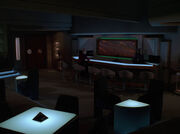
The Ten Forward lounge
Ten Forward [ ]
Located at the forward-most section of the saucer module on Deck 10 (deck 10, forward section one), Ten Forward served as the social center of the ship. It had a battery of recreational games including three-dimensional chess as well as a fully stocked bar which carried syntheholic beverages. The replicators were also able to produce other food and drinks for the crew to enjoy in a relaxed social setting. Its large, panoramic windows permitted a staggering view of the ship's passage through space. ( TNG : " The Child ", " Power Play ")
To date, Ten Forward has only been shown on board the Enterprise -D. However, there is no evidence that it was not a feature of every Galaxy -class ship. Given the extended duration of their missions, it is likely that designers included this feature on her sister ships to serve their recreational and social needs as well. In the novel The Return , Ten Forward is replaced by "Shuttlebay Four" aboard the USS Challenger . The novel Resistance establishes that before leaving the USS Enterprise -E for the USS Titan , Commander Riker named the ship's bar lounge the "Happy Bottom Riding Club," which was a name Worf absolutely hated and refused to use under any circumstances.
Holodeck [ ]
The Galaxy -class carried sixteen holodecks , which were located on Decks 9, 10, and 11. ( TNG : " 11001001 ", " Homeward ")
Phaser range [ ]
The phaser range was located on Deck 12. A person stood on a platform in the center of the room, illuminated only by the light which came from above the platform. Colored circular lights, approximately the size of a Human hand, whirled across the walls, and the person aimed and fired at selected targets. After completing a round, the number of hits and misses, along with the percentage of accuracy, were tallied by the ship's computer. There were at least fifteen levels of difficulty, and the range could be customized for two-player competition.
The phaser range was also used by security officers to train personnel in marksmanship. ( TNG : " A Matter Of Honor ", " Redemption II ")
Gymnasium [ ]
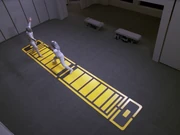
The fencing room

The racquetball court
The gymnasium , which was also on Deck 12, contained a variety of recreational equipment for a variety of sports. In addition to aerobic studios ( TNG : " The Price ") and martial arts areas, ( TNG : " Clues ", " Man Of The People ", " Second Chances ", " Lower Decks ") there was a parrises squares area, ( TNG : " Second Chances ") a squash court, ( TNG : " Suddenly Human ") and an anbo-jytsu court. ( TNG : " The Icarus Factor ") The gymnasium also featured a fencing room. Aboard the Enterprise -D, Captain Picard typically fenced with fellow crewmembers. ( TNG : " We'll Always Have Paris ", " I Borg ", " Lessons ")
Theater and concert hall [ ]
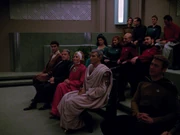
The theater and concert hall
There was a large theater aboard, which was equipped to seat large groups of people. The theater could also be used as a concert hall for musical performances by crew members. ( TNG : " Sarek ", " Frame of Mind ")
The theater set was a reuse of the Ten Forward set.
The salon was an area where crewmembers could get personal care ranging from a simple haircut to an elaborate spa treatment. ( TNG : " Data's Day ", " The Host ", " Schisms ")
Relaxing area [ ]
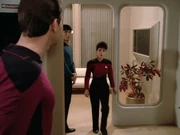
A relaxing area
Relaxing areas were open rooms which were used by crewmembers to meet and talk. They were equipped with a couch , plants , and a viewscreen. ( TNG : " Encounter at Farpoint ")
This type of room only appeared in "Encounter at Farpoint" and was a reuse of the sickbay office set.
Replicating center [ ]
At the replicating center , crewmembers could replicate items which were too large or complicated for a standard food replicator terminal. They could "shop" for certain items by reviewing the fabrication database. ( TNG : " Data's Day ")
Educational facilities [ ]
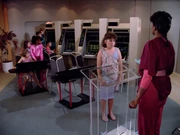
A small school
There were several small schools of varying sizes located throughout the ship, ranging from actual classrooms ( TNG : " When The Bough Breaks ") to specialized workshops. ( TNG : " Imaginary Friend ", " Rascals ", " Masks ")
Ships commissioned [ ]
- USS Challenger (NCC-71099)
- USS Enterprise (NCC-1701-D)
- USS Galaxy (prototype, NCC-70637)
- USS Odyssey (NCC-71832)
- USS Syracuse (NCC-17744)
- USS Venture (NCC-71854)
- USS Yamato (NCC-71807)
- Unnamed Galaxy -class starships
- Hanson's starship
- USS Madison
- USS Magellan
Appendices [ ]
Appearances [ ].
- " The Neutral Zone " ( model )
- " Where Silence Has Lease "
- " Contagion "
- " Booby Trap " (model)
- " Parallels "
- Star Trek Generations
- Star Trek: First Contact (model)
- Star Trek Nemesis (model)
- " Emissary "
- " The Nagus " (model)
- " The Jem'Hadar "
- " The Way of the Warrior "
- " Paradise Lost " (model)
- " Doctor Bashir, I Presume "
- " Call to Arms "
- " Favor the Bold "
- " Sacrifice of Angels "
- " You Are Cordially Invited "
- " The Reckoning "
- " Tears of the Prophets "
- " Image in the Sand "
- " What You Leave Behind "
- " Non Sequitur " (model)
- " In the Flesh " (wall display)
- " Timeless "
- " Relativity "
- " The Voyager Conspiracy " (database image)
- " Endgame "
- ENT : " These Are the Voyages... "
- " Remembrance " (dream sequence)
- " Maps and Legends " (holographic image)
- " The Star Gazer " (commemorative plaque)
- " The Next Generation " (model/painting/poster art)
- " The Last Generation "
- " The Spy Humongous " (illusory interior)
- " Crisis Point 2: Paradoxus " (display graphic)
- " Trusted Sources " (display graphic, mural)
- " Parth Ferengi's Heart Place " (model)
- " Starstruck " (digital image)
- " Kobayashi " (hologram only)
Background information [ ]
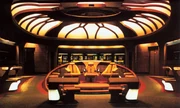
The refitted Enterprise -D bridge in Generations
The Galaxy -class starship was first (and mostly) seen as the USS Enterprise -D. It was designed by Andrew Probert. Interiors were supervised by Herman Zimmerman in both the first season of TNG and Star Trek Generations , and by Richard James for the intervening six seasons.
Technical specifications for the Galaxy -class were visible on a display in the conference lounge of the Enterprise -D beginning with the episode TNG : " Chain Of Command, Part I ".
A Galaxy -class starship appears in the series finale of all four Star Trek spin-offs; the Enterprise -D appears in "All Good Things" and "These Are the Voyages", while unnamed Galaxy -class ships appear in "What You Leave Behind" and "Endgame".
Studio model [ ]
Designing the bridge [ ].
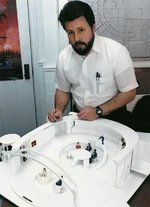
Probert with foam-core mockup
Andrew Probert made a series of drawings refining the new look for the Enterprise 's bridge. An early writers' bible for the new series described the new bridge as combining " the features of ship control, briefing room, information retrieval area, and officers' wardroom. In other words, much the same kinds of things happen here as in the old bridge, but with less emphasis on the mechanics of steering the starship. "
That new, less mechanistic approach can be seen in the preliminary designs featuring viewing couches and a conference table on the bridge.
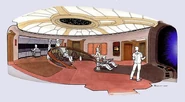
Technical Manual [ ]
The Star Trek: The Next Generation Technical Manual and the Star Trek: The Next Generation USS Enterprise NCC-1701-D Blueprints show that the Galaxy -class was equipped with a third aft torpedo launcher in the saucer section that was exposed upon the separation. This launcher however did not appear on the filming model.
The Technical Manual (pp 177-178) features several preliminary designs of a ship class that would one day replace the Galaxy -class as the primary explorer ship of the fleet. One of the designs for the Nova -class was a down-sized ship with much less internal volume that allowed each ship to be refitted for specific mission types. A smaller ship of this class first appeared on screen in VOY : " Equinox ", though it was identified only as a class designed for short-term planetary research missions in the episode. In alternative futures seen in VOY : " Endgame " and ENT : " Azati Prime " the Nova -class is seen in long-term deep space assignment and battle ship roles as well.
The Star Trek: Deep Space Nine Technical Manual lists the class' statistics as follows:
- Type: Explorer
- Production Base: ASDB Integration Facility, Utopia Planitia Fleet Yards, Mars
- Accommodation: 1,012 officers and crew; 200 visiting personnel; 15,000 personal evacuation limit
- Power Plant: One 1,500+ Cochrane warp core feeding two nacelles ; one impulse system in stardrive section , two impulse systems in saucer section
- Length: 642.51 meters
- Beam: 463.73 meters
- Height: 195.26 meters
- Mass: 4,500,000 metric tons
- Performance: Warp 9.6 for 12 hours (standard); warp 9.9 for 12 hours (uprated)
- Armament: Eleven type-X phaser emitters; two photon torpedo launchers
Apocrypha [ ]

A Galaxy -class ship in Star Trek: Legacy
The 2001 Star Trek: Deep Space Nine Calendar depicted the Galaxy -class USS Ronald D. Moore (NCC-70564) docked at Deep Space 9 . According to Gary Hutzel , this ship was named after both Vice Admiral Ronald D. Moore and " a certain writer on a 20th century show. " [6]
In the novel The Buried Age , set between the destruction of the USS Stargazer and Picard assuming command of the Enterprise -D, while on his first mission with Picard, Data discovers an attempt to implant a quantum virus in Starfleet computers that would introduce multiple subtle faults in the plans for the Galaxy -class as a means of discouraging future space exploration. While removing these errors would delay development of the Galaxy -class for a year or so compared to the original plans, Data's actions earn him an award for commendation for preventing the sabotage, and he is assured that he will have a place on one such ship when they go into service.
In the Star Trek: Armada series of computer games, the Galaxy -class is referred to as a battleship in gameplay. On screen, the USS Enterprise -D has been casually referred to as a battleship in TNG : " Yesterday's Enterprise " and " All Good Things... ". However, these instances take place in alternate timelines and it is not known if "battleship" is an actual starship type within Starfleet. In the episode TNG : " Conundrum ", the Galaxy -class Enterprise -D was described as a battleship, based on her specifications.
In Peter David's New Frontier line of novels, Captain Calhoun and crew are given a Galaxy -class replacement for the lost Ambassador -class USS Excalibur . It is notable for also possessing a designation as the Excalibur -A, something only previously seen with Kirk's USS Enterprise .
In the Star Trek: Typhon Pact novel Rough Beasts of Empire , Benjamin Sisko assumes command of the Galaxy -class USS Robinson ( β ). The Robinson also appears in Plagues of Night .
Several Galaxy -class starships have been mentioned in novels and games:
The Galaxy -class (along with five sub-classes) is also seen in the game Star Trek Online , first obtainable when the player reaches a rank of Captain under the classification of "Exploration Cruiser". There's also a special version, the "Exploration Cruiser Refit", at that same rank that gives players the ability to use Antimatter Spread, confusing opponents visually. A third version appears at Vice Admiral-level which gives players the ability to use Saucer Separation. The modified version from " All Good Things... " is also available for Vice Admiral-level players, and is referred to as a "Federation Dreadnought Cruiser."
External links [ ]
- Galaxy -class at Memory Beta , the wiki for licensed Star Trek works
- Galaxy -class at Wikipedia
- The Saucer Rim on the Galaxy -class at Ex Astris Scientia : contains articles on the differences in appearances between the older and newer miniatures
- Designing The Next Generation Enterprise at Forgotten Trek
- Designing the Enterprise -D at the Federation Starship Datalink
- 2 Bell Riots
- 3 Daniels (Crewman)
Screen Rant
Star trek: what is the most powerful starfleet ship.

Your changes have been saved
Email is sent
Email has already been sent
Please verify your email address.
You’ve reached your account maximum for followed topics.
Star Trek's New Warp Drive Breaks the Prime Directive in a Way No-One Expected
I don't care if modern star trek breaks established canon, star trek isn’t supposed to have money: what is latinum.
Determining the most powerful starships in Star Trek depends on the different eras (and timelines) of the franchise although the 23rd and 24th century of the Prime Universe offers a great deal of data about Starfleet's vessels. Star Trek: Discovery season 3 and 4's 32nd century has presented much less information about the Federation's starships so far, but it's still possible to make an educated guess about which ship is top of the line.
Technology never stops being upgraded in Star Trek as new innovations from the brightest minds of the United Federation of Planets and adjacent alien races and factions continually evolve starship design and capability. Star Trek is mainly broken up into the following eras: the 22nd century of Star Trek: Enterprise where Captain Jonathan Archer's NX-01 Enterprise was Earth's first Warp 5-capable starship. The 23rd-century era mainly centers on Captain James T. Kirk's (William Shatner) Constitution -class USS Enterprise , although the USS Excelsior was more powerful . The 24th century highlights the two versions of the Enterprise commanded by Captain Jean-Luc Picard (Patrick Stewart), Captain Benjamin Sisko's (Avery Brooks) USS Defiant , which was built to fight the Borg, and Captain Kathyrn Janeway's (Kate Mulgrew) USS Voyager. The USS Discovery-A , now led by Captain Michael Burnham (Sonequa Martin-Green), is exploring the 32nd century. However, there is also the Mirror Universe and the alternate Kelvin Timeline of J.J. Abrams' Star Trek movies to consider as well.
Related: Star Trek: Every Captain's First Ship (& How The Earned Command)
Star Trek: Picard season 1 was set in 2399 and introduced USS Zheng He , under the command of Captain William Riker (Jonathan Frakes). Riker called the Zheng He "the toughest, fastest, most powerful ship Starfleet ever put into service." Taking the Captain at his word, the Inquiry -class Zheng He has exceeded the two starships commanded by Captain Picard, the Enterprise-D and E . In Star Trek: The Next Generation , the Galaxy -class Enterprise-D was the pinnacle of Starfleet. The flagship of the Federation could travel at warp 9.6. The Sovereign -class Enterprise-E was even faster and more powerful, with a top warp speed of 9.995. While its specs and full capabilities haven't been revealed, Starfleet fully invested in the Inquiry class in Star Trek: Picard 's era because Captain Riker commanded an entire squadron of starships identical to the Zheng He .
It's harder to determine what the most powerful Starfleet ship of the 32nd century is since most of them were only fleetingly seen in Star Trek: Discovery season 3. The Crossfield -class USS Discovery was almost 1,000 years old and outdated when it arrived in 3188 but Starfleet retrofitted the vessel with 32nd-century upgrades and rechristened it the USS Discovery-A . The tech included detached warp nacelles and programmable matter. However, Discovery also has an ace-in-the-hole: its one-of-a-kind spore displacement hub drive that allows the starship to instantaneously jump to any location. The spore drive is an advantage that makes Discovery more powerful than any Starfleet ship regardless of warp speed capabilities or the number of photon torpedoes and phaser banks it's armed with.
In J.J. Abrams's Star Trek movies, the Constitution -class USS Enterprise was the newest and most powerful ship in Starfleet when it launched and came under the command of Captain James T. Kirk (Chris Pine). However, by Star Trek Into Darkness , the Dreadnought -class USS Vengeance was far larger and more powerful as the pinnacle of Admiral Alexander Marcus' (Peter Weller) vision of a militarized Starfleet. In the Mirror Universe of the 23rd century, the ISS Charon was the throne-ship of Emperor Philippa Georgiou (Michelle Yeoh) and it was the symbol of the Terran Empire's might, although it was destroyed by the USS Discovery. In the 24th-century Mirror Universe, the Defiant was a game-changer in the Terrans' fight to defeat the Klingon-Cardassian Alliance.
Ultimately, despite the major conflicts the Federation has waged, Starfleet is dedicated to the pursuit of scientific exploration, not war. Other races like the Klingons, the Romulans, and the Borg may develop deadlier ships and weapons but when the Federation is threatened, Starfleet always rises to the occasion, and Star Trek outdoes itself with more powerful starships to meet the challenge as necessary.
Next: Star Trek: All 9 Times The Enterprise Was Destroyed
- SR Originals
- Star Trek: Discovery (2017)

IMAGES
COMMENTS
Invincible-class The Invincible-class was the single largest multi-mission combat-equipped starship ever constructed by Starfleet. She was designed as the ultimate in front line explorers. She was classified as a Fleet Carrier-Command Battleship. Invincible-class ships combine the roles of battleship and fighter carrier, having a massive offensive capability in terms of on-board weapons and ...
Pre-Federation Starships (to 2161) 1px = 1m • Updated 2022-05-09 Federation Starships (2161-2300) 1px = 1m • Updated 2023-07-03 Federation Starships (2300-2400) 1px = 1m • Updated 2024-07-02 Ships of the Alpha/Beta Quadrants 1px = 1m • Updated 2024-08-05 Ships of the Gamma/Delta Quadrants 1px = 1m • Updated 2024-07-12 Large Starships and Stations ...
The largest Starfleet starship to appear anywhere on screen is the upgraded Enterprise-J briefly seen in the episode "Azati Prime".It's described as being "almost 2 miles" in length (i.e. 3.2 kilometers) as compared to Borg cubes which are approx. 3 kilometers in length along each edge.The single largest constructed vessel we see in the Trek TV show is the "Voth City Ship" which measures 9 ...
Appeared In Star Trek: Deep Space Nine (9 Episodes) Appeared In Star Trek: First Contact The Akira Class of Federation Starships is a mighty one, and unlike most starships under Federation control ...
This time-traveling Romulan mining ship is arguably the most significant ship in the Star Trek universe. In the 2009 Star Trek film, the Narada launches an attack on the USS Kelvin, and prompts ...
The starships of Star Trek are some of the most powerful in all sci-fi, armed with powerful weapons and great designs. ... D'deridex-class Warbirds were massive vessels that dwarfed some of the largest ships the Federation put to space. Powered by a forced quantum singularity, these battlecruisers were armed to the teeth with multiple disruptor ...
Or perhaps it's the captain and crew at the helm? We believe it's all of those things and more, so we took 46 of the most noteworthy Star Trek starships and placed them in a head-to-head battle. Which iconic ship came out on top? Find out below. Warp ahead for our rankings of the most powerful Star Trek ships ever.
The following is a list of starship classes operated by the Federation. Because of the strong connotations with the real world United States Navy, Star Trek: The Original Series Producers Gene Roddenberry and Robert H. Justman (a World War II navy veteran himself) had imbued Starfleet with (The Making of Star Trek, p. 112, et al.; These Are the Voyages: TOS Season One, 1st ed, pp. 28-29; see ...
The Starship Enterprise is Star Trek's greatest ship, and amazing new fan art compares the sizes of the USS Enterprise throughout the generations. Star Trek: The Original Series' USS Enterprise NCC-1701 was the first Starship Enterprise seen by fans until Star Trek: The Next Generation introduced the USS Enterprise-D. In the decades since, prequels like Star Trek: Enterprise and Star Trek ...
In the Star Trek franchise, the Klingon Empire makes use of several classes of starships.As the Klingons are portrayed as a warrior culture, driven by the pursuit of honor and glory, the Empire is shown to use warships almost exclusively and even their support ships, such as troop transports and colony ships, are armed for battle. This contrasts with the exploration and research vessels used ...
NX-01, main setting of Star Trek: Enterprise. Registry: Enterprise Class: NX Service: 2151-2161 (10 years) Captain: Jonathan Archer (Scott Bakula) United Earth Starfleet's Enterprise is the main setting of Star Trek: Enterprise (2001-2005). Enterprise was the first Earth-built starship capable of reaching Warp 5.The ship was commanded by Captain Jonathan Archer and played an instrumental ...
Star Trek: The Magazine. "Warship Voyager". Vaskan (Fictional) 351 m. Estimate based on structural comparison to Intrepid Class. Cruiser (Type 1) Vidiian Sodality. 500 m. Official Starships Collection.
For those of us who lovingly refer to ourselves as "starship nerds," Star Trek's 24th century is populated with an astounding array of Starfleet vessels for us to gaze upon with awe.The series and films set in this era, namely Star Trek: The Next Generation, Star Trek: Deep Space Nine, Star Trek: Voyager, Star Trek: Picard, and the four movies helmed by the TNG crew, produced vast fleets ...
Sci-fi. Star Trek. The Negh'Var warship was the largest class of cruiser known to operate in the Klingon Empire during the late 24th century. In early 2372, the IKS Negh'Var was announced as the new flagship of the Klingon Imperial Fleet. Commanded by a changeling posing as General Martok, he led the Klingon...
8. USS Discovery NCC-1031. Across the Federation's entire history, the USS Discovery NCC-1031 rates as the most unique starship, thanks to its Spore Drive. A sentient set of spores within the ...
Apart from starbases and shuttles (which are both massively oversized, the starbases have recently stopped being so stupid (only about 1.5x), but DS9 and K7 remain grotesquely oversized, and shuttles are all to scale with each other, just up-scaled quite a lot compared to ships so you can actually see them), ships are actually scale accurate to each other (with ships like the Defiant (which ...
Reman Warbird is indeed considered one of the most powerful ships in Star Trek. 19. Jem'Hadar Battleship. This was the largest ship in the fleet of Dominion, a very frightening ship that everyone was afraid of, which tells us how great the power of Jem'Hadar warships is.
There is a wide variety of Federation playable starships currently available in Star Trek Online for Starfleet, DSC Starfleet and TOS Starfleet characters. Most Federation ships are also available to Starfleet-aligned Romulan Republic and Dominion characters. There are three specific types of starship (if carriers are attributed to one of the pre-existing types), and each starship has multiple ...
Check out some of the biggest ships in the Star Trek universe, we cover the Enterprise J, Earth Spacedock, the Voth City Ship and the Whale Probe. Subscribe ...
A list of starships by: Andorian starships Borg starships Cardassian starships Dominion starships Earth starships Federation starships Ferengi starships Klingon starships Romulan starships Vulcan starships Category:Starships for a full listing of all starships Star Trek Ships: Expanded - Others...
The Galaxy-class was a Starfleet heavy capital ship class first introduced in the mid 2360s. It was one of the largest and most powerful Federation starship classes of its time, with many serving in the Dominion War. Starfleet had previously operated another type of Galaxy-class starship in the 2250s. (TNG: "The Ensigns of Command") The Galaxy Class Starship Development Project took place at ...
The Star Trek franchise features many spacecraft. Various space vessels make up the primary settings of the Star Trek television series, films, and expanded universe; others help advance the franchise's stories. Throughout the franchise's production, spacecraft have been depicted by numerous physical and computer-generated models. Producers worked to balance often tight budgets with the need ...
Star Trek is famous for having one of the largest and most detailed fleets of spaceships of any science-fiction franchise but the number of ships in the Starfleet has changed with every era. The Star Trek brand has endured for over half of a century since the first series aired in 1966. The series was originally designed as a parable for the social issues of the time, such as nuclear ...
Riker called the Zheng He "the toughest, fastest, most powerful ship Starfleet ever put into service." Taking the Captain at his word, the Inquiry -class Zheng He has exceeded the two starships commanded by Captain Picard, the Enterprise-D and E. In Star Trek: The Next Generation, the Galaxy -class Enterprise-D was the pinnacle of Starfleet.